Nikon 1252EA Wireless Transmitter User Manual H1405UM JP En 01 0126
Nikon Corporation Wireless Transmitter H1405UM JP En 01 0126
Nikon >
(Short-Term Confidential) User Manual

User's Manual
Wireless Transmitter
En
• Read this manual thoroughly before using the camera.
• To ensure proper use of the camera, be sure to read “For
Your Safety” (page v).
• After reading this manual, keep it in a readily accessible
place for future reference.
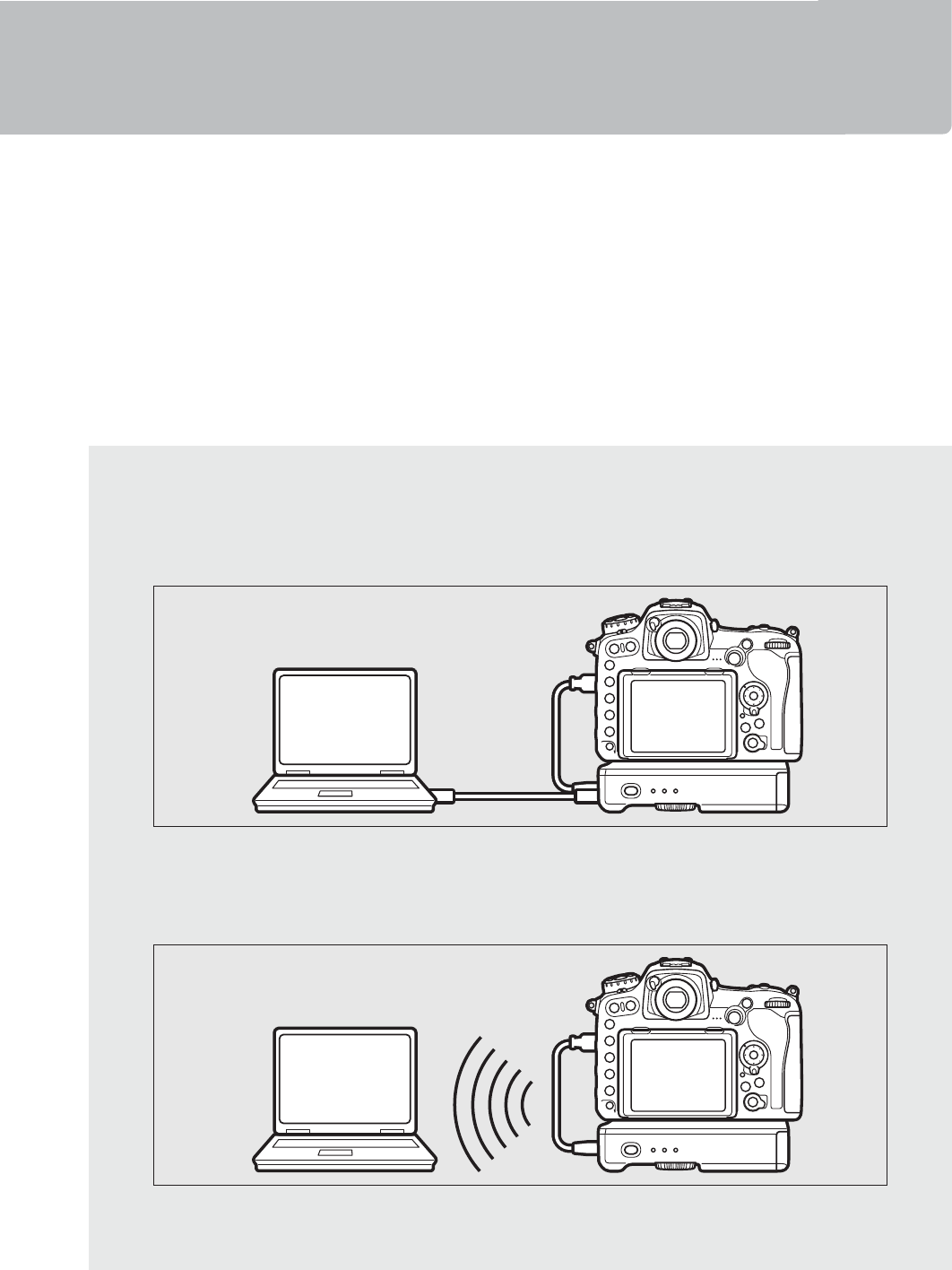
ii
What the WT-7 Can Do for You
What the WT-7 Can Do for You
This manual describes how to attach the WT-7 to the camera and
connect the camera to a computer, ftp server, or other device over
Ethernet or wireless networks. It also describes the operations that
can be performed once a connection is established.
Before connecting the WT-7, confirm that the firmware for the camera
and WT-7 have been updated to the latest version. For more
information, visit the websites listed on page xvi.
Model Name: WT-7 (N1504) Model Name: WT-7A (N1534)
Model Name: WT-7B (N1535) Model Name: WT-7C (N1536)
Before using the WT-7 network function, connect the camera to
a network.
Ethernet Networks
For information on connecting to a computer, see page 10.
For information on connecting to an ftp server, see page 58.
Wireless Networks
For information on connecting to a computer, see page 18.
For information on connecting to an ftp server, see page 65.
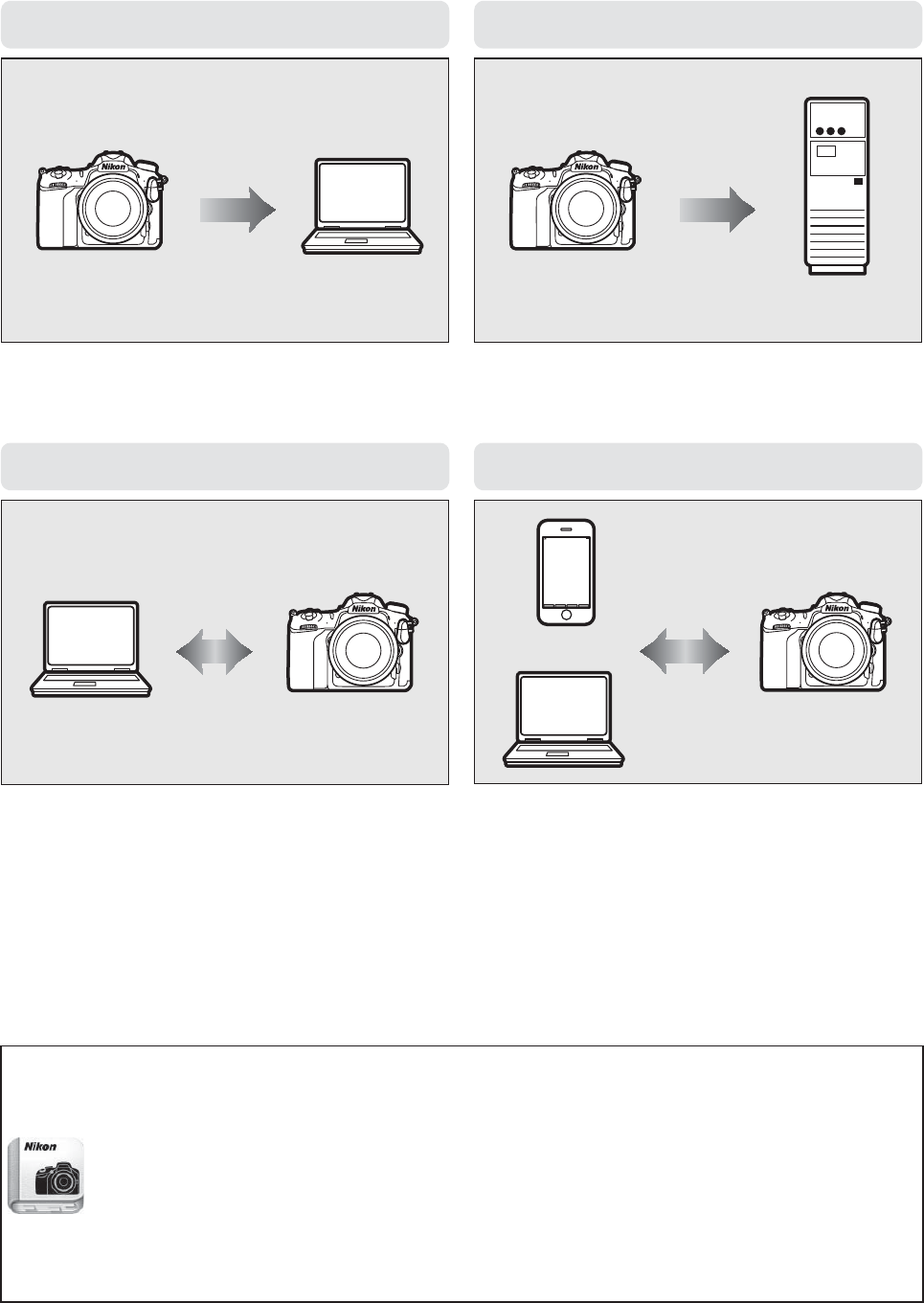
iii
What the WT-7 Can Do for You
Once a network connection has been established, you can:
Upload existing photos and movies
Take or browse photos remotely
Nikon User Support for India and Australia
Contact a Nikon representative for technical assistance with the operation
of your Nikon product or products. For information on the Nikon
representatives in your area, visit http://www.nikon-asia.com/support.
Nikon Manual Viewer 2
Install the Nikon Manual Viewer 2 app on your smartphone or tablet
to view Nikon digital camera manuals, anytime, anywhere.
Nikon
Manual Viewer 2 can be downloaded free of charge from the App
Store and Google Play.
Download of the app and any product
manuals requires an Internet connection, for which fees may be
levied by your phone or Internet service provider.
Image Transfer (032) FTP Upload (078)
Computer ftp server
Camera Control (037) HTTP Server (040)
Camera Control Pro 2
Smart device
Computer
iv
What the WT-7 Can Do for You
Trademark Information
IOS is a trademark or registered trademark of Cisco Systems, Inc., in the
United States and/or other countries and is used under license. Windows
is either a registered trademark or a trademark of Microsoft Corporation in
the United States and/or other countries. Mac, OS X, iPhone, and iPad are
registered trademarks of Apple Inc. in the United States and/or other
countries. XQD is a trademark of Sony Corporation. The SD, SDHC, and
SDXC logos are trademarks of the SD-3C, LLC. All other trade names
mentioned in this manual or the other documentation provided with this
Nikon product are trademarks or registered trademarks of their respective
holders.
Memory Cards
Throughout this manual, XQD and SD memory cards are referred to as
“memory cards”.
Apple Public Source License
This product includes Apple mDNS source code that is subject to the
terms of the Apple Public Source License located at URL
http://developer.apple.com/opensource/.
This file contains Original Code and/or Modifications of Original Code as
defined in and that are subject to the Apple Public Source License Version
2.0 (the ‘License’). You may not use this file except in compliance with the
License. Please obtain a copy of the License at
http://www.opensource.apple.com/license/apsl/ and read it before using
this file.
The Original Code and all software distributed under the License are
distributed on an ‘AS IS’ basis, WITHOUT WARRANTY OF ANY KIND, EITHER
EXPRESS OR IMPLIED, AND APPLE HEREBY DISCLAIMS ALL SUCH
WARRANTIES, INCLUDING WITHOUT LIMITATION, ANY WARRANTIES OF
MERCHANTABILITY, FITNESS FOR A PARTICULAR PURPOSE, QUIET
ENJOYMENT OR NON-INFRINGEMENT. Please see the License for the
specific language governing rights and limitations under the License.

v
For Your Safety
For Your Safety
To prevent damage to your Nikon product or injury to yourself or to
others, read the following safety precautions in their entirety before using
this equipment. Keep these safety instructions where all those who use
the product will read them.
The consequences that could result from failure to observe the
precautions listed in this section are indicated by the following symbol:
❚❚ WARNINGS
ADo not disassemble
Touching the product’s internal parts could result in injury. In the event of
malfunction, the product should be repaired only by a qualified
technician. Should the product break open as the result of a fall or other
accident, remove the battery and/or AC adapter and then take the
product to a Nikon-authorized service center for inspection.
ATurn off immediately in the event of malfunction
Should you notice smoke or an unusual smell coming from the
equipment, immediately unplug the AC adapter and remove the battery,
taking care to avoid burns. Continued operation could result in injury.
After removing the battery, take the equipment to a Nikon-authorized
service representative for inspection.
ADo not use in the presence of flammable gas
Do not use electronic equipment in the presence of flammable gas, as this
could result in explosion or fire.
AKeep dry
Do not immerse in or expose to water or rain. Failure to observe this
precaution could result in injury or product malfunction due to fire or
electric shock.
ADo not handle with wet hands
Failure to observe this precaution could result in electric shock.
ADo not handle the power cable or go near the charger during thunderstorms
Failure to observe this precaution could result in electric shock.
This icon marks warnings, information that should be read before
using this Nikon product to prevent possible injury.
A
vi
For Your Safety
AKeep out of reach of children
Failure to observe this precaution could result in injury. In addition, note
that small parts constitute a choking hazard. Should a child swallow any
part of this equipment, consult a physician immediately.
ADo not remain in contact with the wireless transmitter, battery, or charger for extended
periods while the devices are on or in use
Parts of the device become hot. Leaving the device in direct contact with
the skin for extended periods may result in low-temperature burns.
ADo not leave the product where it will be exposed to extremely high temperatures, such
as in an enclosed automobile or in direct sunlight
Failure to observe this precaution could cause damage or fire.
AObserve proper precautions when handling batteries
Batteries may leak, overheat, rupture, or catch fire if improperly handled.
Observe the following precautions when handling batteries for use in this
product:
•Use only batteries approved for use in this equipment.
•Do not short or disassemble the battery.
•Do not expose the battery or the device in which it is inserted to powerful
physical shocks.
•Be sure the product is off before replacing the battery. If you are using an
AC adapter, be sure it is unplugged.
•Do not attempt to insert the battery upside down or backwards.
•Do not expose the battery to flame or to excessive heat.
•Do not immerse in or expose to water.
•
Replace the terminal cover when transporting the battery. Do not transport or
store the battery with metal objects such as necklaces or hairpins.
•Batteries are prone to leakage when fully discharged. To avoid damage to
the product, be sure to remove the battery when no charge remains.
•When the battery is not in use, attach the terminal cover and store in a
cool, dry place.
•The battery may be hot immediately after use or when the product has
been used on battery power for an extended period. Before removing the
battery turn the wireless transmitter off and allow the battery to cool.
•Discontinue use immediately should you notice any changes in the
battery, such as discoloration or deformation.
AUse appropriate cables
When connecting cables to the input and output jacks, use only the cables
provided or sold by Nikon for the purpose to maintain compliance with
product regulations.
AFollow the instructions of airline and hospital personnel

vii
Notices
Notices
•
No part of the manuals included with this product may be reproduced,
transmitted, transcribed, stored in a retrieval system, or translated into any
language in any form, by any means, without Nikon’s prior written permission.
•Nikon reserves the right to change the appearance and specifications of the
hardware and software described in these manuals at any time and without
prior notice.
•Nikon will not be held liable for any damages resulting from the use of this
product.
•While every effort has been made to ensure that the information in these
manuals is accurate and complete, we would appreciate it were you to bring
any errors or omissions to the attention of the Nikon representative in your
area (address provided separately).
This product is controlled by the United States Export Administration
Regulations (EAR). The permission of the United States government is not
required for export to countries other than the following, which as of this
writing are subject to embargo or special controls: Cuba, Iran, North Korea,
Sudan, and Syria (list subject to change).
The use of wireless devices may be prohibited in some countries or regions.
Contact a Nikon-authorized service representative before using the wireless
features of this product outside the country of purchase.
Copyright
Comply with copyright notices. Under copyright law, photographs or recordings
of copyrighted works made with the camera can not be used without the
permission of the copyright holder. Exceptions apply to personal use, but note
that even personal use may be restricted in the case of photographs or
recordings of exhibits or live performances.
CAUTION
RISK OF EXPLOSION IF BATTERY IS REPLACED BY AN INCORRECT TYPE.
DISPOSE OF USED BATTERIES ACCORDING TO THE INSTRUCTIONS.
Security
Although one of the benefits of this product is that it allows others to freely
connect for the wireless exchange of data anywhere within its range, the
following may occur if security is not enabled:
•Data theft: Malicious third-parties may intercept wireless transmissions to
steal user IDs, passwords, and other personal information.
•Unauthorized access: Unauthorized users may gain access to the network
and alter data or perform other malicious actions. Note that due the design
of wireless networks, specialized attacks may allow unauthorized access
even when security is enabled.
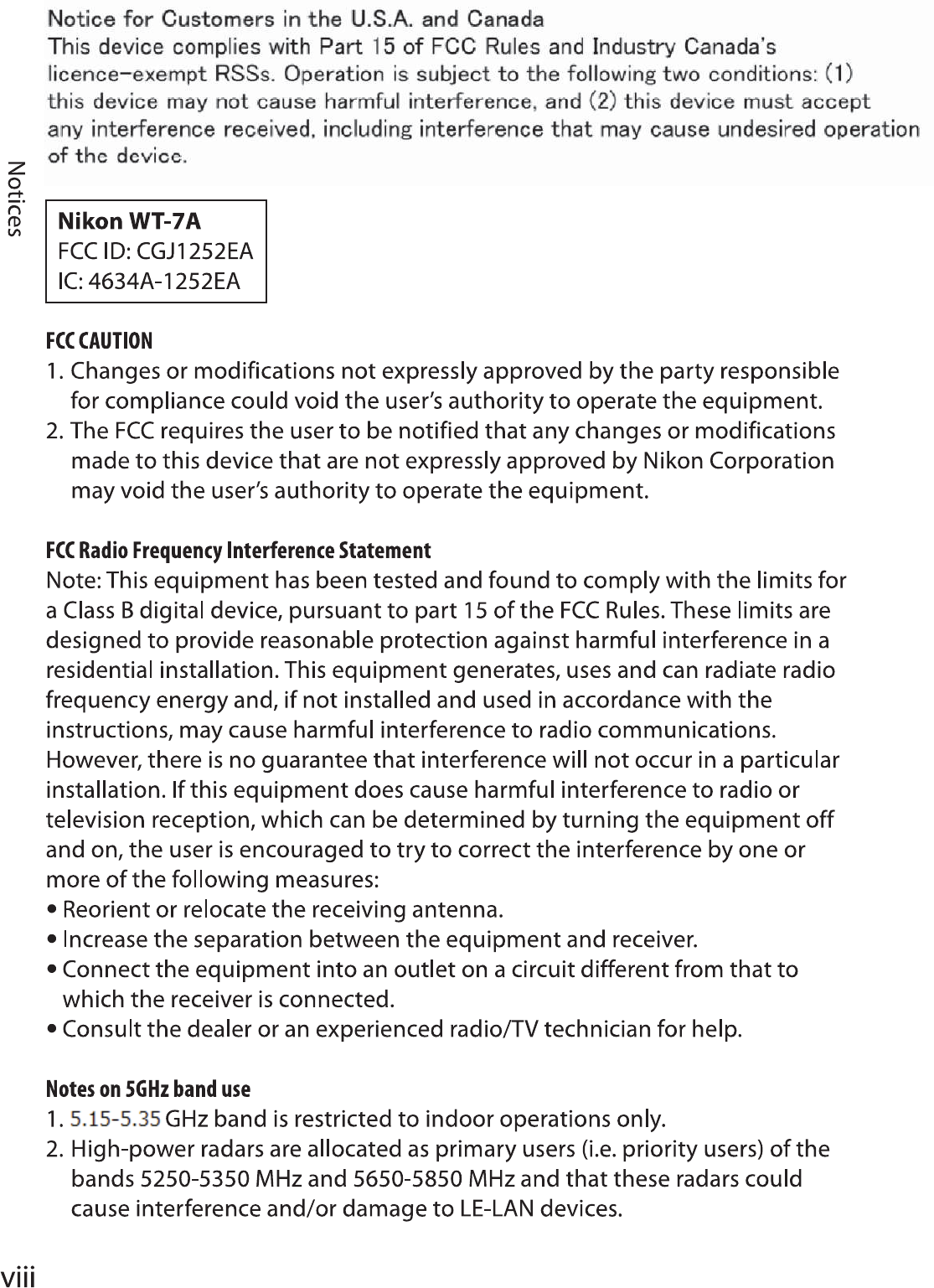
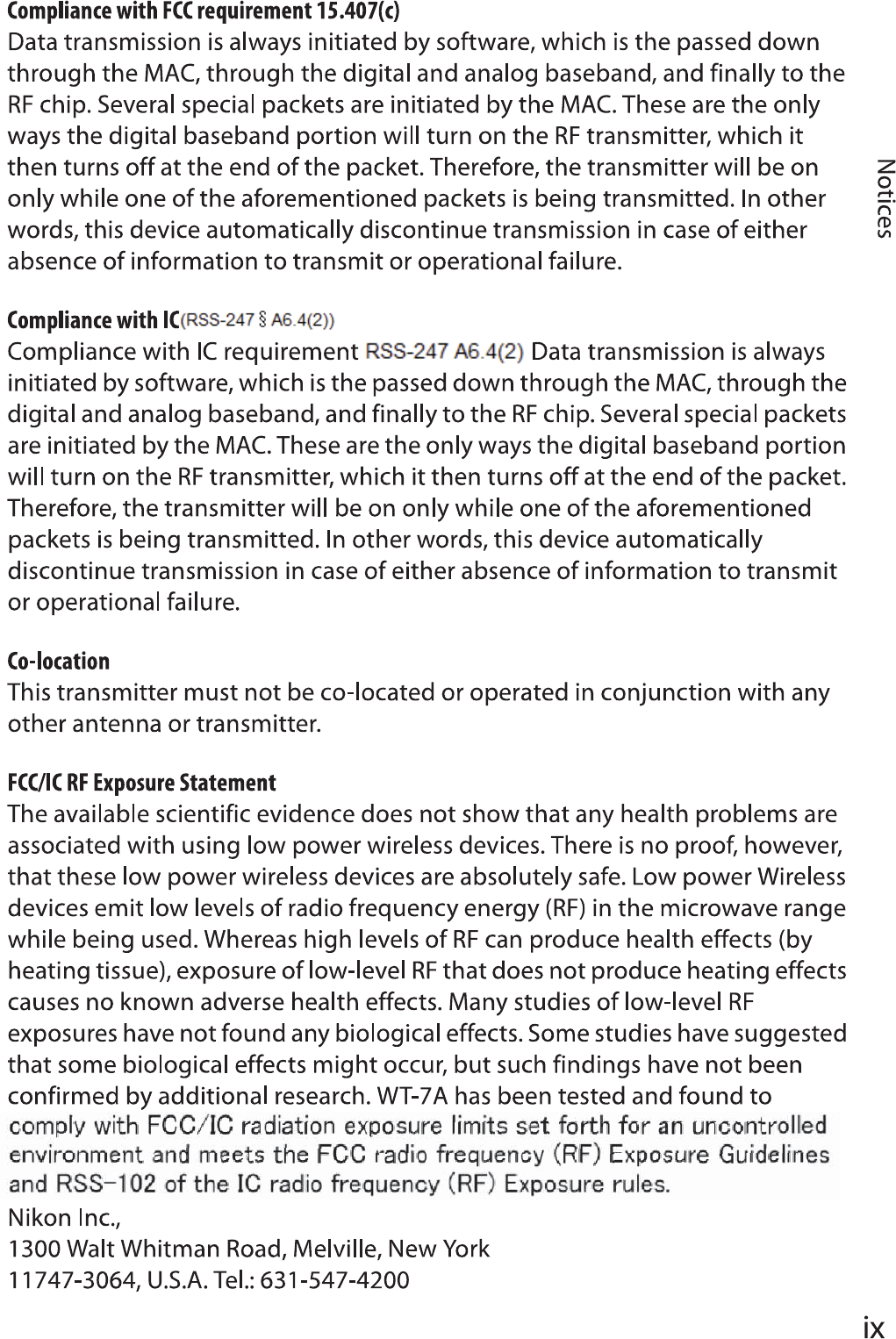
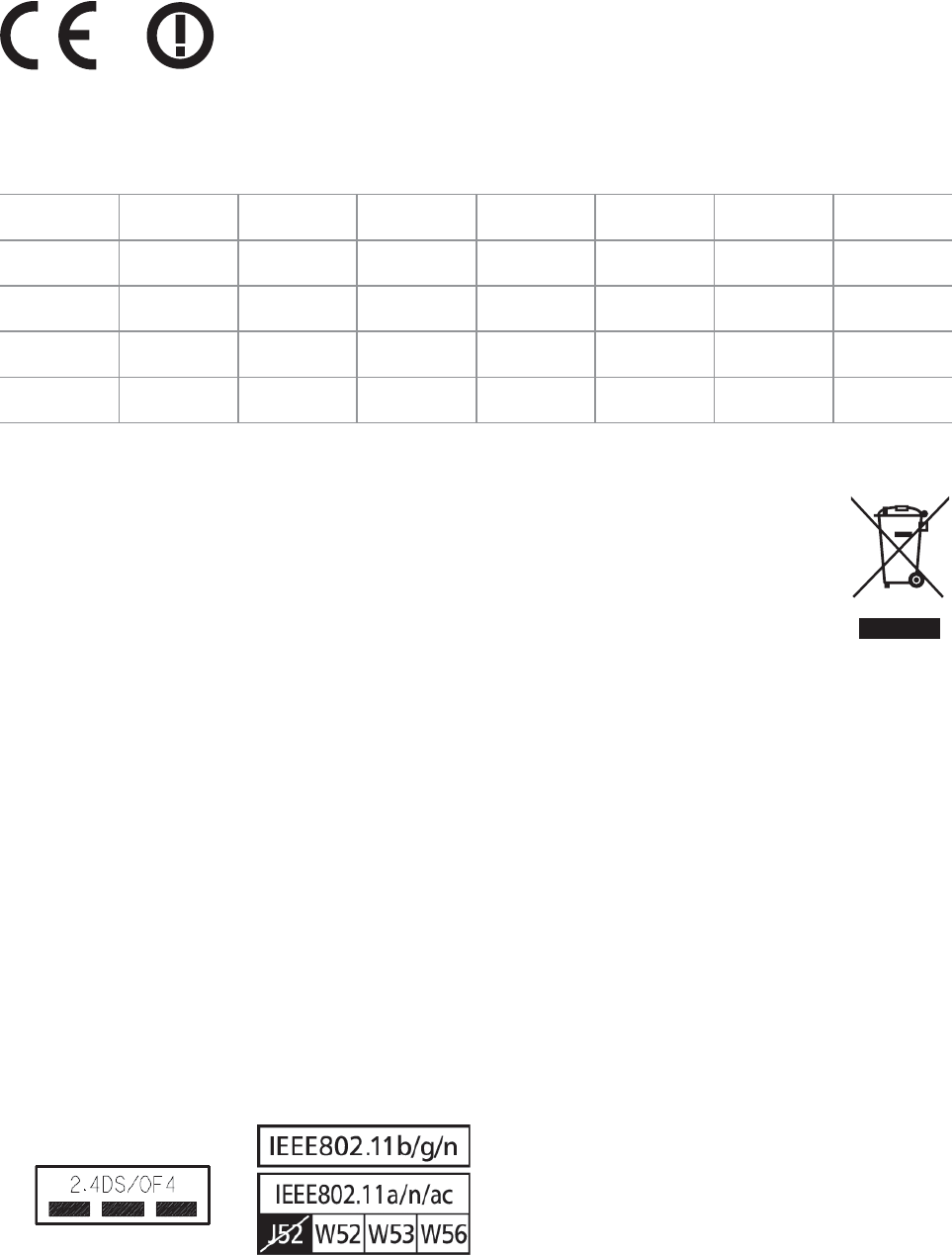
x
Notices
Notice for Customers in Europe
R&TTE Directive
We, the manufacturer (Nikon Corporation) hereby declare that this Wireless
Transmitter (WT-7) is in compliance with the essential requirements and other
relevant provisions of Directive 1999/5/EC.
Symbol for Separate Collection in European Countries
This symbol indicates that electrical and electronic equipment is to
be collected separately.
The following apply only to users in European countries:
•
This product is designated for separate collection at an appropriate
collection point. Do not dispose of as household waste.
•Separate collection and recycling helps conserve natural resources and
prevent negative consequences for human health and the environment that
might result from incorrect disposal.
•For more information, contact the retailer or the local authorities in charge of
waste management.
Declaration of Conformity
A copy of the original DoC for our products as it relates to R&TTE can be found
at the following website:
http://imaging.nikon.com/support/pdf/DoC_WT-7.pdf
This device complies with radio-frequency regulations. The content of
certification labels not affixed to the device is given below.
AT BE BG CY CZ DK EE FI
FR DE GR HU IE IT LV LT
LU MT NL PL PT RO SK SI
ES SE GB IS LI NO CH TR
HR

xi
Notices
Available Channels
The WT-7 is available in four versions, each destined for use in a
different region in compliance with local regulations governing
the use of wireless devices (for information on countries not listed
in the following table, contact a Nikon representative). Use each
model only in the region for which it is intended.
Version For use in Channels
2.4 GHz band 5GHz band
WT-7
The 32 countries of the EU-EFTA
(Austria, Belgium, Bulgaria, Croatia,
Cyprus, the Czech Republic,
Denmark, Estonia, Finland, France,
Germany, Greece, Hungary, Iceland,
Ireland, Italy, Latvia, Liechtenstein,
Lithuania, Luxembourg, Malta, the
Netherlands, Norway, Poland,
Portugal, Romania, Slovakia,
Slovenia, Spain, Sweden,
Switzerland, the United Kingdom),
Australia, Japan, New Zealand, Saudi
Arabia, South Africa, Thailand, Turkey
1–13 36–64,
100–140
WT-7A Argentina, Brazil, Canada, Chile,
India, Mexico, Panama, U.S.A. 1–11 36–64,
149–165
WT-7B Korea, Russia, Singapore 1–13 36–64
WT-7C China, Hong Kong, Malaysia, Taiwan 1–13 149–165

xii
Notices
5GHz band
The channels available for 5GHz band are listed below.
Version Location Mode
Channels
W52 W53 W56 W58
36–48 52–64 100–140 149–165
WT-7
Indoor Infrastructure ✔✔✔—
Access point ————
Outdoor Infrastructure Prohibited Prohibited ✔—
Access point ————
WT-7A
Indoor Infrastructure ✔✔—✔
Access point ————
Outdoor Infrastructure Prohibited Prohibited —✔
Access point ————
WT-7B
Indoor Infrastructure ✔✔——
Access point ————
Outdoor Infrastructure ✔✔——
Access point ————
WT-7C
Indoor Infrastructure ———✔
Access point ————
Outdoor Infrastructure ———✔
Access point ————

xiii
Table of Contents
What the WT-7 Can Do for You .........................................................ii
For Your Safety ........................................................................................v
Notices......................................................................................................vii
Introduction 1
Parts of the WT-7 ....................................................................................2
Getting Ready ..........................................................................................4
Supported Network Functions ..........................................................8
Transfer, Control, and HTTP 10
Ethernet Connections........................................................................ 10
Step 1: Connecting the Equipment.......................................... 11
Step 2: Configuring the Hardware for
Ethernet Connections............................................................... 12
Step 3: The Connection Wizard.................................................. 13
Step 4: Pairing .................................................................................. 16
Wireless Connections......................................................................... 18
Step 1: Readying the Equipment............................................... 20
Step 2: Enable Camera Wireless................................................. 21
Step 3: The Connection Wizard.................................................. 22
Step 4: Network Settings.............................................................. 29
Image Transfer...................................................................................... 32
Camera Control .................................................................................... 37
HTTP Server ........................................................................................... 40
Computer and Android Web Browsers................................... 46
iPhone Web Browsers.................................................................... 53

xiv
FTP 58
Ethernet Connections ........................................................................ 58
Step 1: Connecting the Hardware .............................................59
Step 2: Configuring the Hardware for
Ethernet Connections ...............................................................60
Step 3: The Connection Wizard ..................................................61
Wireless Connections......................................................................... 65
Step 1: Connecting the Equipment ..........................................66
Step 2: Enable Camera Wireless .................................................67
Step 3: The Connection Wizard ..................................................68
Step 4: Network Settings ..............................................................75
FTP Upload............................................................................................. 78
Menu Guide 83
Choose Hardware................................................................................ 83
Network Settings ................................................................................. 84
The Profile List ..................................................................................84
Create Profile.....................................................................................84
Copy to/from Card ..........................................................................85
Deleting Network Profiles ............................................................85
Editing Network Profiles ...............................................................86
Options.................................................................................................... 89
Auto Send...........................................................................................89
Delete After Send ............................................................................89
Send File As........................................................................................89
Overwrite If Same Name...............................................................90
Protect If Marked for Upload.......................................................90
Send Marking (FTP Upload Mode Only)..................................90
Send Folder........................................................................................90

xv
Deselect All?...................................................................................... 91
HTTP User Settings ......................................................................... 91
Battery Info........................................................................................ 91
Power Saving.................................................................................... 91
Auto Power off Delay..................................................................... 92
MAC Address .................................................................................... 92
Firmware Version ............................................................................ 92
Appendices 93
Creating Profiles on a Computer ................................................... 93
Creating an FTP Server ...................................................................... 95
Manual Profile Creation...................................................................103
Troubleshooting ................................................................................105
Specifications......................................................................................107
Index.......................................................................................................110

xvi
ABackground Knowledge
This manual assumes basic knowledge of ftp servers and local area
networks (LANs). For more information on installing, configuring, and
using devices in a network, contact the manufacturer or network
administrator.
AIllustrations
The appearance and content of the software and operating system
dialogs, messages, and displays shown in this manual may vary with the
operating system used. For information on basic computer operations,
see the documentation provided with the computer or operating
system.
ACamera Controls
The camera operations described in this manual are those for the D500.
Operations for other cameras may differ.
ALife-Long Learning
As part of Nikon’s “Life-Long Learning” commitment to ongoing
product support and education, continually-updated information is
available on-line at the following sites:
•For users in the U.S.A.: http://www.nikonusa.com/
•For users in Europe and Africa: http://www.europe-nikon.com/support/
•For users in Asia, Oceania, and the Middle East: http://www.nikon-asia.com/
Visit these sites to keep up-to-date with the latest product information,
tips, answers to frequently-asked questions (FAQs), and general advice
on digital imaging and photography. Additional information may be
available from the Nikon representative in your area. See the following
URL for contact information: http://imaging.nikon.com/

1Introduction
Introduction
Thank you for your purchase of a WT-7 wireless transmitter for
compatible Nikon digital cameras. Please read this manual
thoroughly and keep it where all those who use the product can
read it.
The following symbols and conventions are used throughout this
manual:
DThis icon marks cautions, information that should be read before
use to prevent damage to the product.
AThis icon marks notes, information that should be read before
using the device.
0This icon marks references to other pages in this manual.
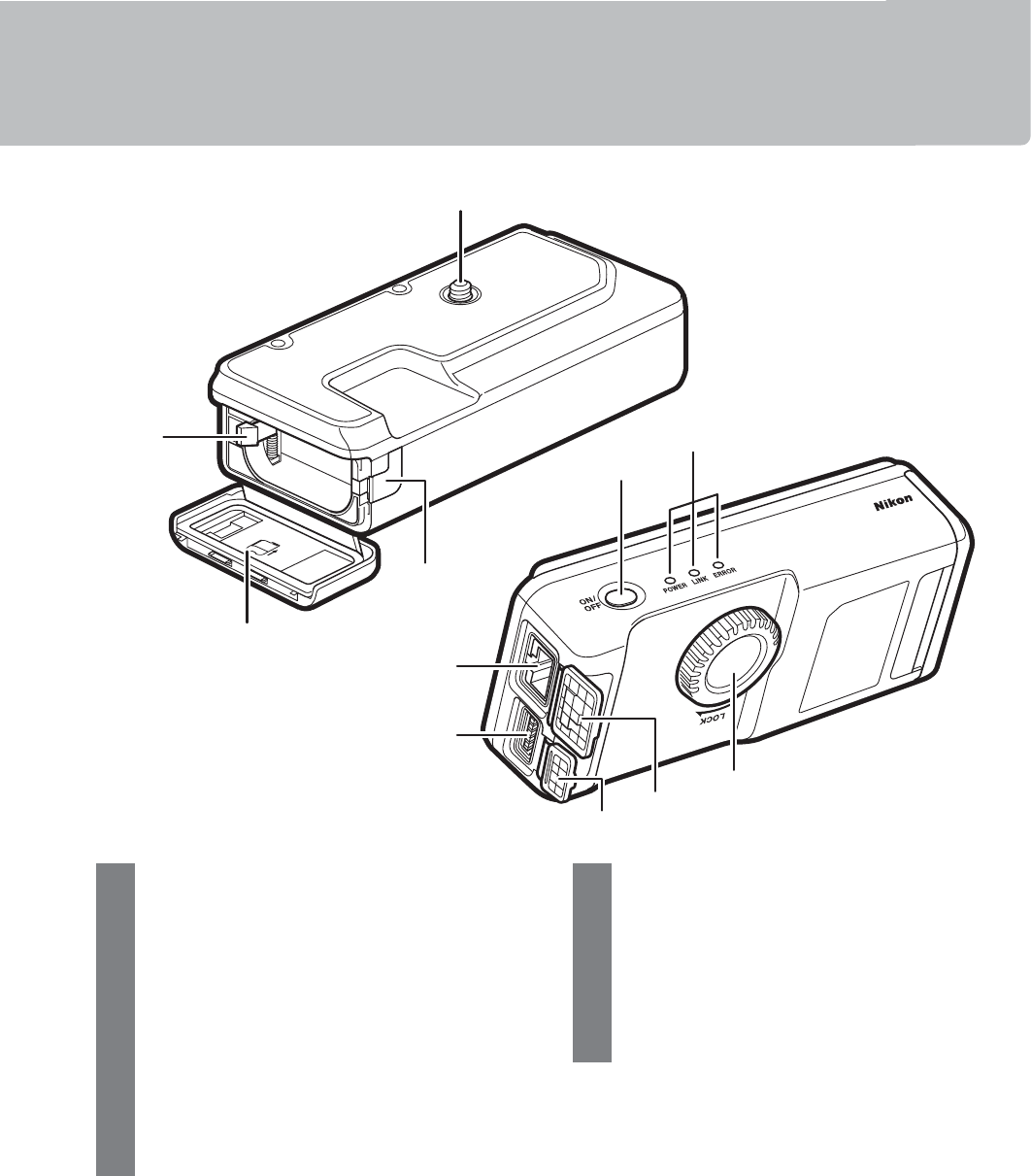
2Introduction
Parts of the WT-7
Parts of the WT-7
4
11
10
2
7
3
8
9
1
5
6
1Mounting screw.................................5
2Power connector cover ....................7
3Battery-chamber cover ....................4
4Battery latch........................................4
5Power switch.................11, 20, 59, 66
6Status LEDs....................35, 38, 44, 81
POWER (green/yellow),
LINK (green), ERROR (orange)
7Attachment wheel.............................5
8Ethernet connector cover
9USB connector cover
10 USB connector....................................5
11 Ethernet connector
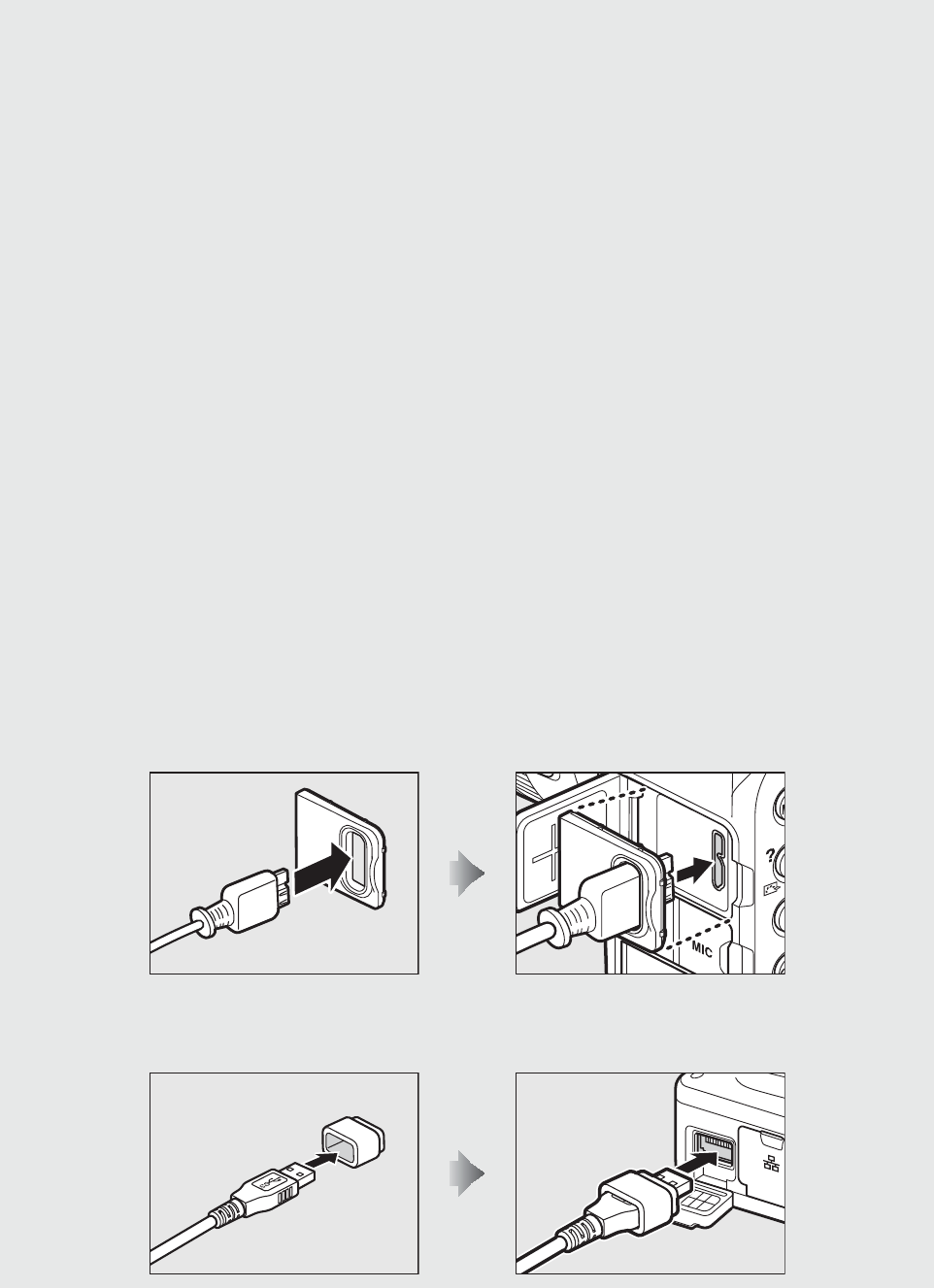
3Introduction
Parts of the WT-7
AThe POWER LED
When the WT-7 is on, the POWER LED glows green to indicate that the
battery is fully charged or that an AC adapter is connected. At battery
levels below 10%, it will flash to warn that the battery requires charging.
When the WT-7 is turned off, the POWER LED briefly turns yellow as the
product powers down.
ASupplied Accessories
The following accessories are supplied with the WT-7 (batteries such as
the EN-EL15 are not supplied):
AUSB Cable Gaskets and Connector Covers
The USB cable gaskets and connector covers prevent accidental
disconnections. Attach as shown below.
When connecting the USB cable to a camera, attach the supplied UF-7 cable
connector cover as shown.
When connecting the USB cable to the WT-7, attach the supplied UF3-RU14
cable gasket as shown.
❏User’s Manual (this manual)
❏Warranty
❏CF-WT7 case
❏AN-CP24 Strap
❏USB cable B
❏UF3-RU14 USB cable gasket
❏UF-7 USB cable connector cover
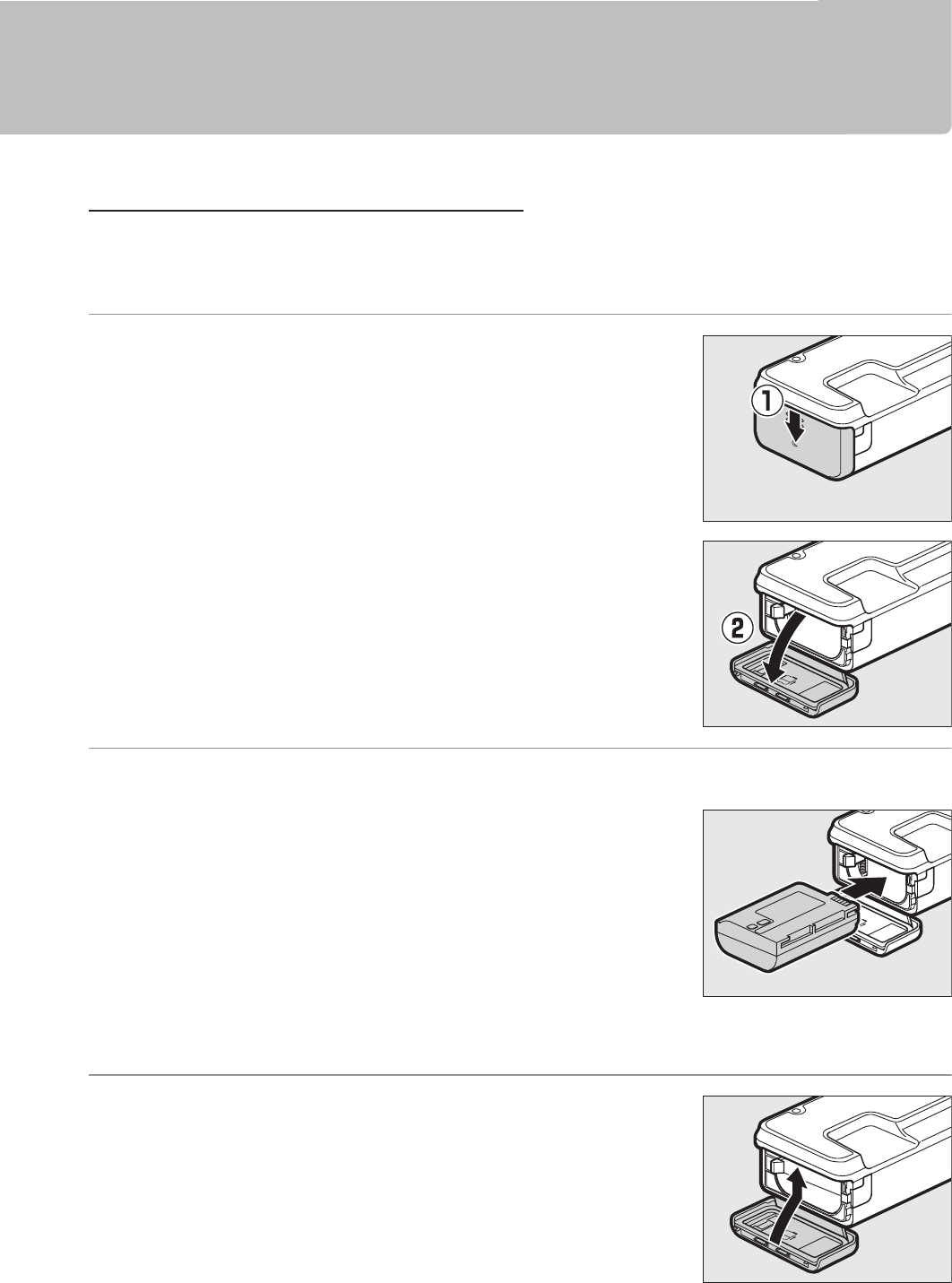
4Introduction
Getting Ready
Getting Ready
Inserting the Battery
The WT-7 takes one EN-EL15 rechargeable Li-ion battery. Insert the
battery as described below.
1Open the battery-chamber cover.
Unlatch the cover by sliding it as shown
(q).
Open the cover (w).
2Insert the battery.
Using the battery to keep the battery
latch pressed to one side, slide the
battery in until the latch clicks back into
place. For safety precautions and
information on charging the battery, see
the battery and charger manuals.
3Close the battery-chamber cover.
Reverse the instructions in Step 1 to close
and latch the cover as shown. Be sure the
cover is securely latched.
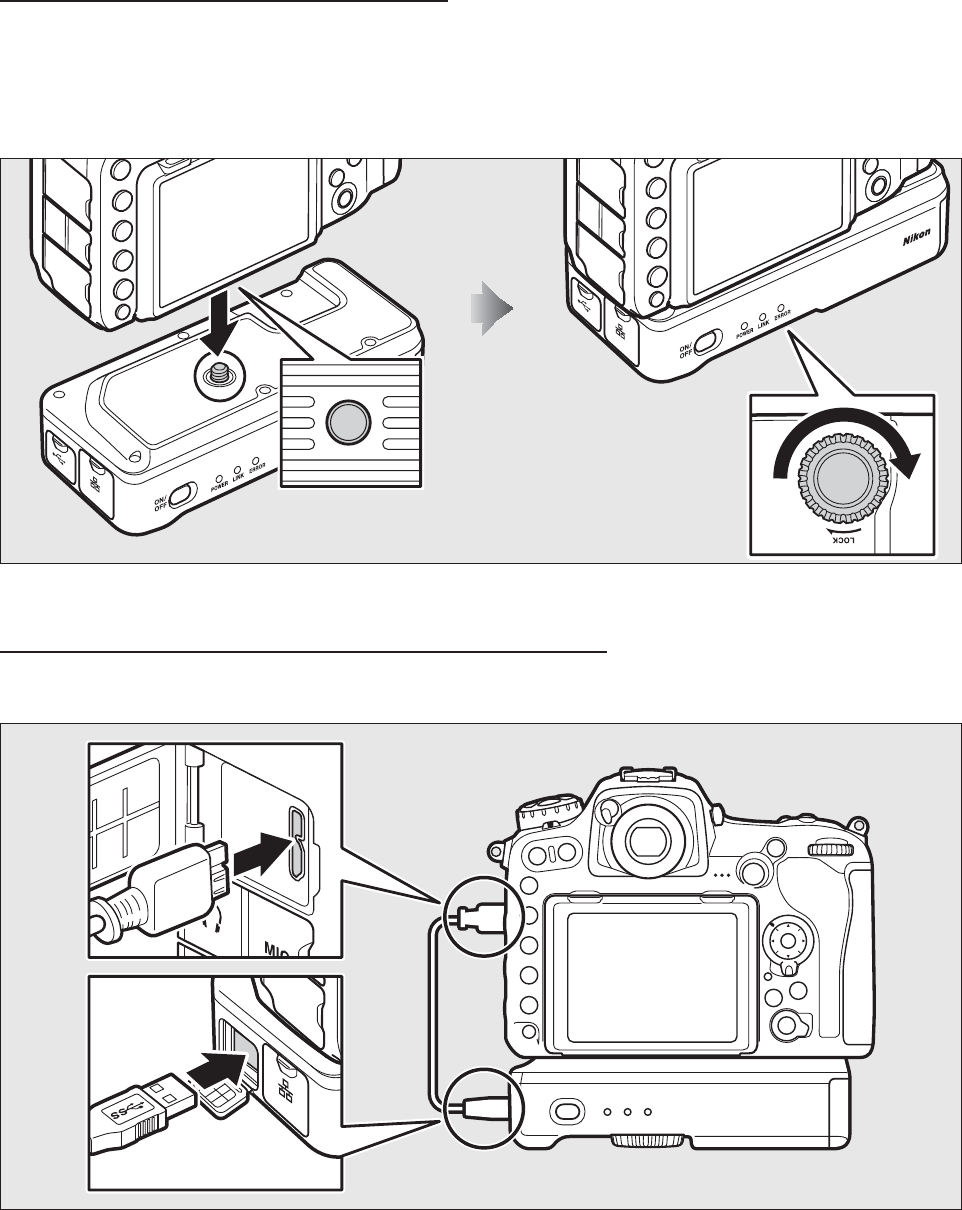
5Introduction
Getting Ready
Attaching the WT-7
After checking that the camera is off, align the WT-7 mounting
screw with the camera tripod socket and tighten by rotating the
attachment wheel in the direction shown by the LOCK arrow.
Connecting the USB Cable
Connect the WT-7 to the camera using the supplied USB cable.

6Introduction
Getting Ready
The Wireless Transmitter Utility
The Wireless Transmitter Utility is used for pairing in image transfer
and camera control modes (016) and can also help create
network profiles (093). You can install the utility after
downloading it from the following website:
http://downloadcenter.nikonimglib.com/
Be sure to use the latest versions of the Wireless Transmitter Utility
and the camera firmware.
ARemoving the Battery
Being careful not to drop the battery, open the
WT-7 battery-chamber cover and remove the
battery as shown at right.
AStand-By Mode
When the WT-7 is disconnected from the camera or the camera is
turned off, the WT-7 will turn off automatically after the delay chosen for
Network > Options > Auto power off delay in the setup menu (092),
reducing the drain on the battery.
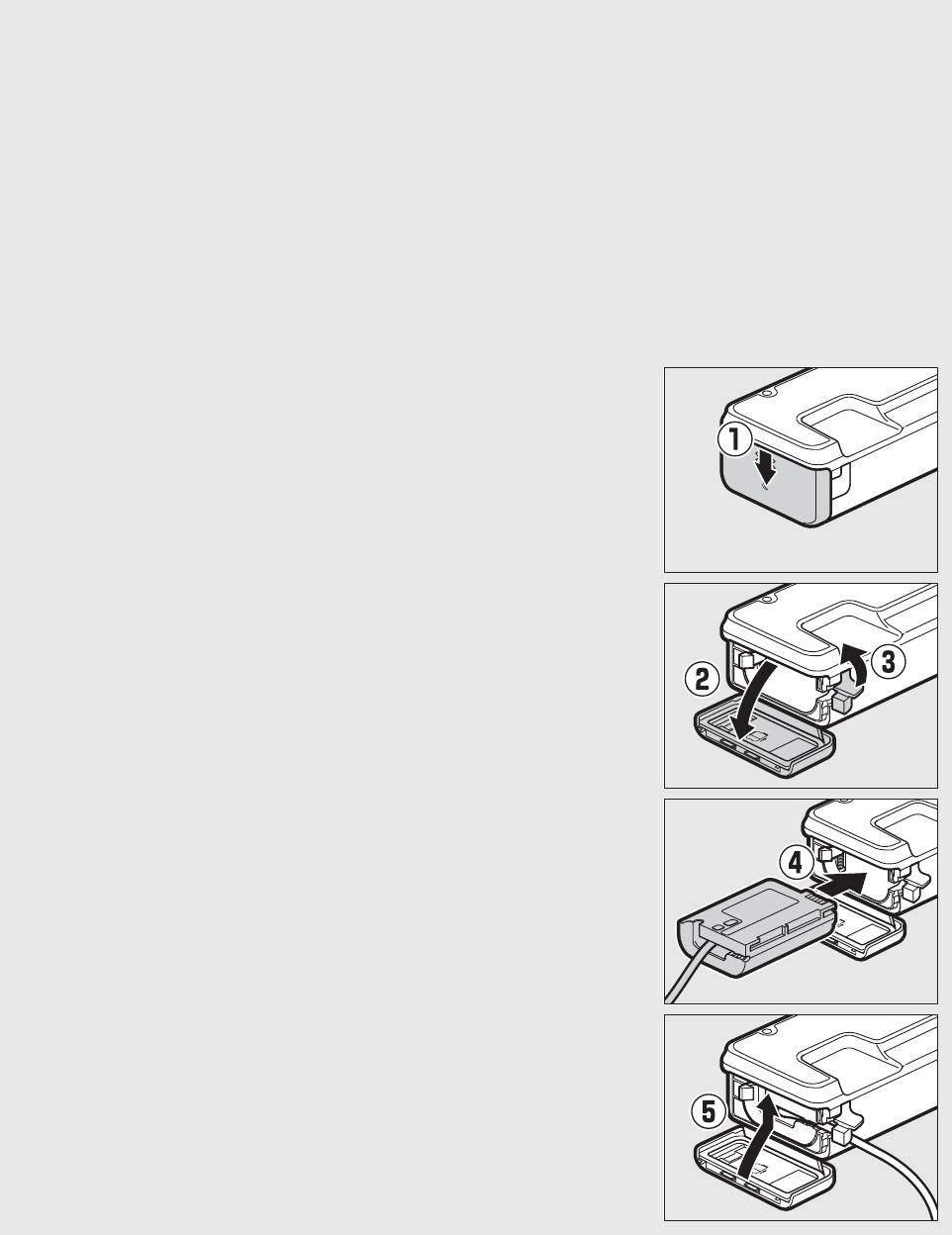
7Introduction
Getting Ready
ABattery Level
The level of the battery inserted in the WT-7 can be determined by
connecting the WT-7 to the camera (05) and checking the battery level
using the Options > Battery info in the Network menu (091).
AUsing an AC Adapter
An optional EP-5B power connector and EH-5b or EH-5/EH-5a AC
adapter can also be used to power the camera when the WT-7 is
connected. Insert the power connector as shown below.
1Unlatch the battery-chamber cover (q).
2Open the battery-chamber (w) and power
connector covers (e).
3Using the power connector to keep the battery
latch pressed to one side, slide the connector in
until the latch clicks back into place (r).
4Position the power connector so that the cord
passes through the power connector slot and
close the battery-chamber cover (t). Be sure
that the cover is securely latched.
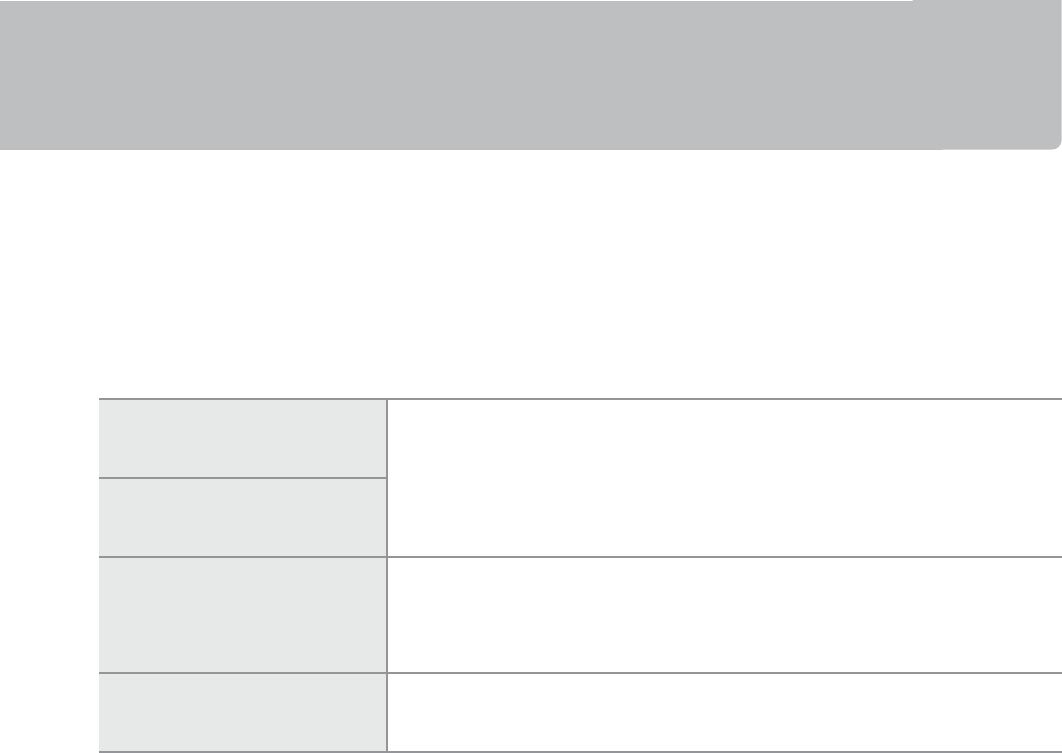
8Introduction
Supported Network Functions
Supported Network Functions
The WT-7 wireless transmitter connects the camera to Ethernet
and wireless networks. Photographs on the camera can then be
transmitted to a computer or ftp server and the camera controlled
remotely from a computer. The WT-7 supports the following
functions:
Before data can be transferred over a wireless or Ethernet network,
the camera must be supplied with a network profile providing
information on the host computer or ftp server.
FTP upload
(078) Upload existing photos and movies to a computer
or ftp server, or upload new photos as they are
taken.
Image transfer
(032)
Camera control
(037)
Control the camera using optional
Camera Control Pro 2 software and save new
photos and movies directly to the computer.
HTTP server
(040)
View and take pictures remotely using a browser-
equipped computer or smart device.

9Introduction
Supported Network Functions
DChoosing a Power Source
To prevent the camera or WT-7 powering off unexpectedly during setup
or data transfer, use fully-charged batteries or optional AC adapters
designated for use with the camera or WT-7. For more on camera power
sources, see the camera manual.
AFTP Servers
Servers can be configured using standard ftp services available with
supported operating systems, such as IIS (Internet Information
Services). Connection to computers on other networks via a router,
Internet ftp connections and ftp servers running third-party software
are not supported.
AEthernet Connection
No adjustments to wireless LAN settings are required when the camera
is connected to a LAN by an Ethernet cable.
AHTTP Server Mode
Internet connections are not supported in http server mode.
ARouters
Connection to computers on other networks via a router is not
supported.
AFirewall Settings
TCP ports 21 and 32768 through 61000 are used for ftp, TCP ports 22
and 32768 through 61000 for sftp, and TCP port 15740 and UDP port
5353 for connections to computers. File transfer may be blocked if the
server firewall is not configured to allow access to these ports.
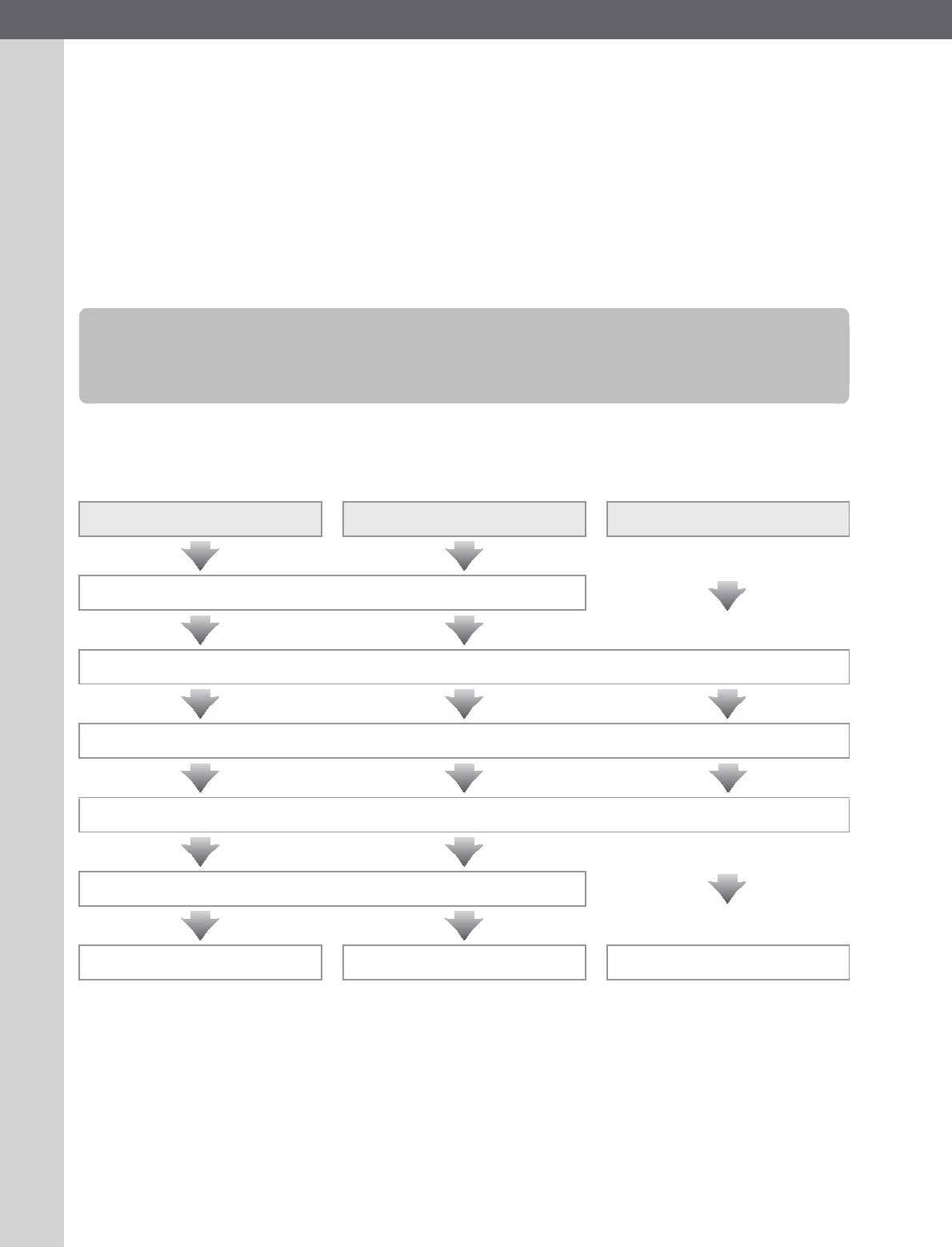
10 Transfer, Control, and HTTP
Transfer, Control, and
HTTP
Follow the steps below to connect via an Ethernet network. For
information on wireless connections, see page 18.
Ethernet Connections
Image transfer Camera control HTTP server
Install the Wireless Transmitter Utility (06)
Step 1: Connect the camera, WT-7, and computer (011)
Step 2: Configure the hardware for Ethernet connections (012)
Step 3: Run the connection wizard (013)
Step 4: Pair the camera and computer (016)
Transfer pictures (032) Control the camera (037) Access the camera (040)
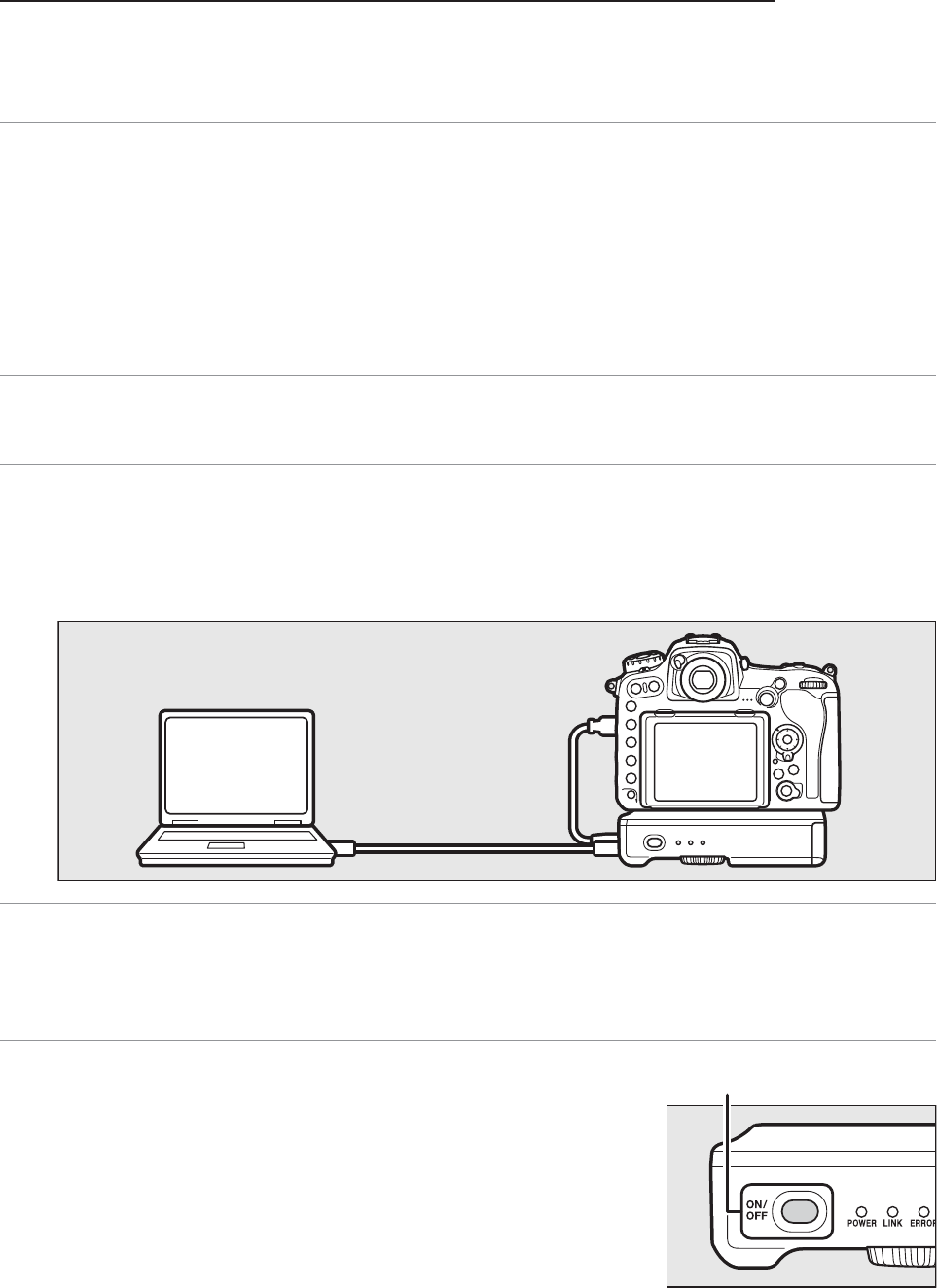
11Transfer, Control, and HTTP
Ethernet Connections
Step 1: Connecting the Equipment
Before proceeding with the following steps, start the computer
and log in.
1Insert a memory card.
Turn the camera off and insert a memory card (do not turn the
camera off or disconnect the Ethernet cable while data are
being transferred to the computer). This step can be omitted
in camera control mode (037).
2Attach the WT-7 (05).
3Connect an Ethernet cable.
Connect the Ethernet cable as shown below. Do not use force
or insert the connectors at an angle.
4Turn the camera on.
Rotate the power switch to turn the camera on.
5Press the power switch for about a
second to turn the WT-7 on.
Power switch
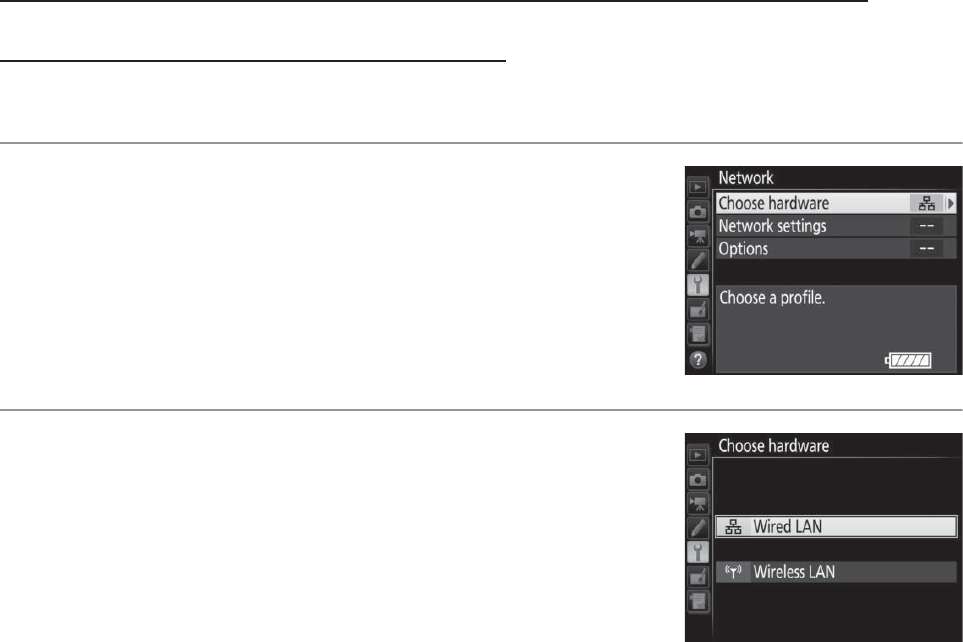
12 Transfer, Control, and HTTP
Ethernet Connections
Step 2: Configuring the Hardware for
Ethernet Connections
Configure the WT-7 for use with Ethernet networks.
1Select Choose hardware.
In the setup menu, select Network, then
highlight Choose hardware and press 2.
The menu offers a choice of Wired LAN
and Wireless LAN.
2Select Wired LAN.
Highlight Wired LAN and press J to
select the highlighted option and return
to the network menu.
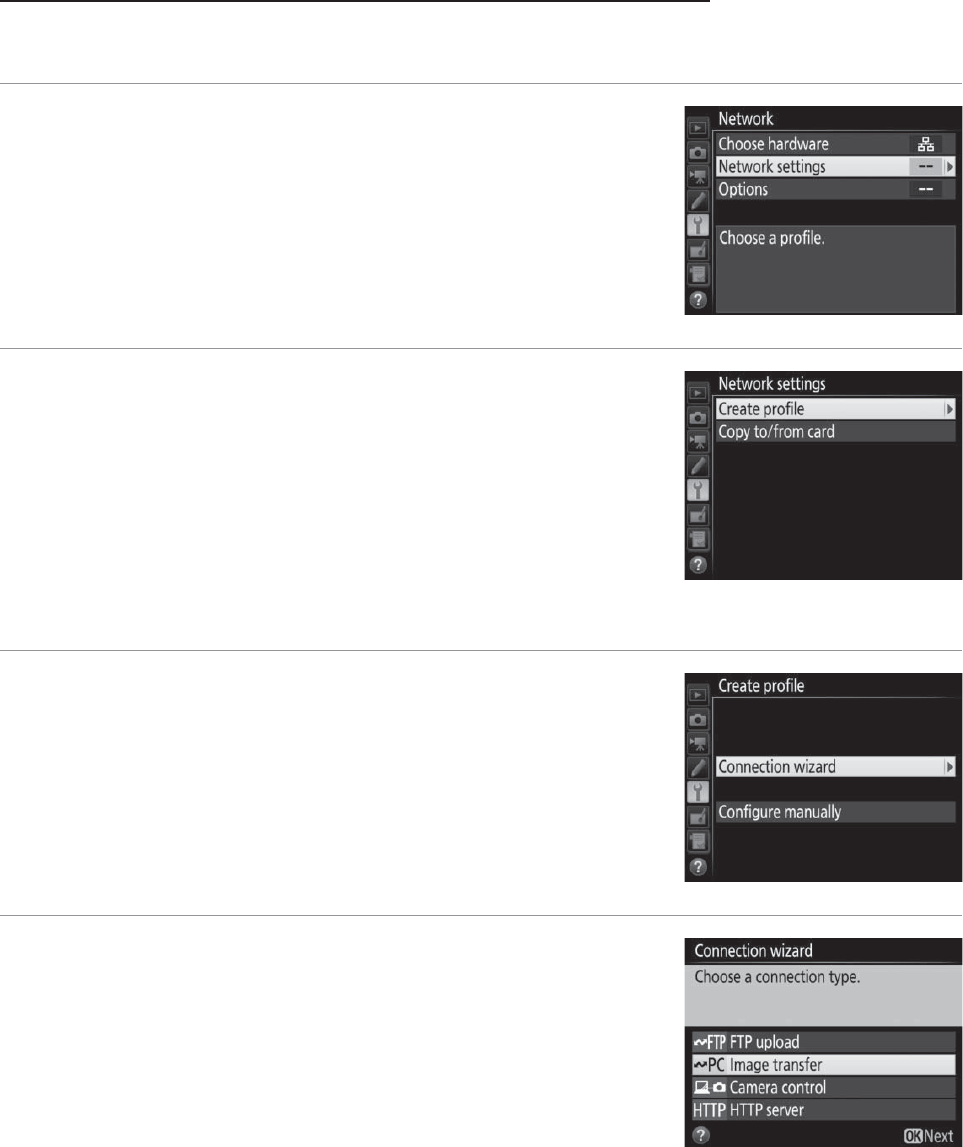
13Transfer, Control, and HTTP
Ethernet Connections
Step 3: The Connection Wizard
Follow the on-screen instructions to create a network profile.
1Display network profiles.
In the network menu, highlight Network
settings and press 2 to display the
profiles list and other network settings.
2Select Create profile.
Highlight Create profile and press 2.
Note that if the list already contains nine
profiles, you will need to delete an
existing profile using the O (Q) button
before proceeding (085).
3Start the connection wizard.
Highlight Connection wizard and press
2 to start the connection wizard.
4Choose a connection type (08).
Highlight Image transfer, Camera
control, or HTTP server and press 2.
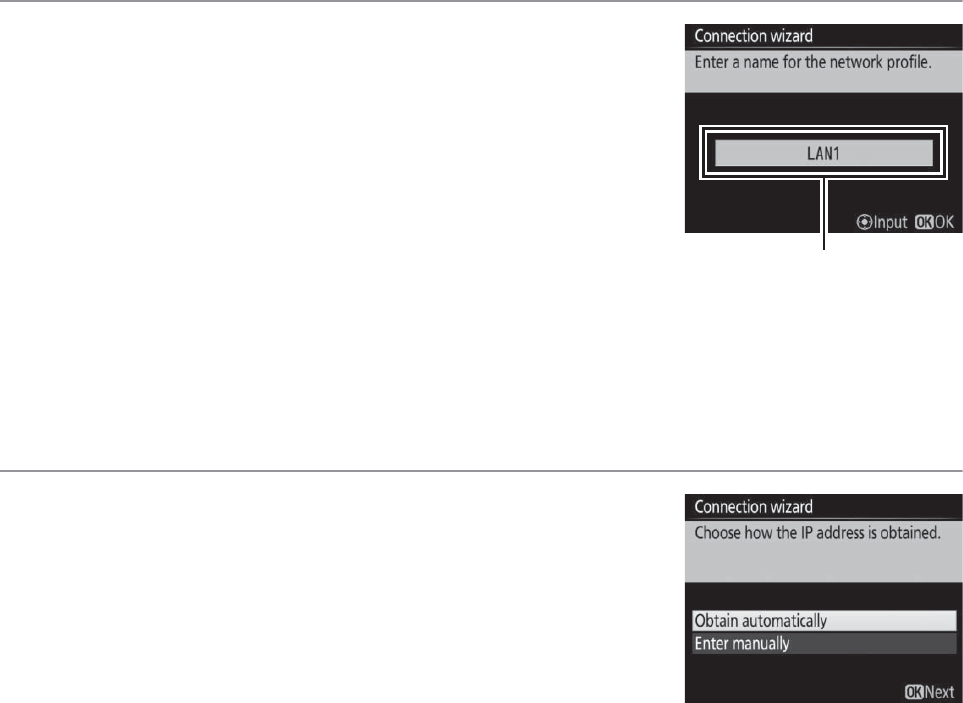
14 Transfer, Control, and HTTP
Ethernet Connections
5Name the new network profile.
A default profile name will be displayed;
to edit or change the name as described
in the camera manual, press the center of
the multi selector (if the camera is a
touch-screen model, you can enter
characters by tapping the letters on the
on-screen keyboard). The profile name will appear in the
Network > Network settings list in the camera setup menu.
Press J to proceed to the next step when entry is complete.
6Obtain or select an IP address.
Highlight one of the following options
and press J.
•Obtain automatically: Select this option if
the network is configured to supply the
IP address automatically.
•Enter manually: When prompted, enter an IP address and
subnet mask by pressing 4 and 2 to highlight segments
and 1 and 3 to change. Press J to proceed when entry is
complete.
Profile name
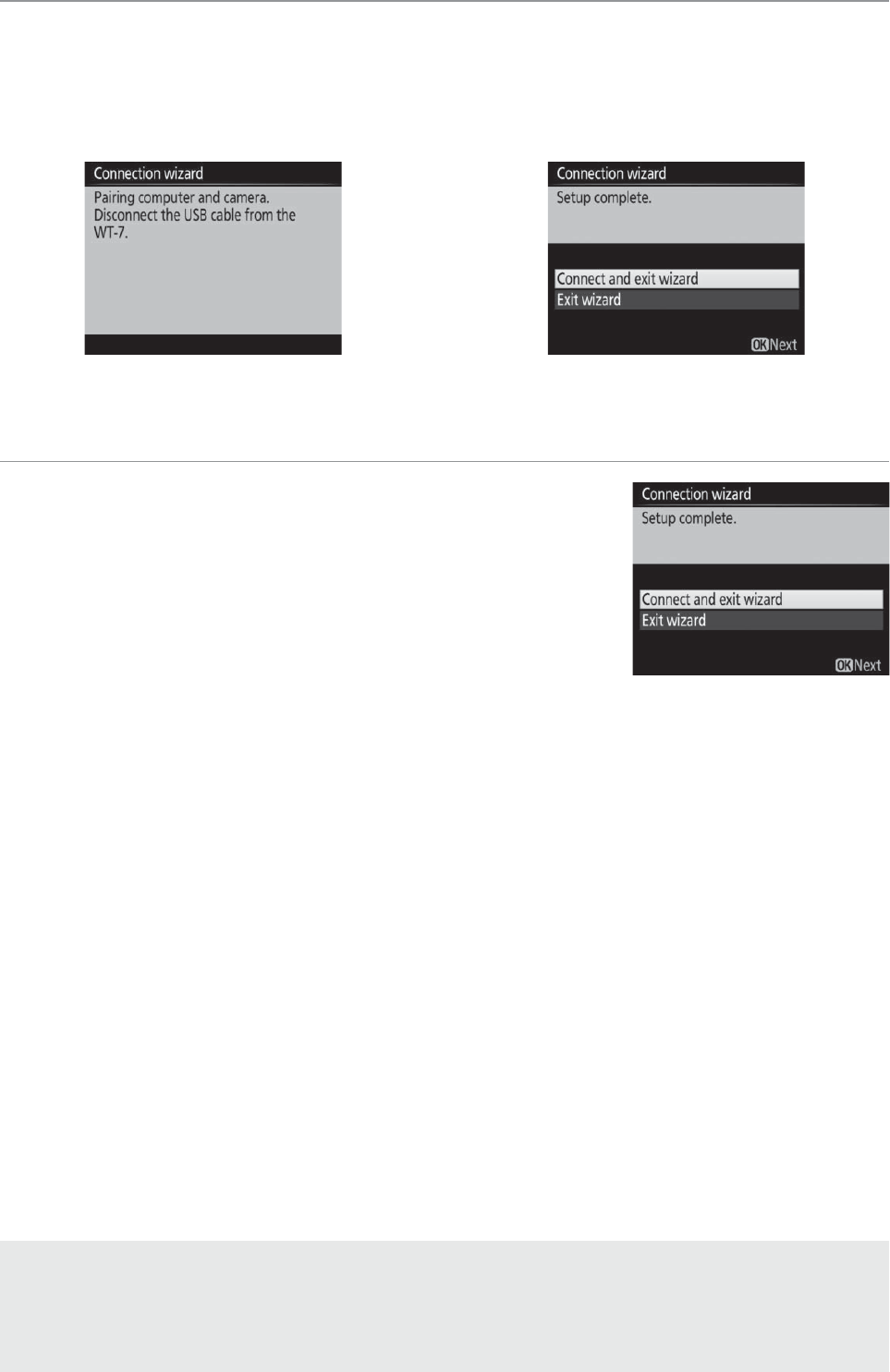
15Transfer, Control, and HTTP
Ethernet Connections
7Choose your next step.
The IP address will be displayed; press J. Your next step
depends on the connection type selected in Step 4 on page 13:
8Exit the wizard.
Highlight one of the following options
and press J.
•Connect and exit wizard: Save the new
network profile and connect to the
server.
•Exit wizard: Save the new network profile and exit.
Proceed to “HTTP Server” (040).
If you chose Image transfer or Camera
control, proceed to page 16.
If you chose HTTP server, proceed to Step 8.
ARouters
Connection to computers on other networks via a router is not
supported.
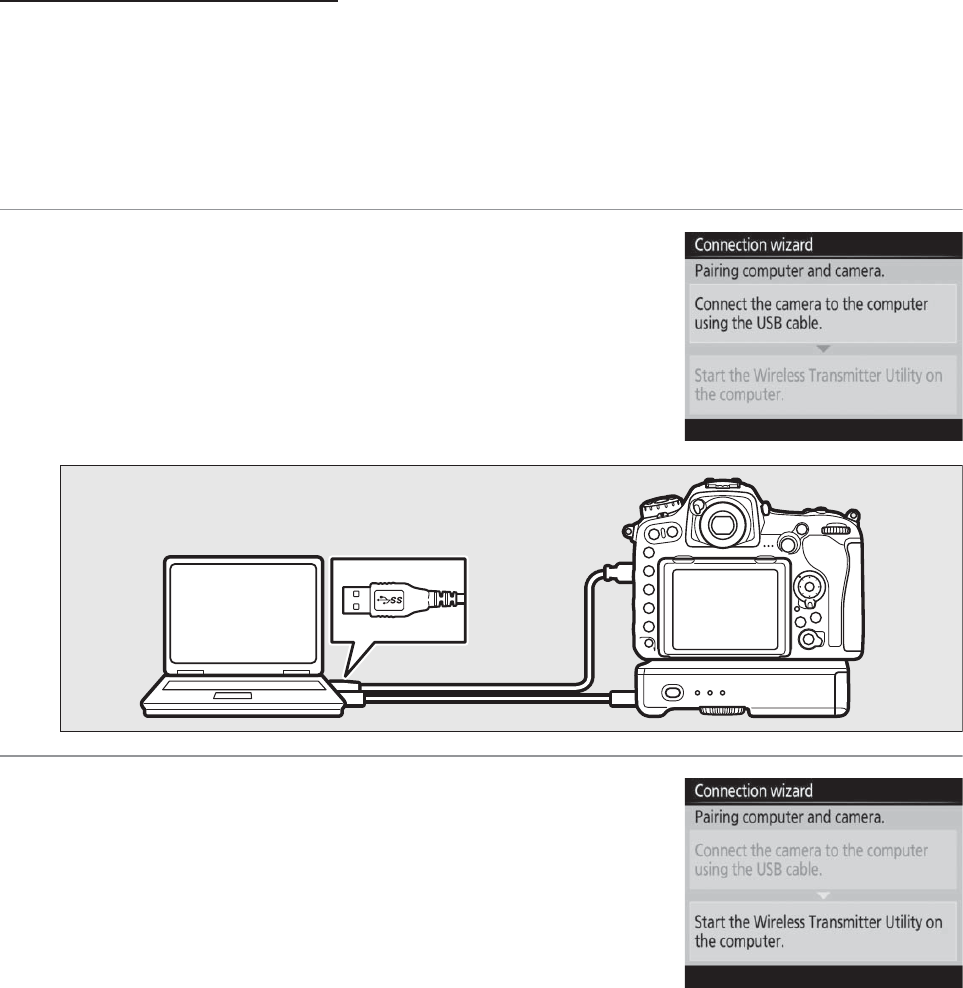
16 Transfer, Control, and HTTP
Ethernet Connections
Step 4: Pairing
If you selected Image transfer or Camera control in Step 4 of the
connection wizard (013), pair the camera with the computer as
described below. Pairing allows the computer to connect to the
camera.
1Connect the camera to the
computer via USB.
Disconnect the USB cable from the WT-7
and connect it to the computer.
2Start the Wireless Transmitter Utility.
When prompted, start the copy of the
Wireless Transmitter Utility installed on
the computer. Pairing will begin
automatically.
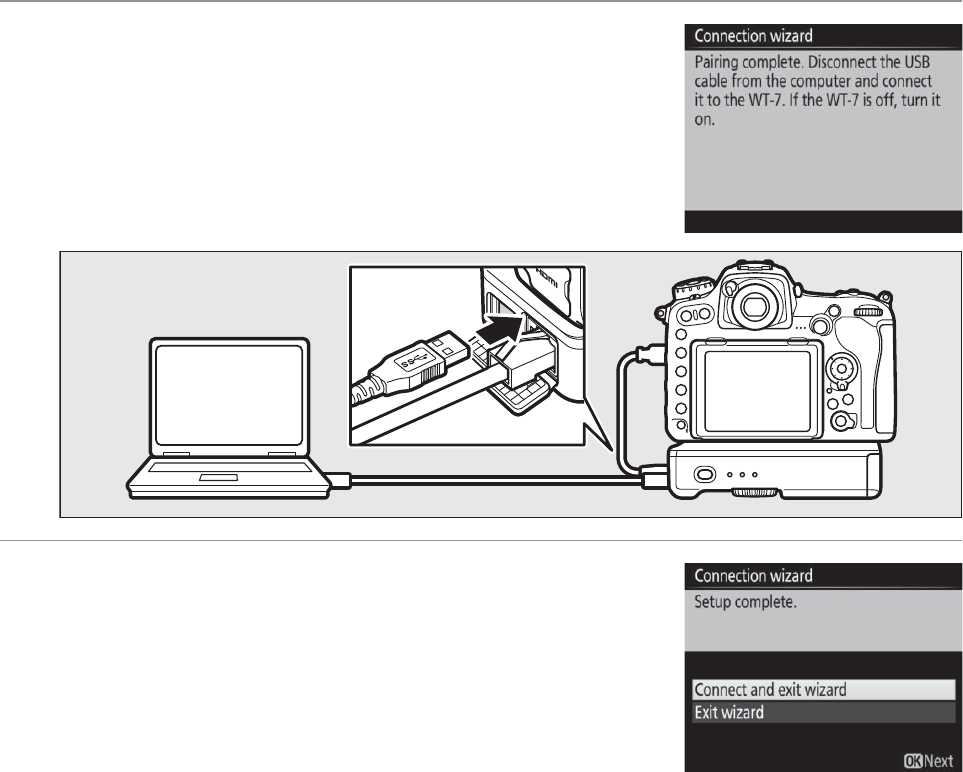
17Transfer, Control, and HTTP
Ethernet Connections
3Disconnect the camera.
The message at right will be displayed
when pairing is complete. Disconnect the
USB cable from the computer and
reconnect it to the WT-7.
4Exit the wizard.
Highlight one of the following options
and press J.
•Connect and exit wizard: Save the new
network profile and connect to the
server.
•Exit wizard: Save the new network profile and exit.
Proceed to “Image Transfer” (032) or “Camera Control” (037).
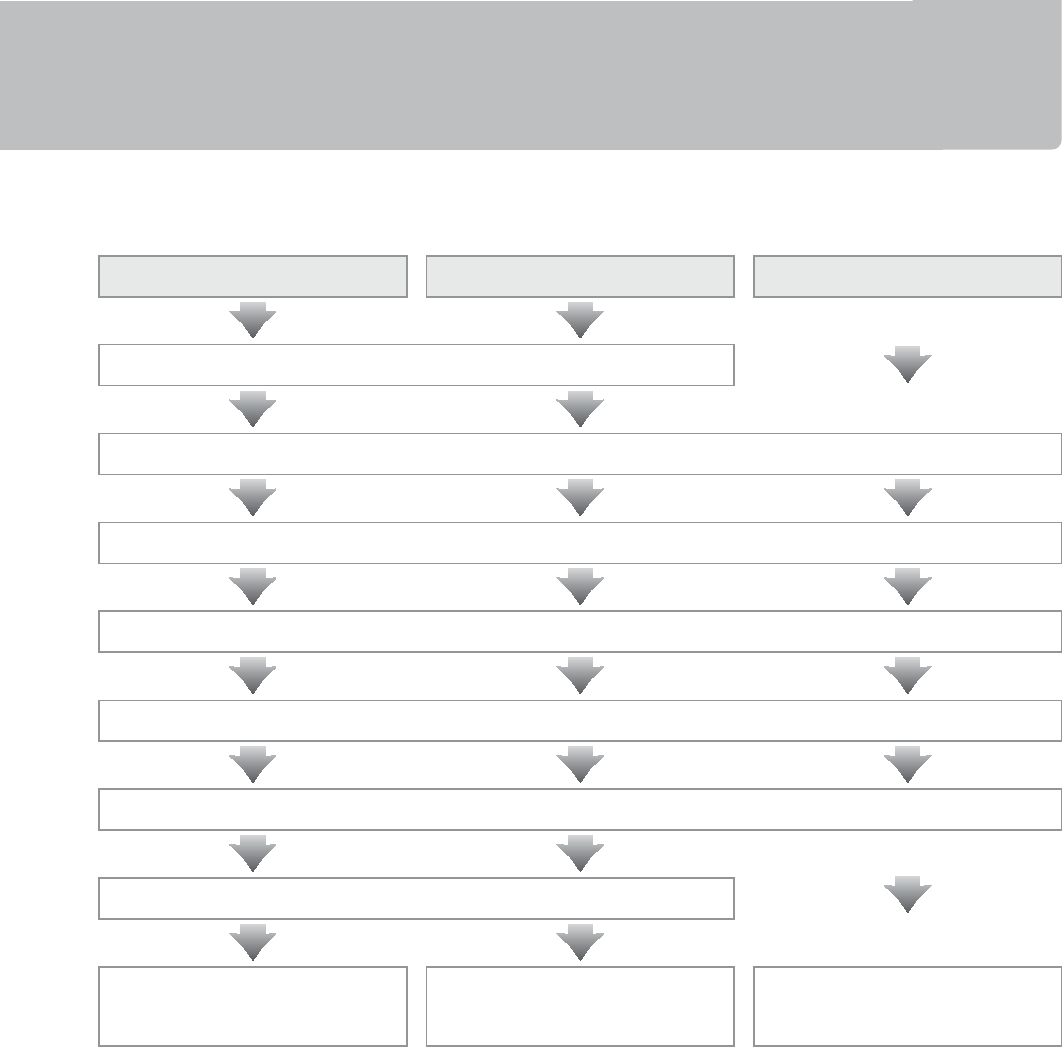
18 Transfer, Control, and HTTP
Wireless Connections
Wireless Connections
Follow the steps below to connect to a wireless network.
Image transfer Camera control HTTP server
Install the Wireless Transmitter Utility
Step 1: Ready the camera and WT-7 (020)
Step 2: Enable Camera Wireless (021)
Step 3: Run the connection wizard (022)
Step 4: Adjust network settings (029)
Adjust settings for the chosen connection type
Pair the camera and computer
Transfer pictures
(032)
Control the camera
(037)
Access the camera
(040)
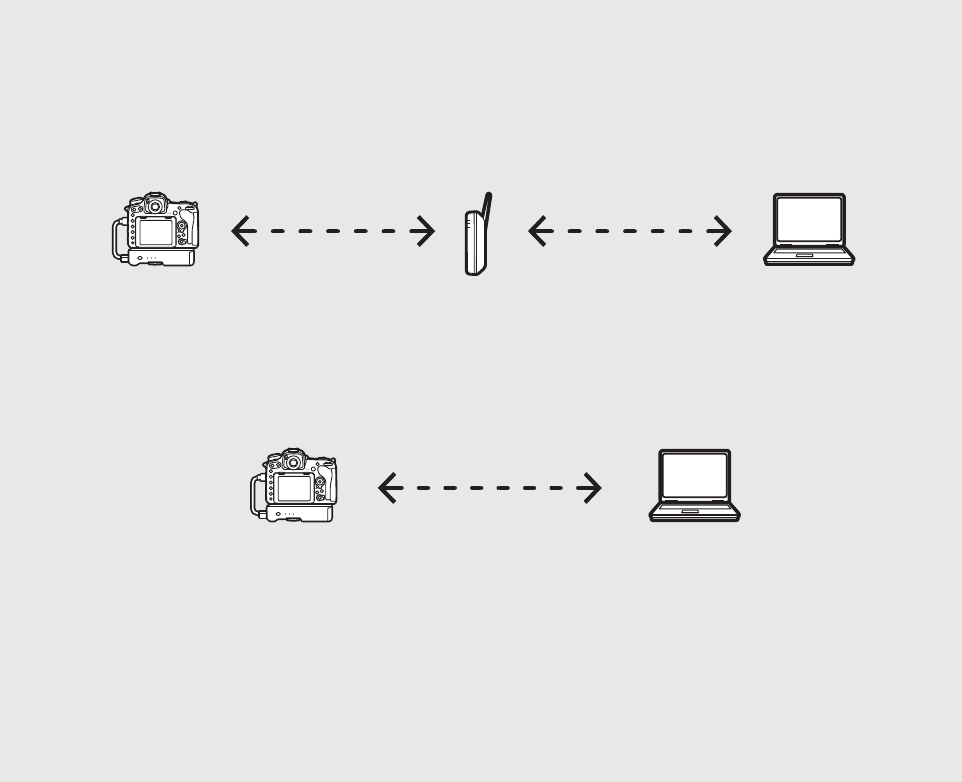
19Transfer, Control, and HTTP
Wireless Connections
AInfrastructure and Access Point Modes
Connections to wireless networks may be in infrastructure or access
point mode.
Infrastructure mode: Connection via a wireless LAN access point.
Access point mode: The camera serves as an access point for direct
connection to a computer or smart device.
AWireless LANs
These instructions are intended for customers with an existing wireless
LAN, and in the case of infrastructure networks assume that the
computer and access point are already connected to the network.
WT-7 Wireless LAN access point Computer or
smart device
WT-7 Computer or
smart device
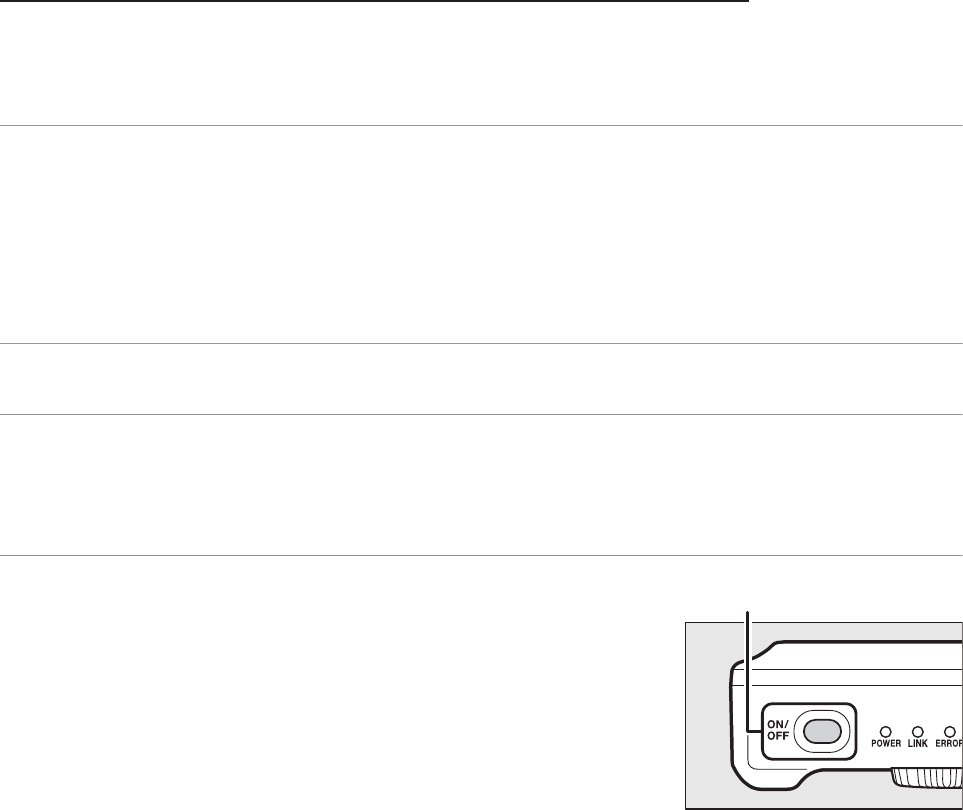
20 Transfer, Control, and HTTP
Wireless Connections
Step 1: Readying the Equipment
After starting the computer and logging in, ready the camera and
WT-7 as described below.
1Insert a memory card.
Turn the camera off and insert a memory card (do not turn the
camera off while data are being transferred to the computer).
This step can be omitted in camera control mode (08).
2Attach the WT-7 (05).
3Turn the camera on.
Rotate the power switch to turn the camera on.
4Press the power switch for about a
second to turn the WT-7 on.
Power switch
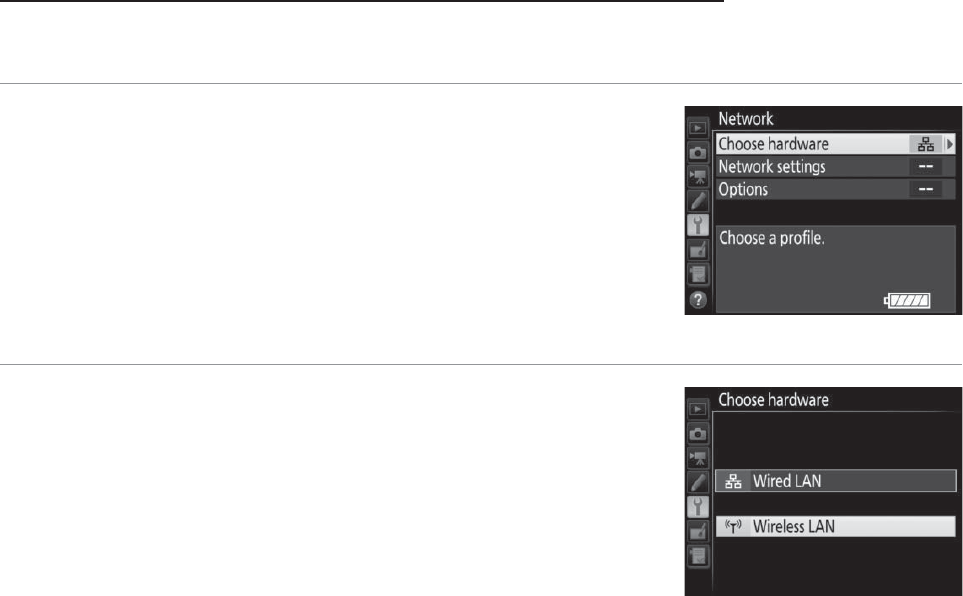
21Transfer, Control, and HTTP
Wireless Connections
Step 2: Enable Camera Wireless
Ready the camera for connection to a wireless network.
1Select Choose hardware.
In the setup menu, select Network, then
highlight Choose hardware and press 2.
The menu offers a choice of Wired LAN
and Wireless LAN.
2Select Wireless LAN.
Highlight Wireless LAN and press J to
select the highlighted option and return
to the network menu.
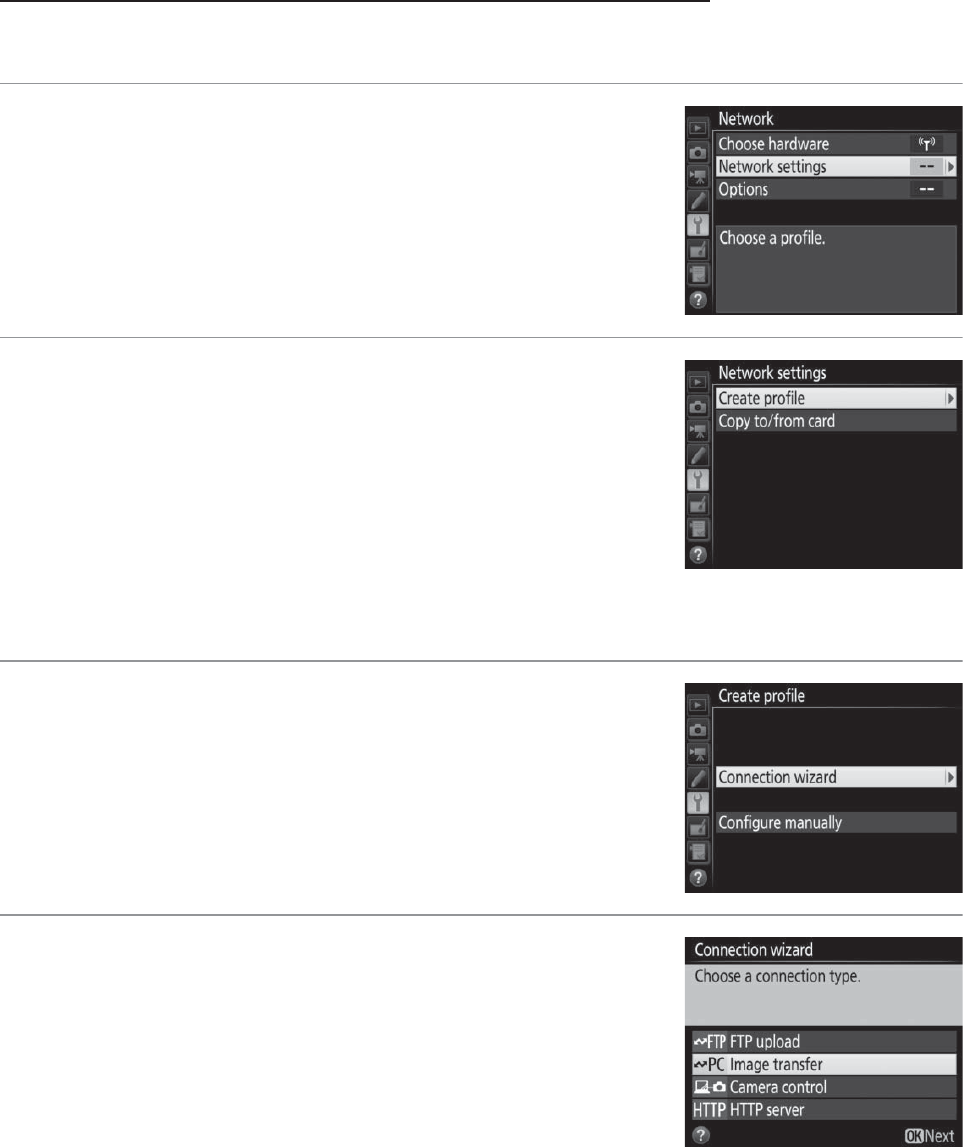
22 Transfer, Control, and HTTP
Wireless Connections
Step 3: The Connection Wizard
Follow the on-screen instructions to create a network profile.
1Display network profiles.
In the network menu, highlight Network
settings and press 2 to display the
profiles list and other network settings.
2Select Create profile.
Highlight Create profile and press 2.
Note that if the list already contains nine
profiles, you will need to delete an
existing profile using the O(Q) button
before proceeding.
3Start the connection wizard.
Highlight Connection wizard and press
2 to start the connection wizard.
4Choose a connection type (08).
Highlight Image transfer, Camera
control, or HTTP server and press J.
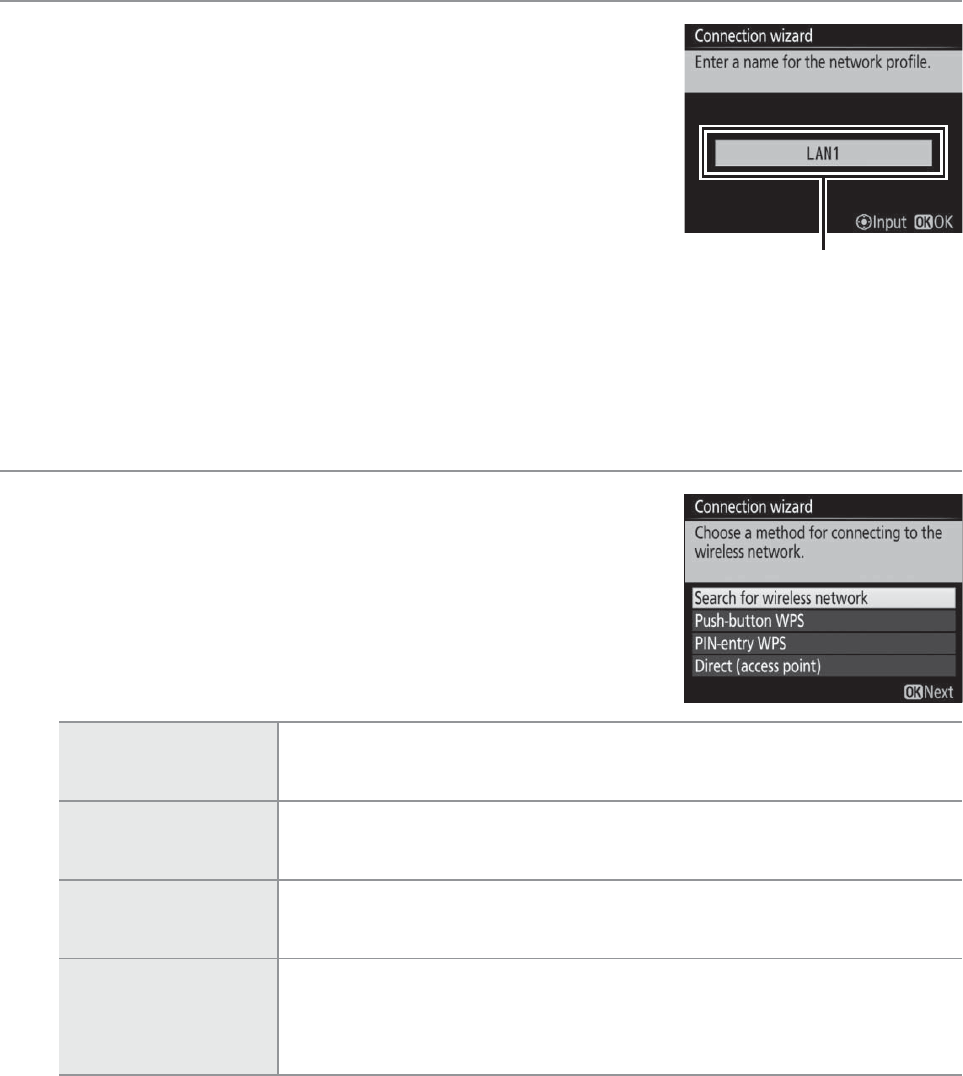
23Transfer, Control, and HTTP
Wireless Connections
5Name the new network profile.
A default profile name will be displayed;
to edit or change the name as described
in the camera manual, press the center of
the multi selector (if the camera is a
touch-screen model, you can enter
characters by tapping the letters on the
on-screen keyboard). The profile name will appear in the
Network > Network settings list in the camera setup menu.
Press J to proceed to the next step when entry is complete.
6Choose a connection method.
Highlight the connection method used
by the network and press J. More
information can be found on the pages
listed below.
Search for wireless
network
Choose from a list of networks detected by the
camera. Proceed to page 24.
Push-button WPS Choose for wireless LAN access points with push-
button WPS. Proceed to page 26.
PIN-entry WPS Choose for wireless LAN access points with PIN-
entry WPS. Proceed to page 27.
Direct
(access point)
Connect directly to a host computer or ftp server in
access point mode, with the camera serving as an
access point. Proceed to page 28.
Profile name
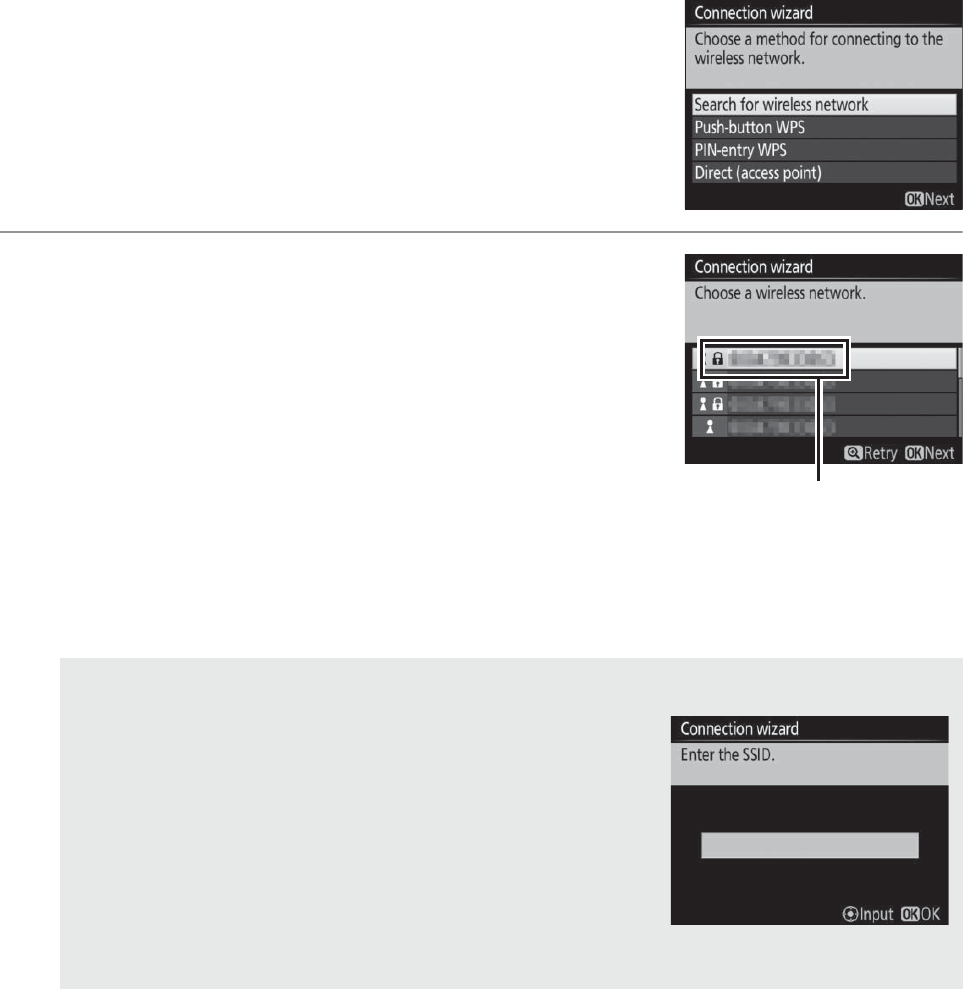
24 Transfer, Control, and HTTP
Wireless Connections
❚❚ Search for Wireless Network
Select Search for wireless network in Step 6
on page 23 to choose from a list of the
networks (wireless LAN access points)
detected by the camera.
1Choose a network.
Highlight a network SSID and press J (if
the desired network is not displayed,
press X to search again). Encrypted
networks are indicated by a h icon; if the
selected network is encrypted, you will
be prompted to enter the encryption key
as described in Step 2. If the network is not encrypted,
proceed to Step 3.
AHidden SSIDs
Networks with hidden SSIDs are indicated
by blank entries in the network list. If you
highlight a blank entry and press J, you will
be prompted to provide the network name;
press the center of the multi selector, enter a
name, and then press J to proceed to
Step 2.
SSID
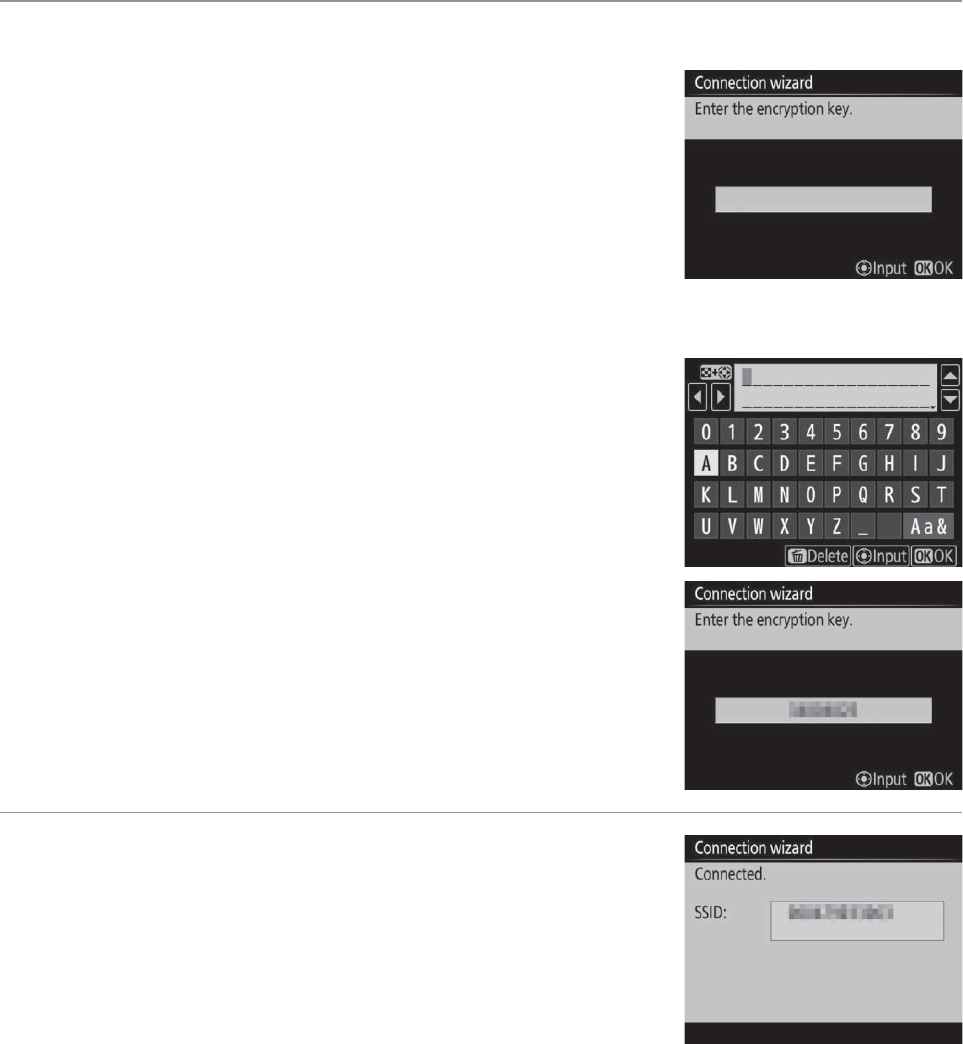
25Transfer, Control, and HTTP
Wireless Connections
2Enter the encryption key.
Press the center of the multi selector and
enter the encryption key as described in
the camera manual (if the camera is a
touch-screen model, you can enter
characters by tapping the letters on the
on-screen keyboard).
Press J when entry is complete.
Press J to establish a connection.
3Choose your next step.
The message at right is displayed when a
connection is established. Proceed to
page 29.
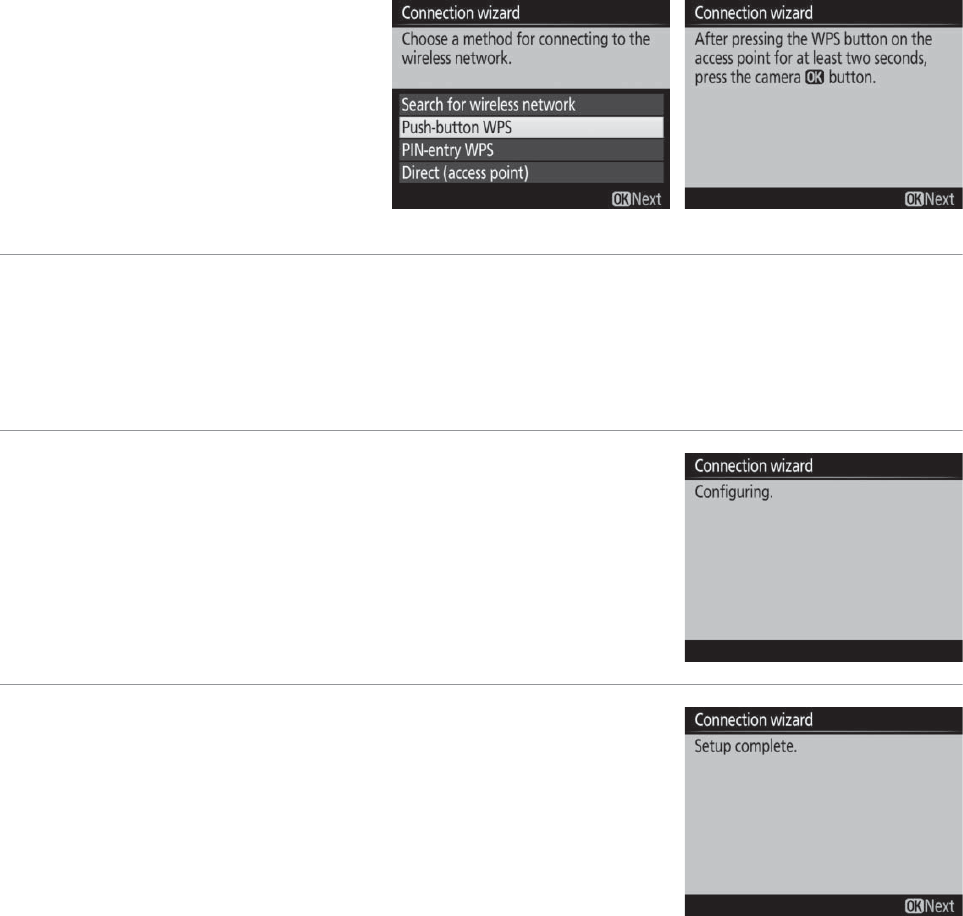
26 Transfer, Control, and HTTP
Wireless Connections
❚❚ Push-Button WPS
Choose Push-button
WPS in Step 6 on page 23
if the wireless LAN access
point uses push-button
WPS.
1Press the WPS button on the wireless LAN access point.
For more information, see the documentation provided with
the wireless LAN access point.
2Press J button on the camera.
The camera will connect to the access
point automatically.
3Choose your next step.
The message at right is displayed when a
connection is established. Press J and
proceed to page 29.
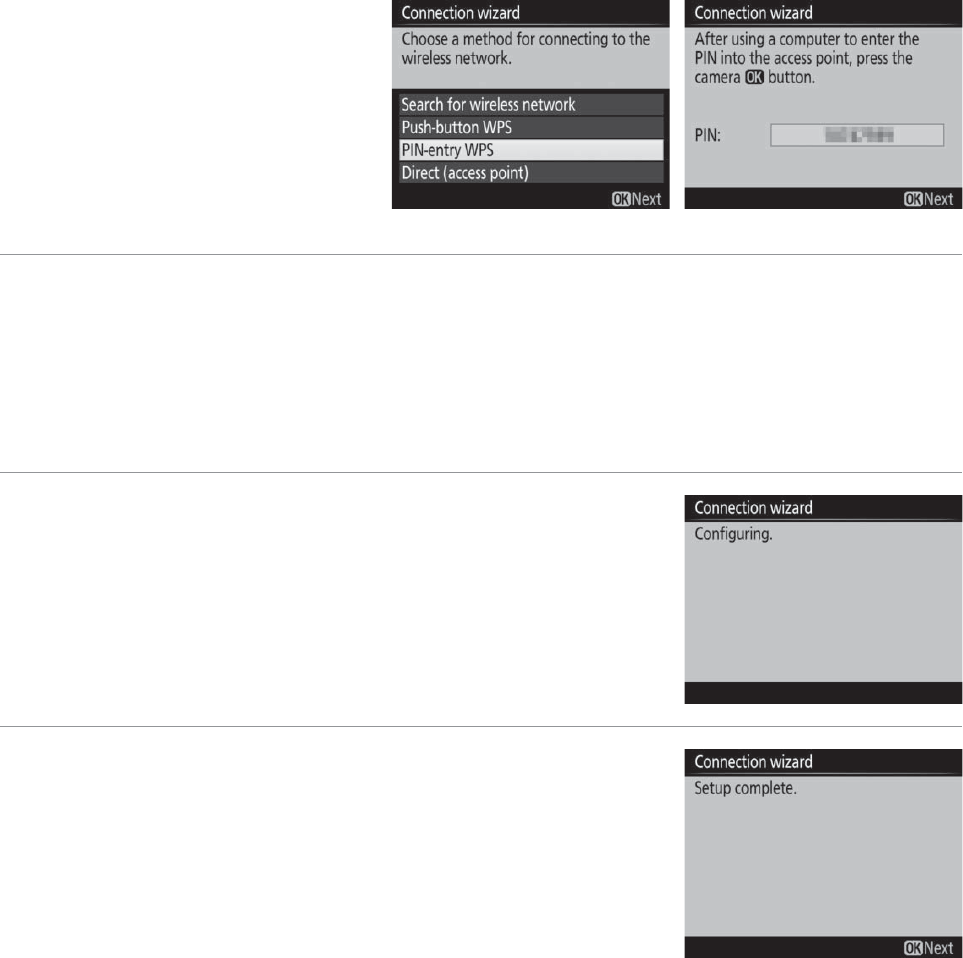
27Transfer, Control, and HTTP
Wireless Connections
❚❚ PIN-Entry WPS
Choose PIN-entry WPS
in Step 6 on page 23 if
the wireless LAN access
point uses PIN-entry
WPS.
1Enter the PIN for the wireless LAN access point.
From a computer, enter the PIN for the wireless LAN access
point. For more information, see the documentation provided
with the wireless LAN access point.
2Press J button on the camera.
The camera will connect to the access
point automatically.
3Choose your next step.
The message at right is displayed when a
connection is established. Press J and
proceed to page 29.
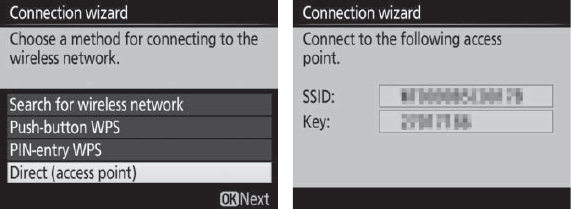
28 Transfer, Control, and HTTP
Wireless Connections
❚❚ Direct (Access Point)
Selecting Direct (access
point) in Step 6 on
page 23 enables access
point mode, in which the
camera serves as a
wireless access point. The
camera SSID and encryption key will be displayed in the monitor.
On the computer or smart device, enter the SSID and encryption
key displayed in the camera monitor. If you selected Image
transfer or Camera control mode in Step 4 on page 22, proceed
to Step 3 on page 30. If you selected HTTP server mode, proceed
to Step 5 on page 31.
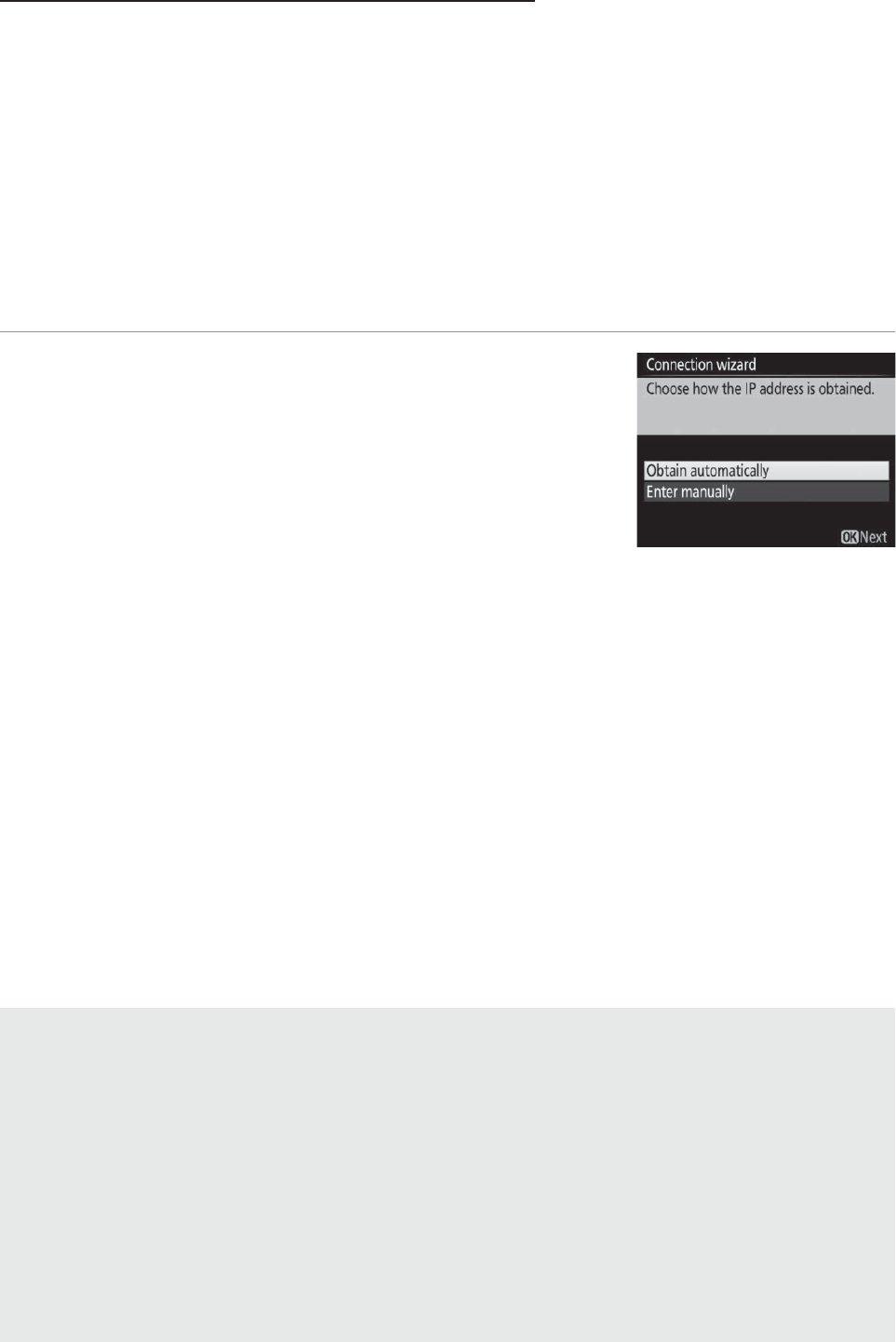
29Transfer, Control, and HTTP
Wireless Connections
Step 4: Network Settings
If you selected Search for wireless network, Push-button WPS,
or PIN-entry WPS in Step 6 on page 23, choose an IP address. If
you selected Direct (access point), your next step will depend on
the connection type selected in Step 4 on page 22:
•If you selected Image transfer or Camera control mode,
proceed to Step 3.
•If you selected HTTP server mode, proceed to Step 5.
1Obtain or select an IP address.
Highlight one of the following options
and press J.
•Obtain automatically: Select this option if
the network is configured to supply the
IP address automatically.
•Enter manually: When prompted, enter an IP address and
subnet mask by pressing 4 and 2 to highlight segments
and 1 and 3 to change. Press J to proceed when entry is
complete.
ARouters
Connection to computers on other networks via a router is supported
only when HTTP server is selected.
AMAC Address Filtering
If the network uses MAC address filtering, the filter must be supplied
with the MAC address of the WT-7. After attaching the WT-7 to the
camera, choose Network > Options > MAC address from the camera
setup menu and note the MAC address.
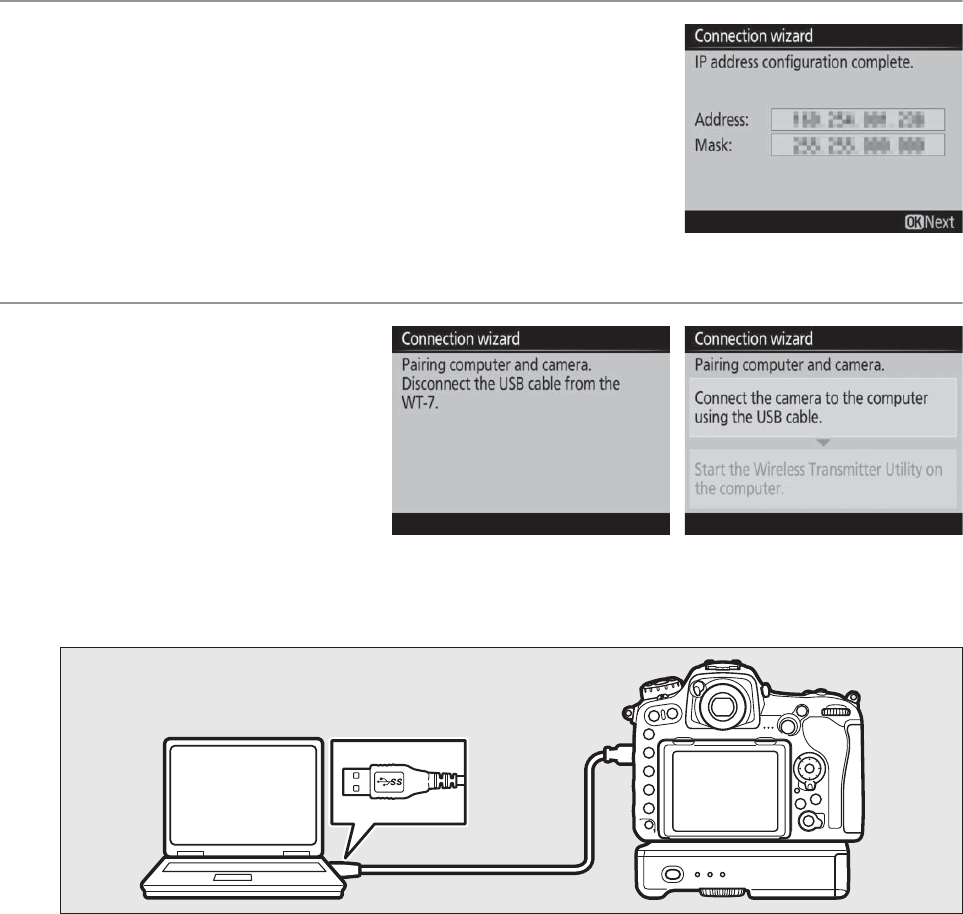
30 Transfer, Control, and HTTP
Wireless Connections
2Confirm the IP address.
The camera IP address will be displayed
as shown at right; press J. If Image
transfer or Camera control is selected,
proceed to Step 3; otherwise, proceed to
Step 5.
3Connect the
camera to the
computer.
Disconnect the USB
cable from the WT-7
and connect it to the
computer.
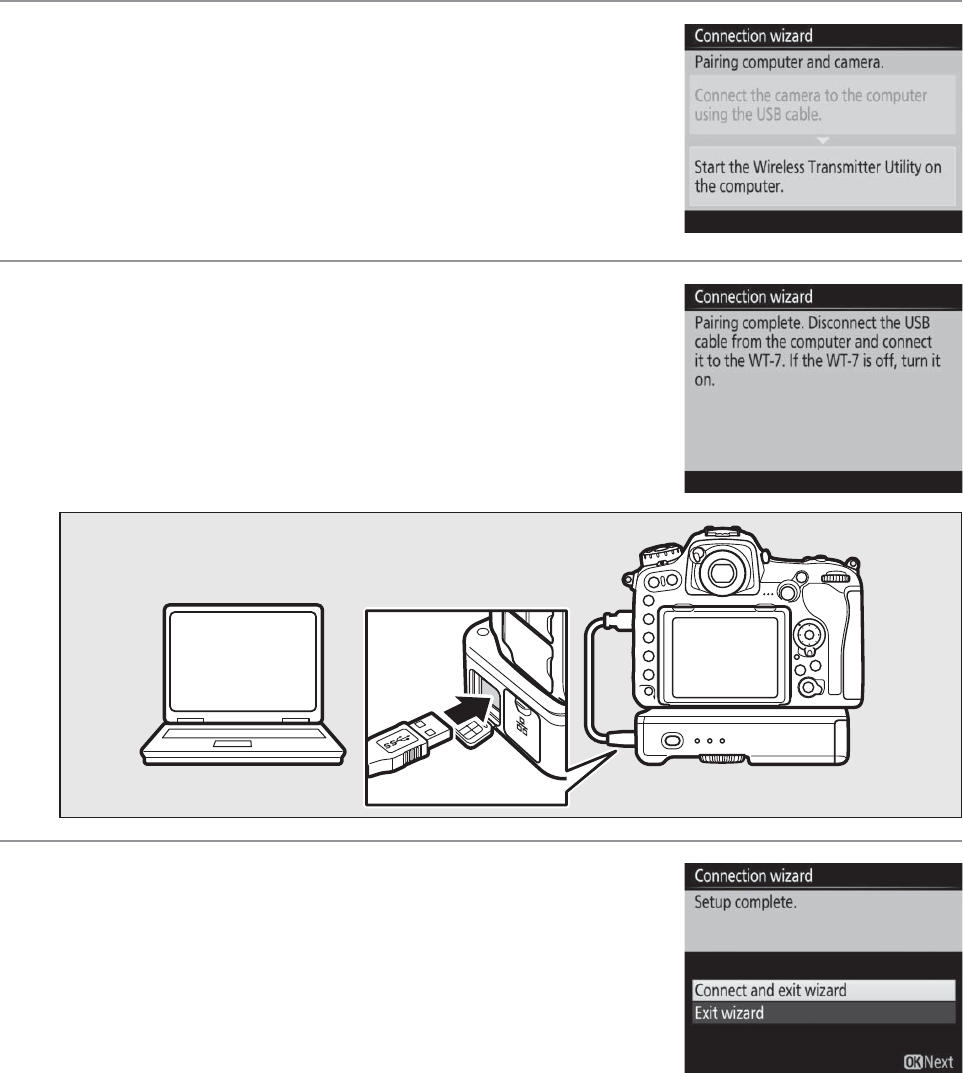
31Transfer, Control, and HTTP
Wireless Connections
4Start the Wireless Transmitter Utility.
When prompted, start the copy of the
Wireless Transmitter Utility installed on
the computer (06). Pairing will begin
automatically.
5Disconnect the camera.
The message at right will be displayed
when pairing is complete. Disconnect the
USB cable from the computer and
reconnect it to the WT-7.
6Exit the wizard.
Highlight one of the following options
and press J.
•Connect and exit wizard: Save the new
network profile and connect to the
network.
•Exit wizard: Save the new network profile and exit.
Proceed to “Image Transfer” (032), “Camera Control” (037), or
“HTTP Server” (040).
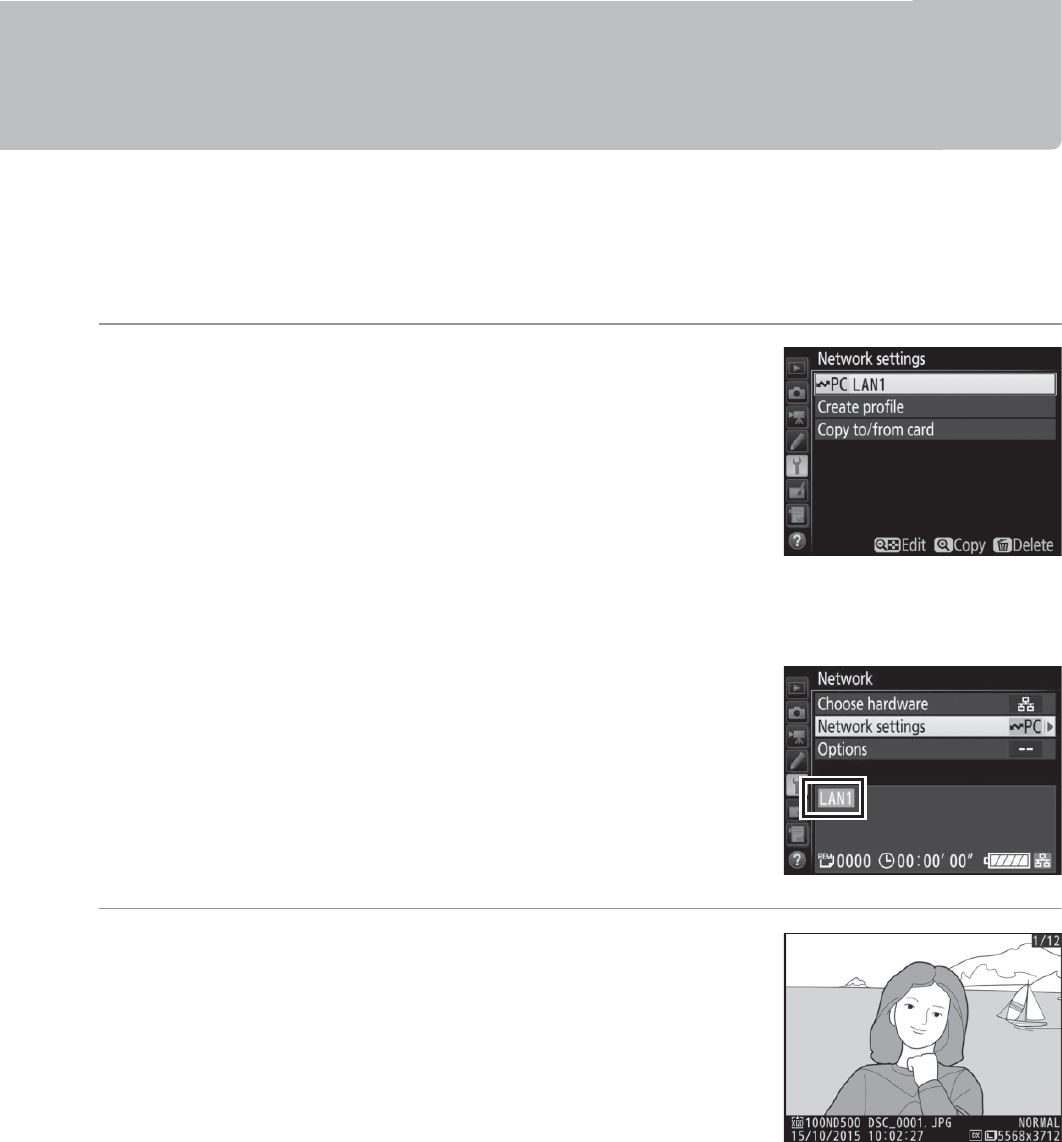
32 Transfer, Control, and HTTP
Image Transfer
Image Transfer
Image transfer is used to upload photographs and movies to the
computer from a camera memory card. The explanation that
follows assumes that existing pictures are used.
1Display network profiles.
In the setup menu, select Network >
Network settings to display the profiles
list. Image transfer profiles are indicated
by a K icon. Highlight a profile and
press J to select the highlighted profile
and return to the network menu.
The profile name will be displayed in
green when a connection is established.
2View pictures.
Press the K button to view pictures.
Display the first picture to be sent in
single-image playback or highlight it in
the thumbnail list.
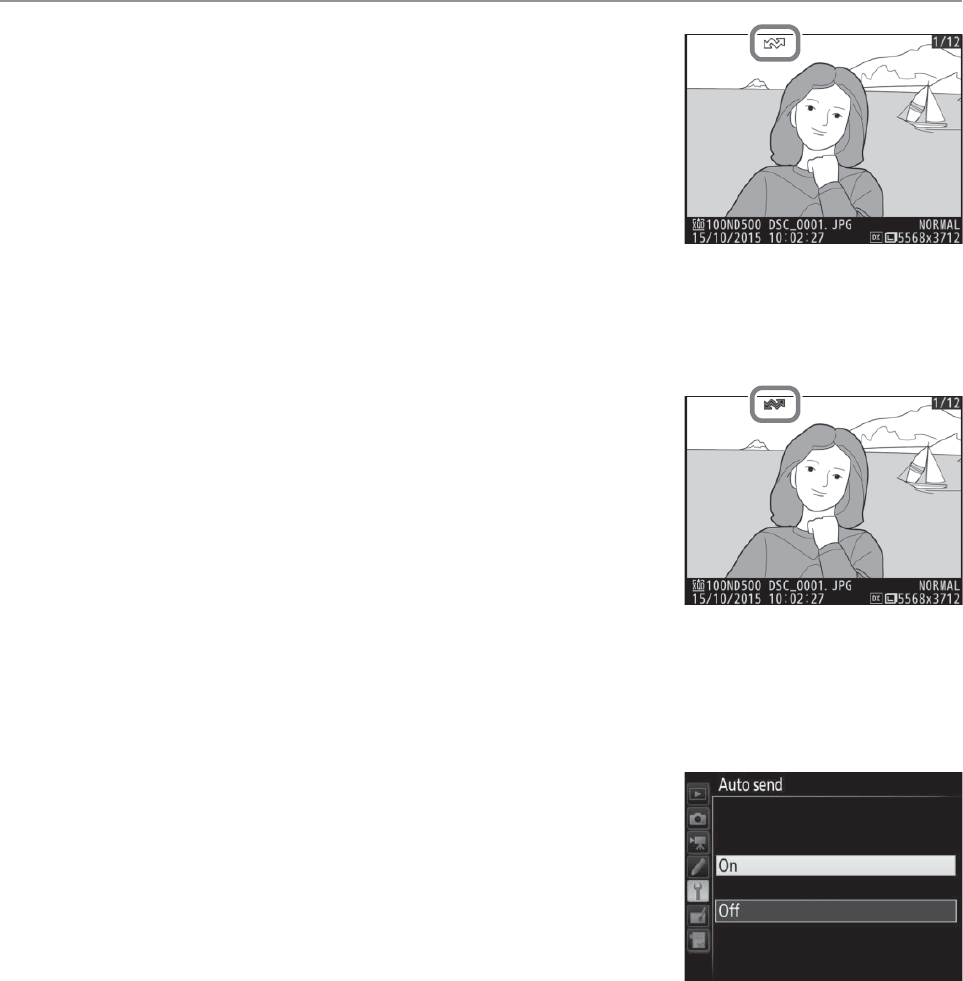
33Transfer, Control, and HTTP
Image Transfer
3Upload pictures.
Press J and the center of the multi
selector. A white transfer icon will appear
on the picture and upload will begin
immediately. The transfer icon turns
green during upload, and turns blue
when upload is complete. Additional pictures will be
uploaded in the order selected.
To upload a picture that has already been
uploaded once, press J and the center of
the multi selector once to remove the
blue transfer icon, and then press J and
the center of the multi selector again to
mark the image with a white transfer
icon.
Uploading New Photographs as They Are Taken
To upload new photographs as they are taken,
select On for Network > Options > Auto send in
the setup menu (089).

34 Transfer, Control, and HTTP
Image Transfer
Interrupting Transmission/Removing Transfer Marking
To cancel transmission of images marked with white or green
transfer icons, select the images during playback and press J and
the center of the multi selector. The transfer icon will be removed.
Any of the following actions will also interrupt transmission:
•Turning the camera off
•Selecting Yes for Network > Options > Deselect all? (091; this
option also removes transfer marking from all images)
DDuring Upload
Do not remove the memory card or disconnect the Ethernet cable
during upload.
AInterval Timer Photography
Upload will be interrupted if the standby timer expires while interval
timer photography is in progress. Choose a long standby time before
starting the interval timer.
ALoss of Signal
Wireless transmission may be interrupted if the signal is lost, but can be
resumed by turning the camera off and then on again.
ATurning the Camera Off
“Send” marking will be saved if the camera or WT-7 is turned off while
transmission is in progress. Transmission of images marked with a
“send” icon will resume when the camera or WT-7 is turned on.
ADestination Folders
By default, images are uploaded to the following folders:
•Windows: \Users\(user name)\Pictures\Wireless Transmitter Utility
•Mac: /Users/(user name)/Pictures/Wireless Transmitter Utility
The destination folder can be selected using the Wireless Transmitter
Utility.
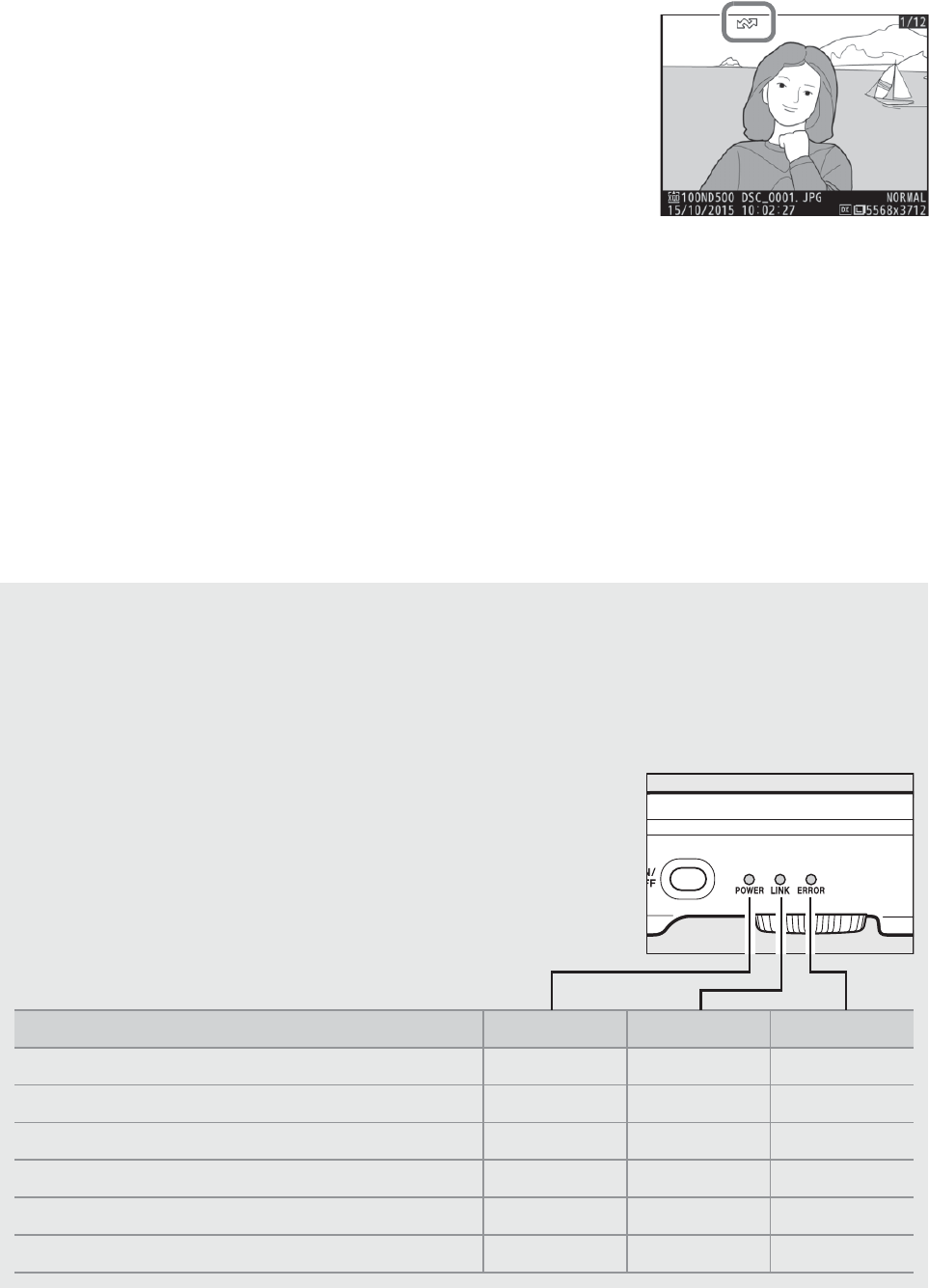
35Transfer, Control, and HTTP
Image Transfer
Transfer Status
During playback, the status of images selected for upload is shown
as follows:
a: “Send”
Images that have been selected for upload
are marked with a white a icon.
b: “Sending”
A green b icon is displayed during upload.
c: “Sent”
Images that have been uploaded successfully are marked with a
blue c icon.
ANetwork Status
The status of the link between the host and the WT-7 is shown by the
status LEDs and by the display in the top level of the network menu.
The Status LEDs
Status POWER LINK ERROR
WT-7 off I (off) I (off) I (off)
USB cable not connected K (on) I (off) I (off)
Connecting to host K (on) K (on) I (off)
Waiting to send or sending data K (on) H (flashes) I (off)
Connection error K (on) I (off) H (flashes)
WT-7 hardware or battery malfunction H (flashes) H (flashes) H (flashes)
The POWER LED lights when the WT-7 is on.
Signal quality is shown by the LINK LED: the
faster the LED flashes, the better the signal and
the faster data can be transmitted. The ERROR
LED flashes to show that an error has occurred.
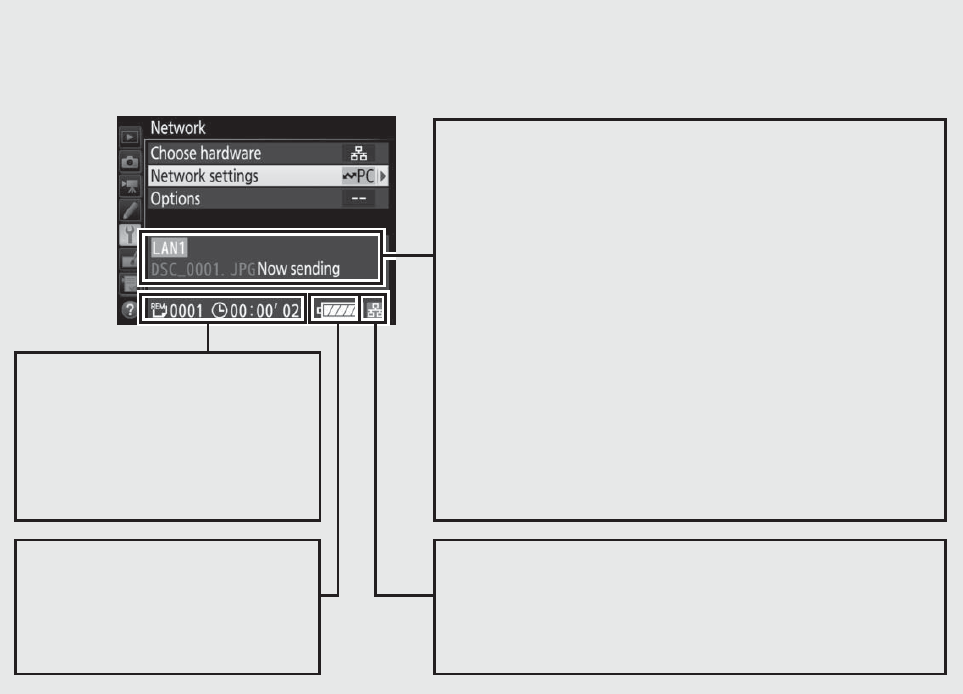
36 Transfer, Control, and HTTP
Image Transfer
The Status Display
Network status can also be viewed in the top level of the network menu.
Signal strength: Wireless signal
strength. Ethernet connections are
shown by d.
Status area: The status of the
connection to the host. The host
name is displayed in green when a
connection is established. While files
are being transferred, the status
display shows “Now sending”
preceded by the name of the file
being sent. Any errors that occur
during transfer are also displayed
here (0105).
e, f: The estimated
time required to
send the remaining
images.
Battery level: The
charge state of the
battery in the WT-7.
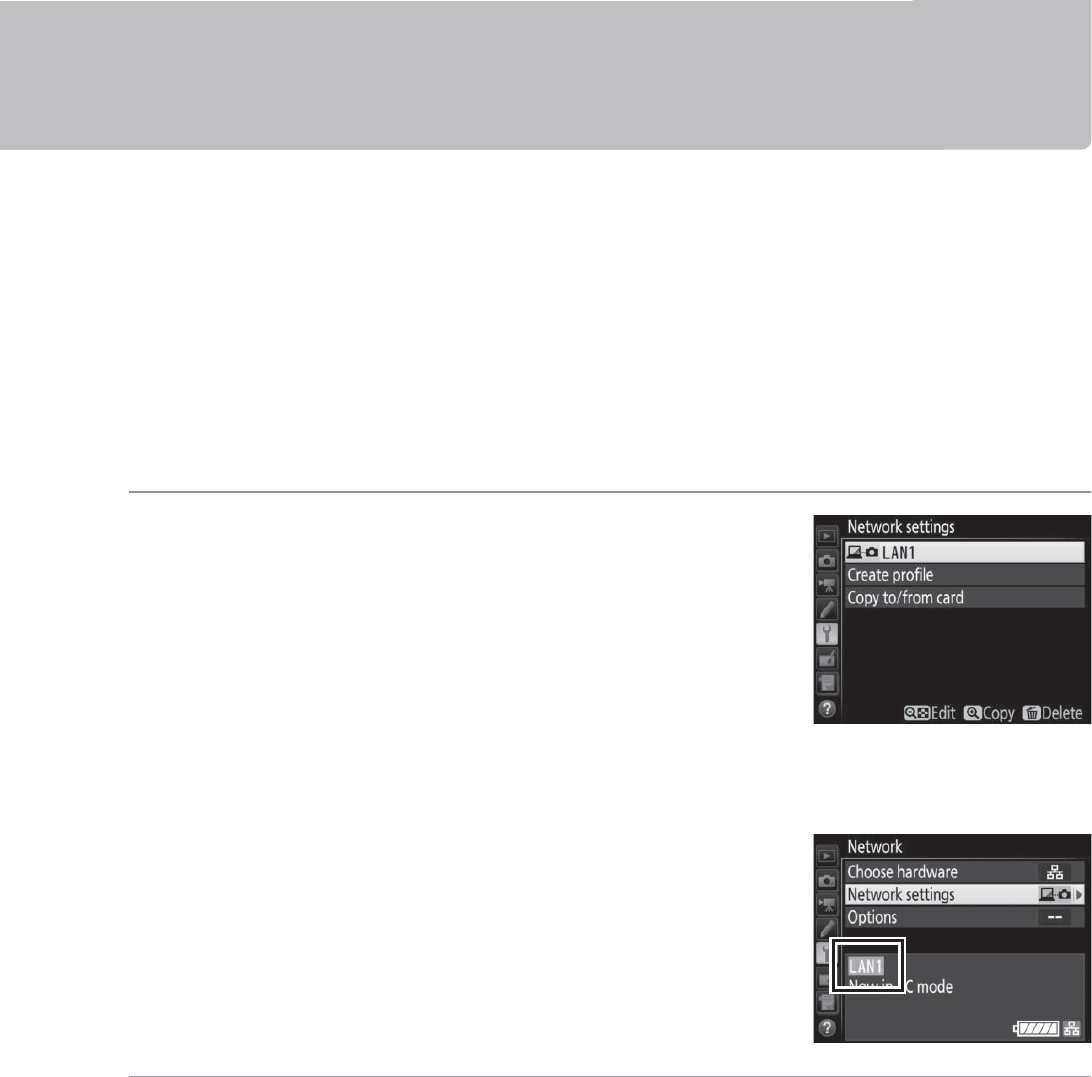
37Transfer, Control, and HTTP
Camera Control
Camera Control
Select this option to control the camera from a computer running
Camera Control Pro 2 (available separately) and save photographs
directly to the computer hard disk instead of the camera memory
card (movies will still be saved to the camera memory card; insert a
memory card before shooting movies). Note that the camera
standby timer do not turn off when the camera is in camera
control mode.
1Display network profiles.
In the setup menu, select Network >
Network settings to display the profiles
list. Camera control profiles are indicated
by a L icon. Highlight a profile and
press J to select the highlighted profile
and return to the network menu.
The profile name will be displayed in
green when a connection is established.
2Start Camera Control Pro 2.
Start the copy of Camera Control Pro 2 (available separately)
installed on the host computer. For information on using
Camera Control Pro 2, see the Camera Control Pro 2 manual
(pdf).
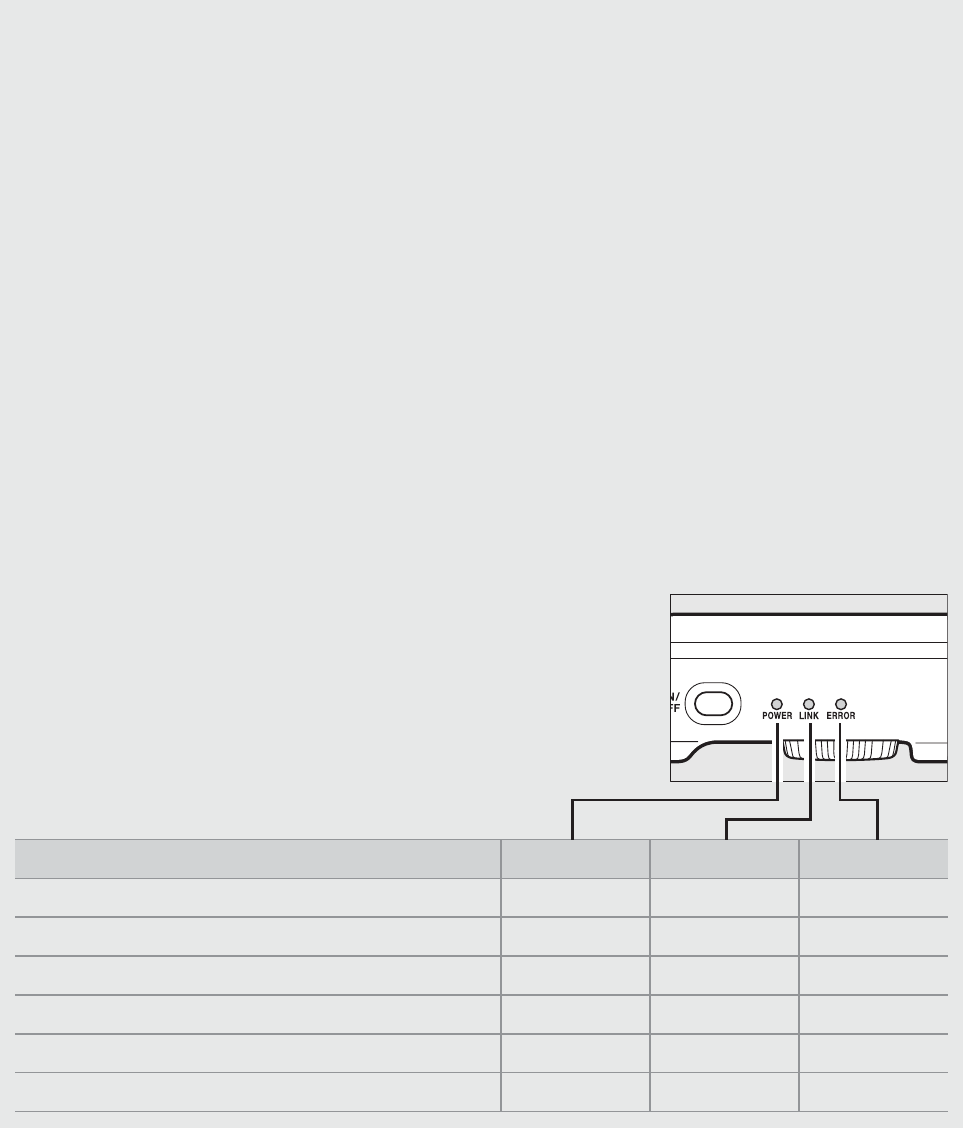
38 Transfer, Control, and HTTP
Camera Control
AEthernet Networks
Do not disconnect the Ethernet cable while the camera is on.
DWireless Networks
Operations may take longer on wireless networks. If the signal is
disrupted while pictures are being transferred to Camera Control Pro 2,
the LED on the WT-7 will flash orange; turn the camera off and then on
again. Transfer will resume when the connection is re-established. Note
that transfer can not be resumed if you turn the camera off again before
transfer is complete.
ANetwork Status
The status of the link between the host and the WT-7 is shown by the
status LEDs and by the display in the top level of the network menu.
The Status LEDs
Status POWER LINK ERROR
WT-7 off I (off) I (off) I (off)
USB cable not connected K (on) I (off) I (off)
Connecting to host K (on) K (on) I (off)
Waiting to send or sending data K (on) H (flashes) I (off)
Connection error K (on) I (off) H (flashes)
WT-7 hardware or battery malfunction H (flashes) H (flashes) H (flashes)
The POWER LED lights when the WT-7 is on.
Signal quality is shown by the LINK LED: the
faster the LED flashes, the better the signal and
the faster data can be transmitted. The ERROR
LED flashes to show that an error has occurred.
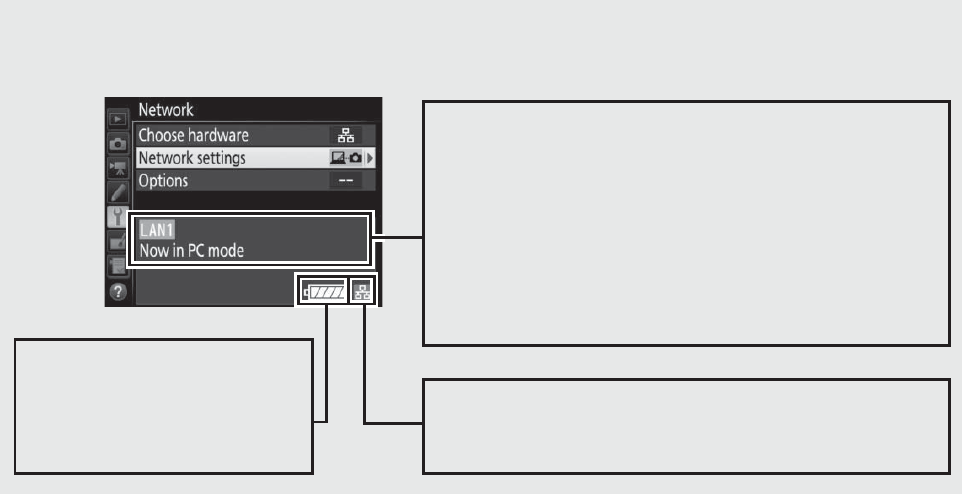
39Transfer, Control, and HTTP
Camera Control
The Status Display
Network status can also be viewed in the top level of the network menu.
Signal strength: Wireless signal strength.
Ethernet connections are shown by d.
Status area: The status of the connection
to the host. The host name is displayed
in green when a connection is
established. Any errors that occur
during transfer are also displayed here
(0105).
Battery level: The
charge state of the
battery in the WT-7.
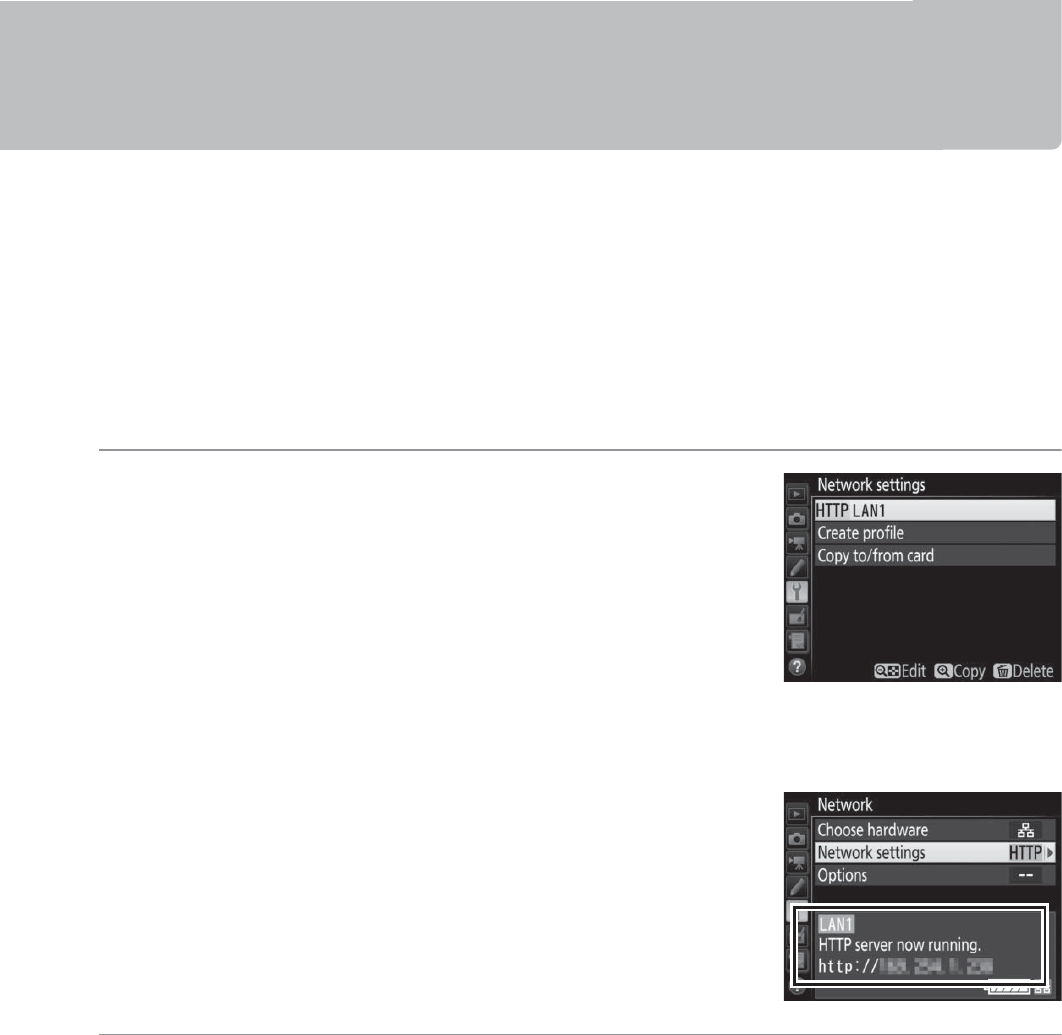
40 Transfer, Control, and HTTP
HTTP Server
HTTP Server
Select HTTP server to view the pictures on the camera memory
card or take photographs from the web browser on a computer or
smart device (see page 45 for system requirements). Up to five
users can access the camera at one time, although only one can
take photographs or edit text. Note that the standby timer do not
turn off automatically when the camera is in http server mode.
1Display network profiles.
In the setup menu, select Network >
Network settings to display the profiles
list. HTTP server profiles are indicated by
a M icon. Highlight a profile and press
J to select the highlighted profile and
return to the network menu.
The URL used for connection to the
camera is displayed when a connection
is established.
2Launch the web browser.
Launch the web browser on the computer or smart device.
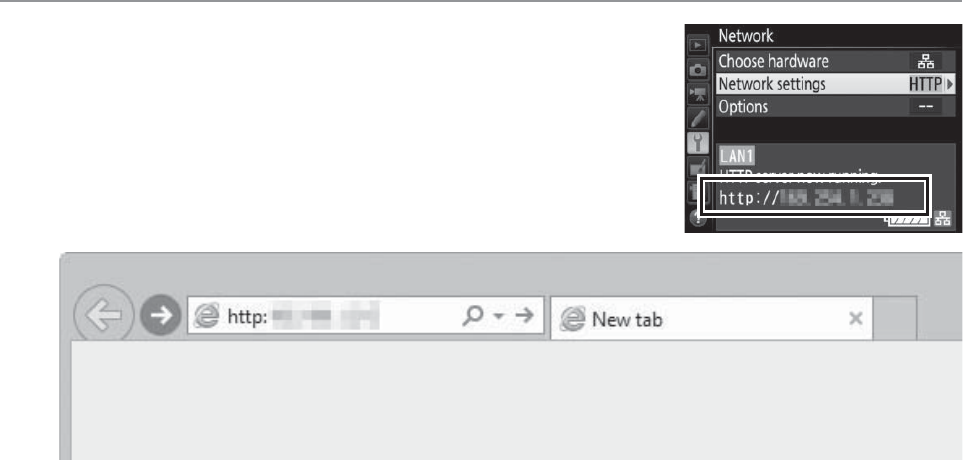
41Transfer, Control, and HTTP
HTTP Server
3Enter the camera URL.
Enter the camera URL (“http://” followed
by the camera IP address, as shown in the
network menu) in the browser window
address field.
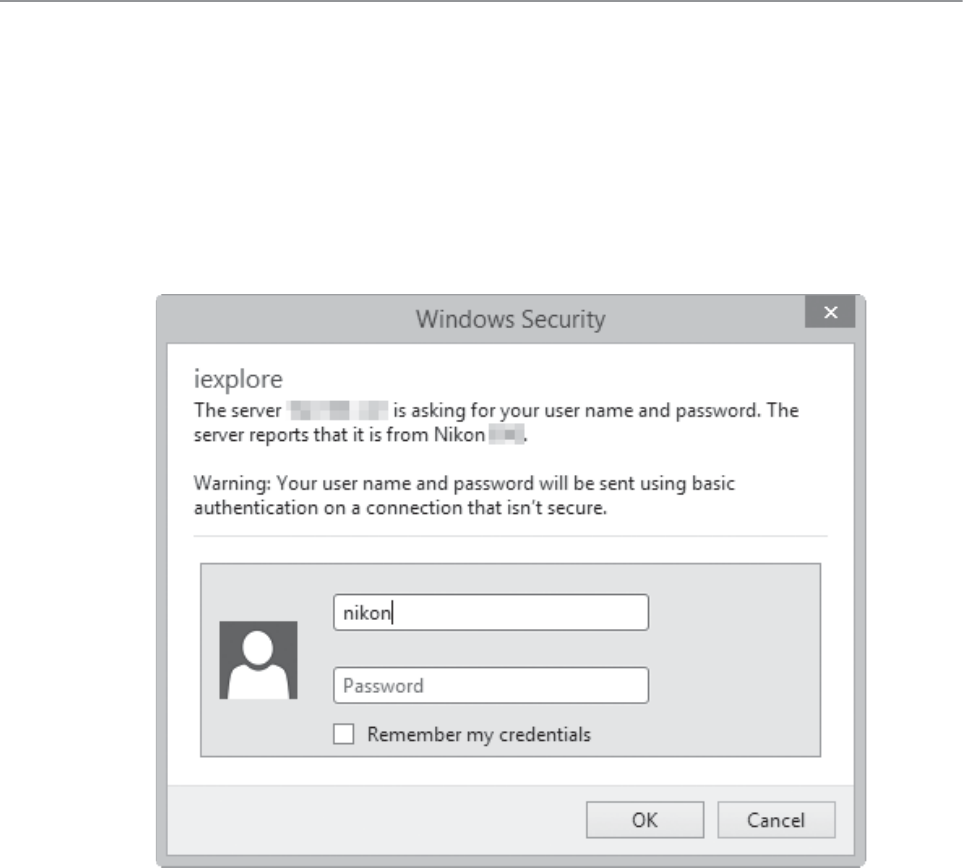
42 Transfer, Control, and HTTP
HTTP Server
4Log in.
Enter your user name and password in the web browser login
dialog (the user name and password are set using Network
settings > Options > HTTP user settings in the network
menu as described on page 91; the default user name is
“nikon” while the default password is blank).
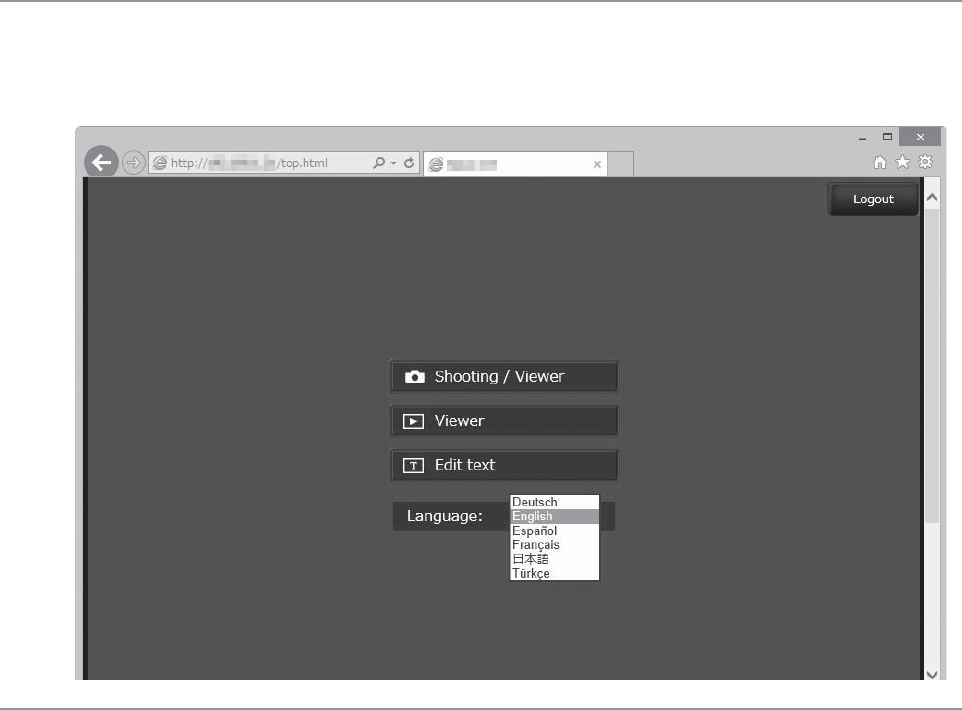
43Transfer, Control, and HTTP
HTTP Server
5Choose a language.
Click Language.
6Choose an operating mode.
Choose Shooting/Viewer to take pictures (046, 53) and
Shooting/Viewer or Viewer to view existing pictures (048,
55). To use the computer or smart device web browser to edit
image comments and copyright and IPTC information stored
on the camera, select Edit text (050, 57). Up to five users at a
time can connect using Viewer, but only one user at a time
can connect using Shooting/Viewer or Edit text (if another
user is already connected using Shooting/Viewer or Edit
text, these options will not be displayed and only four users
will be able to connect using Viewer).
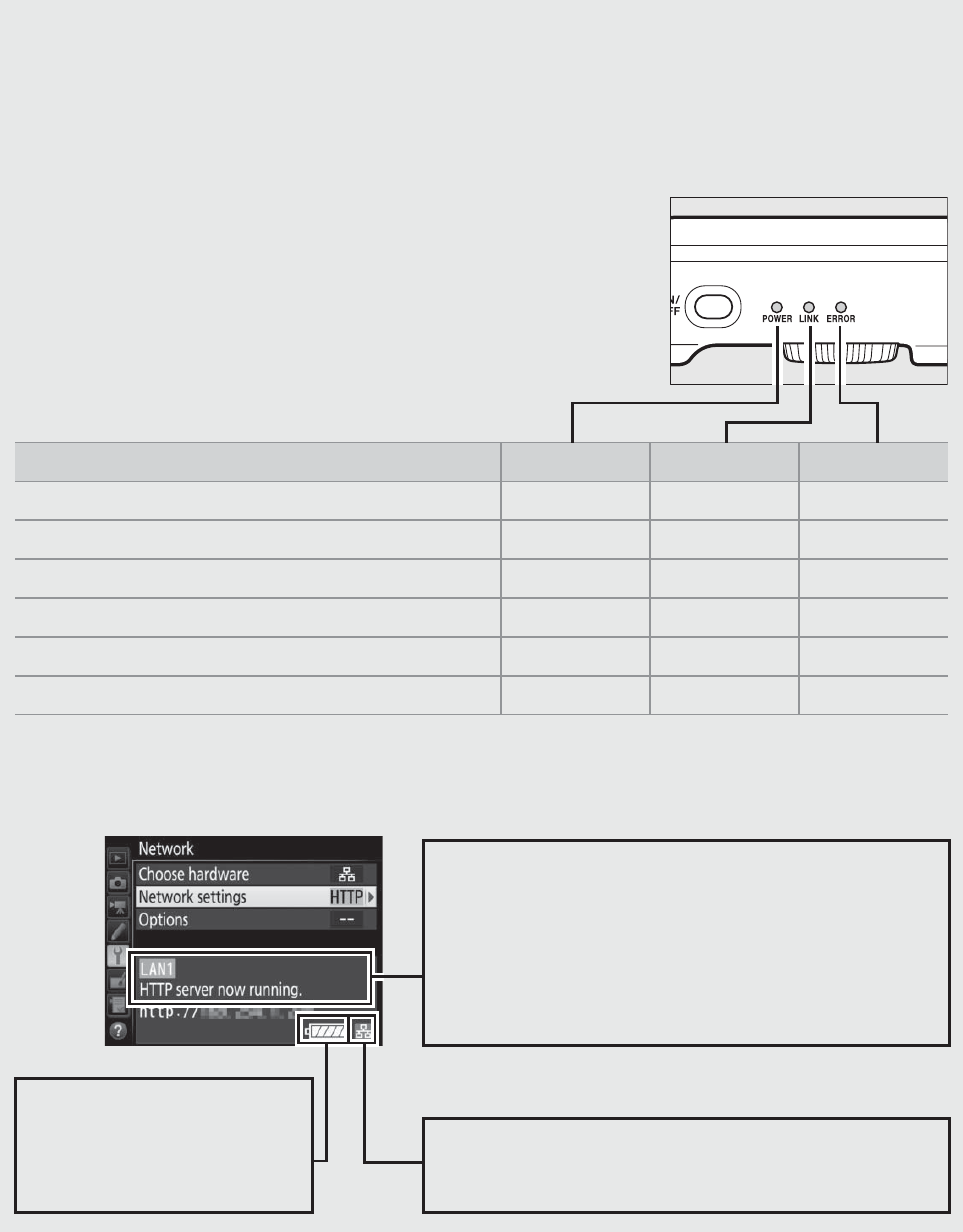
44 Transfer, Control, and HTTP
HTTP Server
ANetwork Status
The status of the link between the host and the WT-7 is shown by the
status LEDs and by the display in the top level of the network menu.
The Status LEDs
Status POWER LINK ERROR
WT-7 off I (off) I (off) I (off)
USB cable not connected K (on) I (off) I (off)
HTTP server starting up K (on) K (on) I (off)
HTTP server in operation K (on) H (flashes) I (off)
Connection error K (on) I (off) H (flashes)
WT-7 hardware or battery malfunction H (flashes) H (flashes) H (flashes)
The Status Display
Network status can be viewed in the top level of the network menu.
The POWER LED lights when the WT-7 is on.
Signal quality is shown by the LINK LED: the
faster the LED flashes, the better the signal and
the faster data can be transmitted. The ERROR
LED flashes to show that an error has occurred.
Signal strength: Wireless signal strength.
Ethernet connections are shown by d.
Status area: The status of the connection
to the host. The camera URL is
displayed in green when a connection
is established. Errors are also displayed
here (0105).
Battery level: The
charge state of the
battery in the WT-7.

45Transfer, Control, and HTTP
HTTP Server
AHTTP Server System Requirements
Operation has been confirmed with the following systems:
Windows
OS Windows 10, Windows 8.1, Windows 7
Browser
•Windows 10: Microsoft Edge
•Windows 8.1: Internet Explorer 11
•Windows 7: Internet Explorer 10
Monitor
•Resolution: 1,024 × 768 pixels (XGA) or more; 1,280 × 1,024
pixels (SXGA) or more recommended
•Color: 24-bit color (True Color) or more
Mac
OS OS X version 10.11, 10.10, or 10.9
Browser
•OS X version 10.11: Safari 9
•OS X version 10.10: Safari 8
•OS X version 10.9: Safari 7
Monitor
•Resolution: 1,024 × 768 pixels (XGA) or more; 1,280 × 1,024
pixels (SXGA) or more recommended
•Color: 24-bit color (millions of colors) or more
Android OS
OS Android 5.0, 4.4
Browser Chrome
iOS
OS iOS 9, iOS 8
Browser The version of Safari included with the operating system
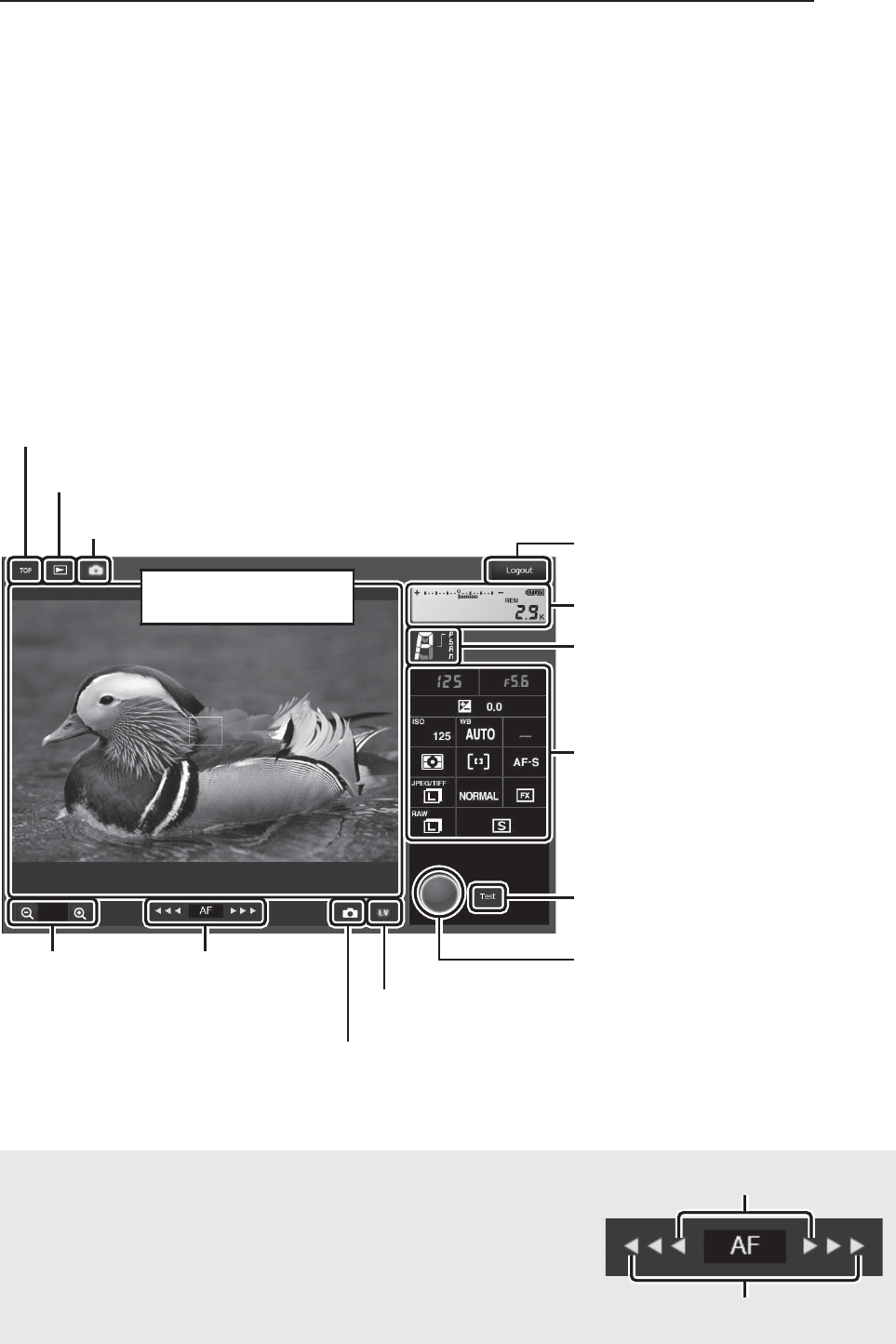
46 Transfer, Control, and HTTP
HTTP Server
Computer and Android Web Browsers
This section describes the http server displays for computer and
Android web browsers (note that the display varies with the model
of camera). Click or tap to adjust camera settings. For information
on the displays for iPhones, see page 53.
The Shooting Window
The following controls can be accessed by selecting Shooting/
Viewer on the server home page. To display the view through the
camera lens in the viewfinder area, tap or click the live view
button. Tap or click the button again to exit live view.
AFocus Buttons
The size of the focus adjustment increases with
the distance of the button from the center of
the display.
Display panel (047)
Camera settings (047)
Exposure mode
Test button (047)
Shutter button (047)
Still photography/movie button
Logout button
Home button (043)
Shoot button
Zoom buttons Focus buttons
Live view button
Viewfinder
View button (048)
Small
Large

47Transfer, Control, and HTTP
HTTP Server
Display panel Contains the exposure indicator and shows the battery
level and number of exposures remaining.
Camera settings Click or tap icons to adjust settings for photography or
movie recording. See the camera manual for details.
Shutter button
Take a photograph or start and end movie recording. To
focus, click or tap the desired subject in the viewfinder
area.
Test button
Take a test photo and display it in the viewfinder
without recording it to the camera memory card. Not
available in movie live view.
AEnabling Live View on the Camera
When the view through the camera lens is displayed in the viewfinder
area, pressing the camera a button will display the view through the
lens in the camera monitor. Press the button again to end live view on
the camera.
AThe Release Mode Button
Clicking or tapping the live view button enables the
release mode button, which can be used to choose
from single-frame, high-speed continuous, and low-
speed continuous release modes. In high- and low-
speed continuous release modes, the camera takes
photographs while the shutter button is pressed.
Release mode
button
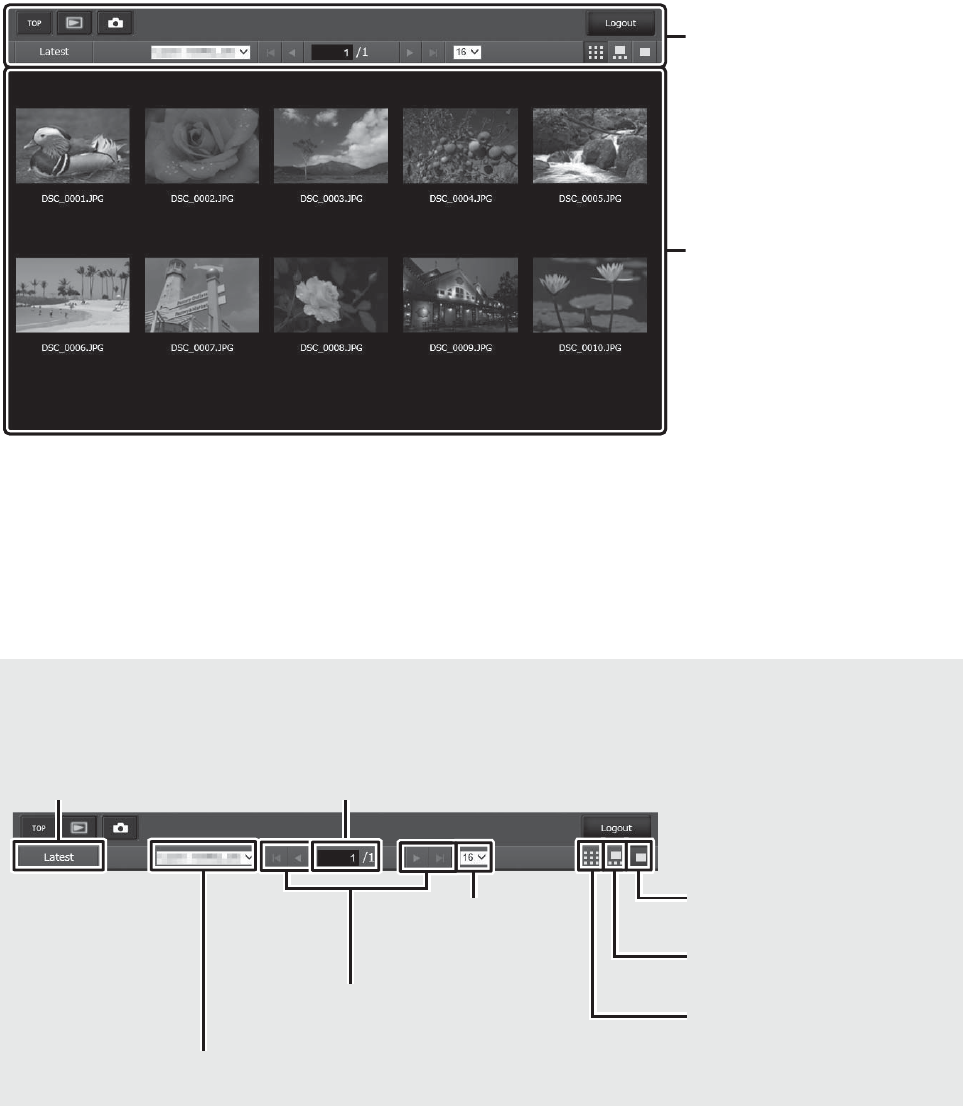
48 Transfer, Control, and HTTP
HTTP Server
The Viewer Window
The viewer window can be accessed by selecting Viewer on the
server home page or clicking or tapping the view button in the
shooting window. The viewer window offers a choice of
thumbnail, film-strip (049), and full-frame views (049).
❚❚ Thumbnail View
View multiple small (“thumbnail”) images per page. The controls at
the top of the window can be used for navigation.
ANavigation Controls
Navigation controls
Thumbnails (click or tap
to view pictures full
frame). Movies are
indicated by 1.
Page number
Full-frame view (049)
Film-strip view (049)
Thumbnail view
View most recent
picture in folder
Thumbnails per
page
Page controls
Folder selection
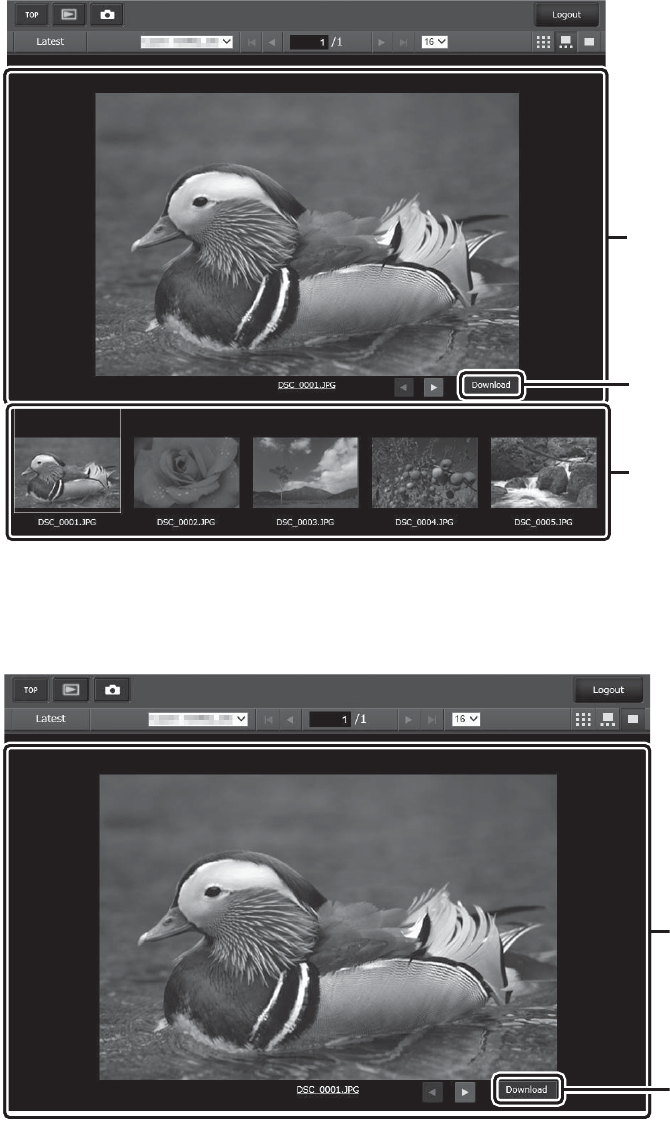
49Transfer, Control, and HTTP
HTTP Server
❚❚ Film-Strip View
Choose the picture displayed from the thumbnails at the bottom
of the window.
❚❚ Full-Frame View
View pictures full frame.
Current picture (click or tap 4
or 2 to view additional
pictures)
Copy current picture to
computer or smart device
Thumbnails (click or tap to
select)
Current picture (click or tap
4 or 2 to view additional
pictures)
Copy current picture to
computer or smart device
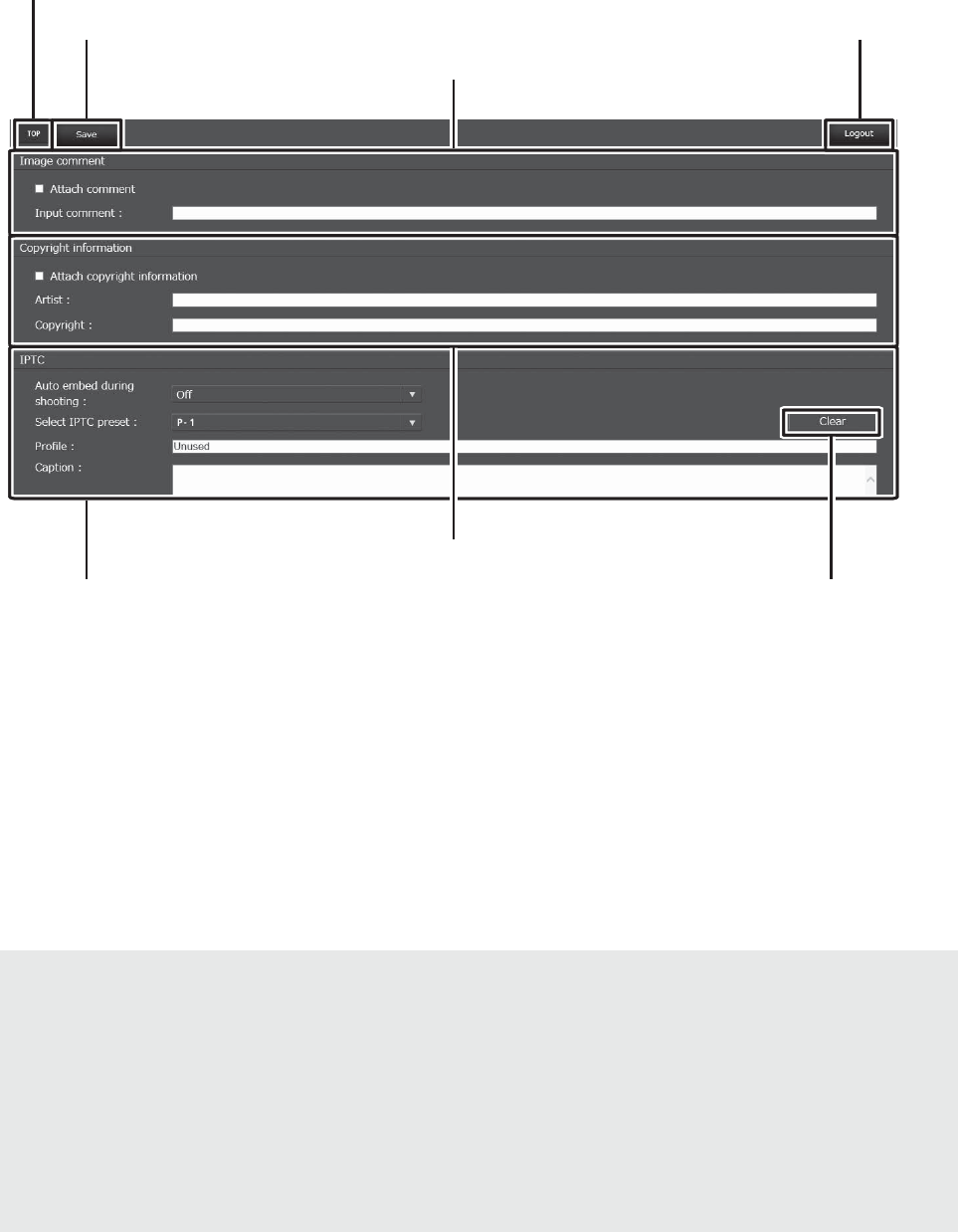
50 Transfer, Control, and HTTP
HTTP Server
❚❚ The Text Edit Window
The text edit window, which is used to edit image comments and
copyright and IPTC information stored on the camera, can be
accessed by selecting Edit text on the server home page.
DSaving Changes
Changes are not saved automatically. Click or tap the save button to
save changes.
DThe Clear Button
Clicking or tapping the clear button immediately deletes the displayed
text, even if you exit without clicking the save button.
Home button (043)
Image comment (051)
Copyright information (051)
IPTC information (052) Clear button
Save button Logout button

51Transfer, Control, and HTTP
HTTP Server
Image Comment
Create a comment that can be appended to subsequent images.
Comments can be viewed as metadata in ViewNX-i or Capture NX-D.
The following options are available:
•Attach comment: Select this option to attach the comment to all
subsequent photographs.
•Input comment: Input a comment up to 36 characters long.
Copyright Information
Add copyright information to new photographs as they are taken.
Copyright information can be viewed as metadata in ViewNX-i or
in Capture NX-D. The following options are available:
•Attach copyright information: Select this option to attach copyright
information to all subsequent photographs.
•Artist/copyright: Enter a photographer name up to 36 characters
long and a copyright holder name up to 54 characters long.
Viewing Image Comments and Copyright Information on the
Camera
Image comments and copyright information can be viewed during
full-frame playback on the corresponding pages of the camera
photo information display.
ACopyright Information
To prevent unauthorized use of the artist or copyright holder names,
make sure that Attach copyright information is not selected and that
the Artist and Copyright fields are blank before lending or transferring
the camera to another person. Nikon does not accept liability for any
damages or disputes arising from the use of the Copyright
information option.

52 Transfer, Control, and HTTP
HTTP Server
IPTC Information
Embed IPTC presets in photographs as they are taken. The following
options are available:
•Auto embed during shooting: Selecting this tab displays a list of IPTC
presets; highlight a preset and press the save button to embed
the selected preset in all subsequent photographs. Select Off to
take photos with no IPTC presets.
•Select IPTC preset: Selecting this tab displays a list of IPTC presets.
Choose a preset to copy to the camera.
AIPTC Information
IPTC is a standard established by the International Press
Telecommunications Council (IPTC) with the intent of clarifying and
simplifying the information required when photographs are shared
with a variety of publications. Embedded IPTC information can be
viewed by selecting the IPTC page in the photo information display
during full-frame playback. See the camera manual for more
information.
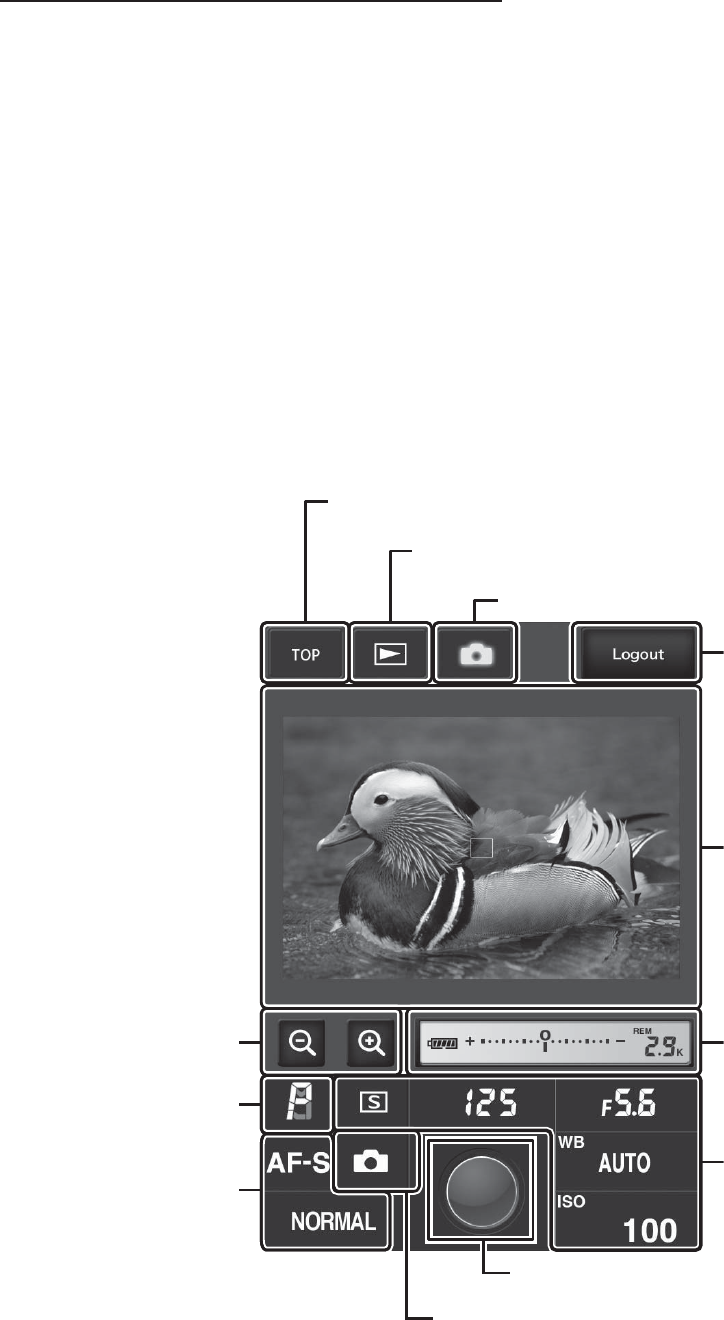
53Transfer, Control, and HTTP
HTTP Server
iPhone Web Browsers
This section describes the http server displays for iPhone web
browsers (note that the display varies with the model of camera).
Tap to adjust camera settings. For information on computer,
Android, or iPad displays, see page 46.
The Shooting Window
The following controls can be accessed by selecting Shooting/
Viewer on the server home page. Use the live view button to start
live view photography (C) or movie live view (1). The view
through the camera lens will be displayed in the viewfinder area.
To exit live view, use the live view button to turn live view off.
Display panel (047)
Shutter button (047)
Logout button
Home button (043)
Shoot button
Exposure mode
View button (055)
Zoom buttons
Camera settings
(047)
Viewfinder (tap to
focus on selected
subject)
Live view button
Camera settings
(047)

54 Transfer, Control, and HTTP
HTTP Server
AEnabling Live View on the Camera
When the view through the camera lens is displayed in the viewfinder
area, pressing the camera a button will display the view through the
lens in the camera monitor. Press the button again to end live view on
the camera.
AThe Release Mode Button
Selecting photo (C) or movie (1) live view with the
live view button enables the release mode button,
which can be used to choose from single-frame,
high-speed continuous, and low-speed continuous
release modes. In high- and low-speed continuous
release modes, the camera takes photographs while
the shutter button is pressed.
Release mode
button
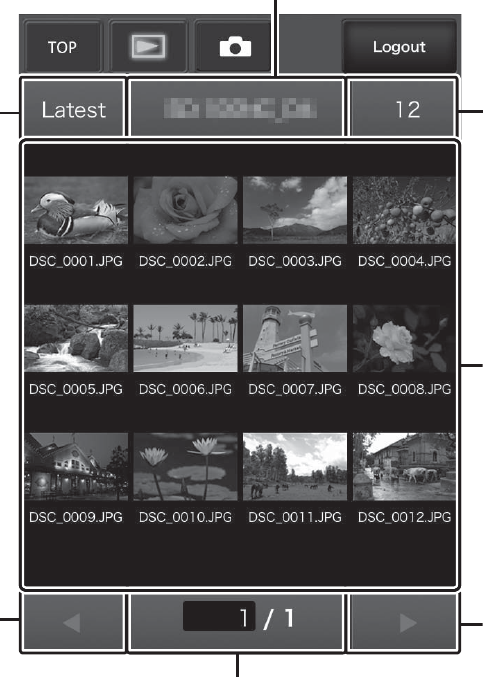
55Transfer, Control, and HTTP
HTTP Server
The Viewer Window
The viewer window can be accessed by selecting Viewer on the
server home page or tapping the view button in the shooting
window. The viewer window for iPhone web browsers offers a
choice of thumbnail and full-frame views (056).
❚❚ Thumbnail View
View multiple small (“thumbnail”) images per page. The controls at
the top and bottom of the thumbnail area can be used for
navigation.
Thumbnails (tap to
view pictures full
frame). Movies are
indicated by 1.
Next page
Thumbnails per page
Page number
Previous page
View most recent
pictures in folder
Folder selection
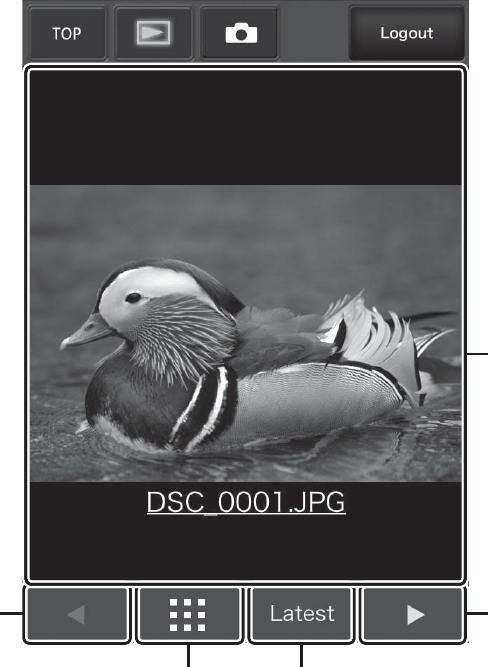
56 Transfer, Control, and HTTP
HTTP Server
❚❚ Full-Frame View
View pictures full frame.
Current picture (tap to
return to thumbnail
view)
Show next imageShow previous
image
View most recent picture in folderThumbnail view
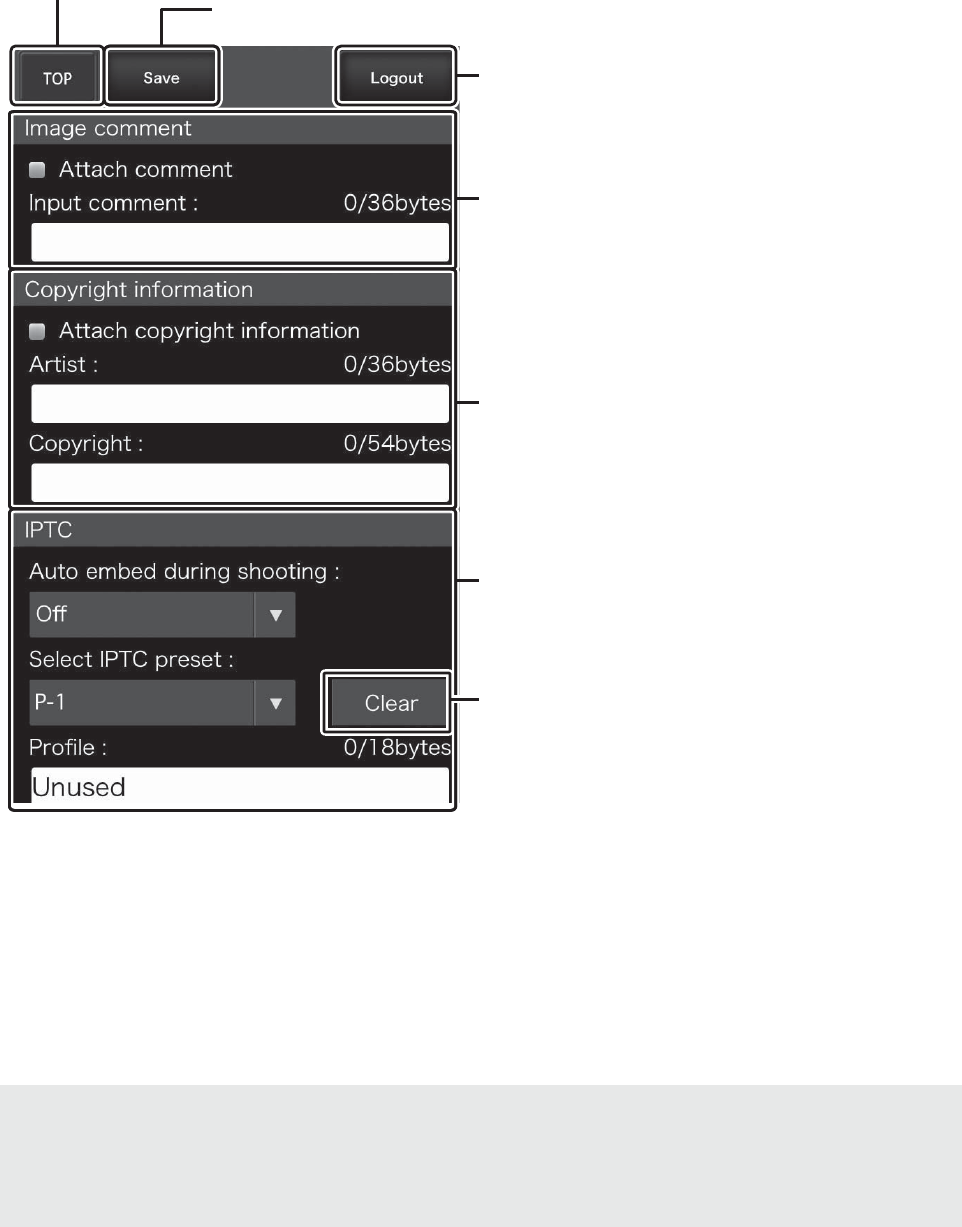
57Transfer, Control, and HTTP
HTTP Server
❚❚ The Text Edit Window
The text edit window, which is used to edit image comments and
copyright and IPTC information stored on the camera, can be
accessed by selecting Edit text on the server home page.
DSaving Changes
Changes are not saved automatically. Tap the save button to save
changes.
Home button (043)
Image comment (051)
Copyright information (051)
Save button
Logout button
IPTC information (052)
Clear button
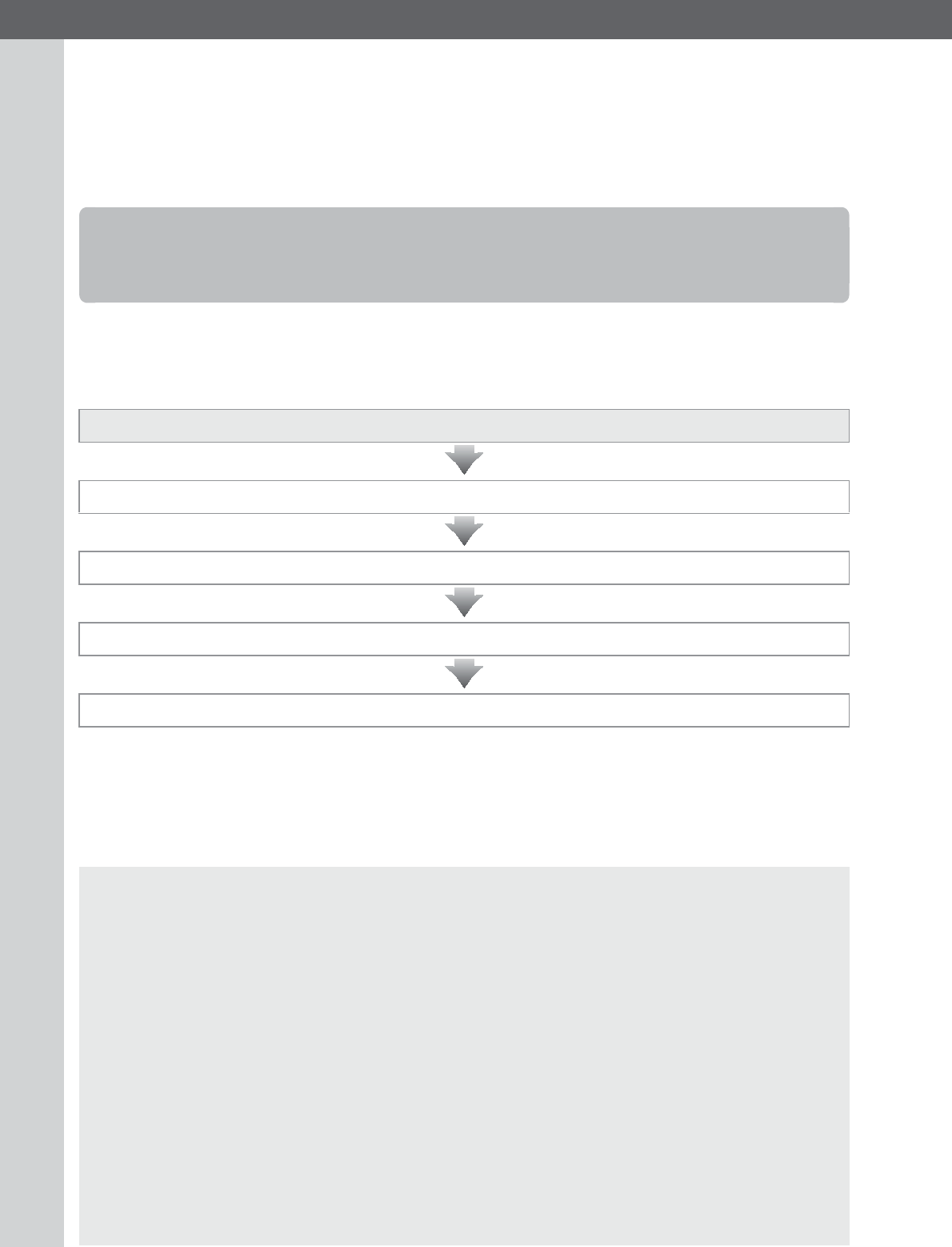
58 FTP
FTP
Follow the steps below to connect to an ftp server via an Ethernet
network. For information on wireless connections, see page 65.
Ethernet Connections
FTP server
Step 1: Connect the camera, WT-7, and ftp server (059)
Step 2: Select Ethernet (060)
Step 3: Run the connection wizard (061)
Transfer pictures (078)
DChoosing a Power Source
To prevent the camera or WT-7 powering off unexpectedly during setup
or data transfer, use fully-charged batteries or optional AC adapters
designated for use with the camera or WT-7. For more on camera power
sources, see the camera manual.
AFTP Servers
Servers can be configured using standard ftp services, such as IIS
(Internet Information Services), available with supported operating
systems (095). Connection to computers on other networks via a
router, Internet ftp connections and ftp servers running third-party
software are not supported.
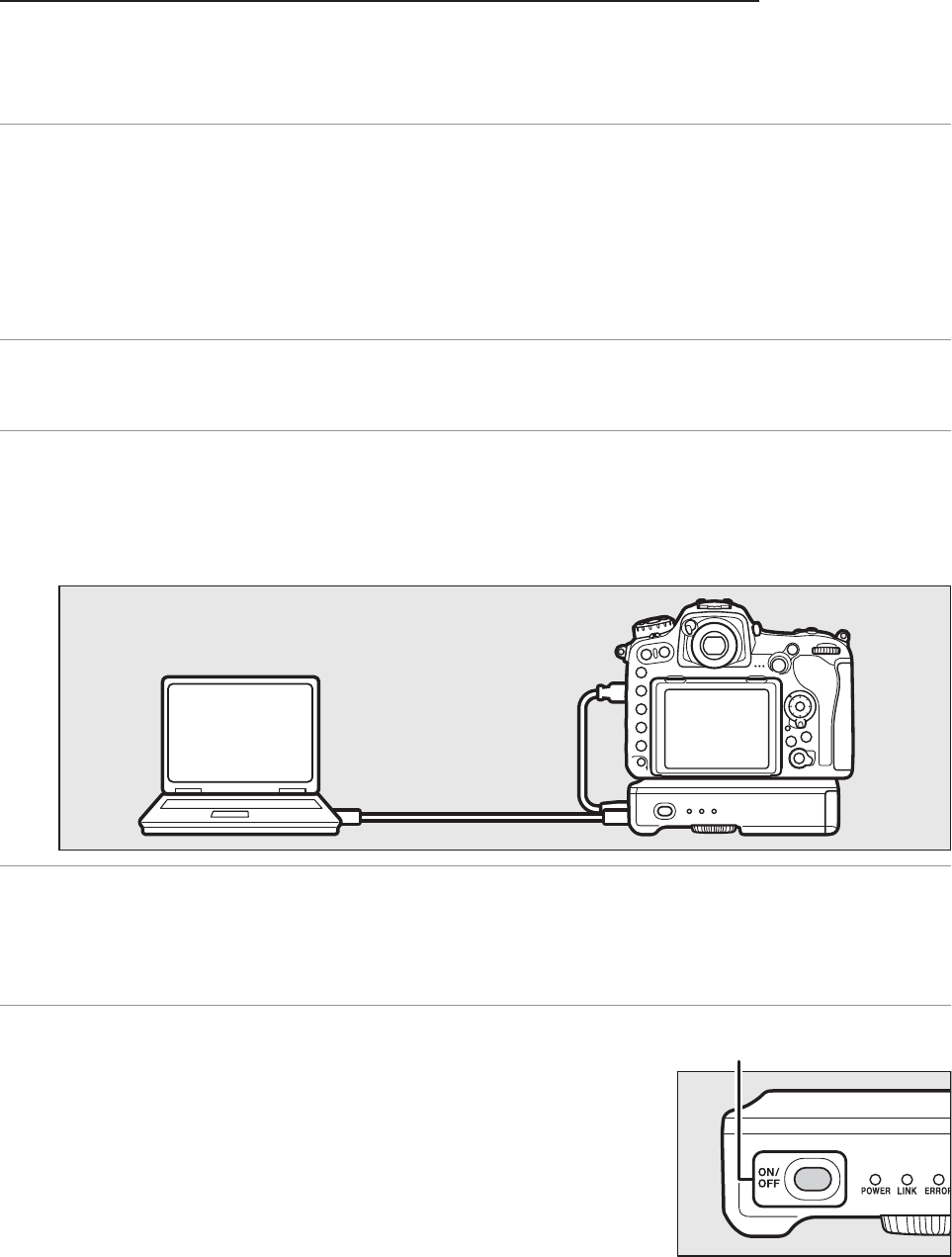
59FTP
Ethernet Connections
Step 1: Connecting the Hardware
After starting the ftp server, connect the camera as described
below.
1Insert a memory card.
Turn the camera off and insert a memory card (do not turn the
camera off or disconnect the Ethernet cable while data are
being transferred to the computer).
2Attach the WT-7 (05).
3Connect an Ethernet cable.
Connect the camera to the ftp server as shown below. Do not
use force or insert the connectors at an angle.
4Turn the camera on.
Rotate the power switch to turn the camera on.
5Press the power switch for about a
second to turn the WT-7 on.
Power switch
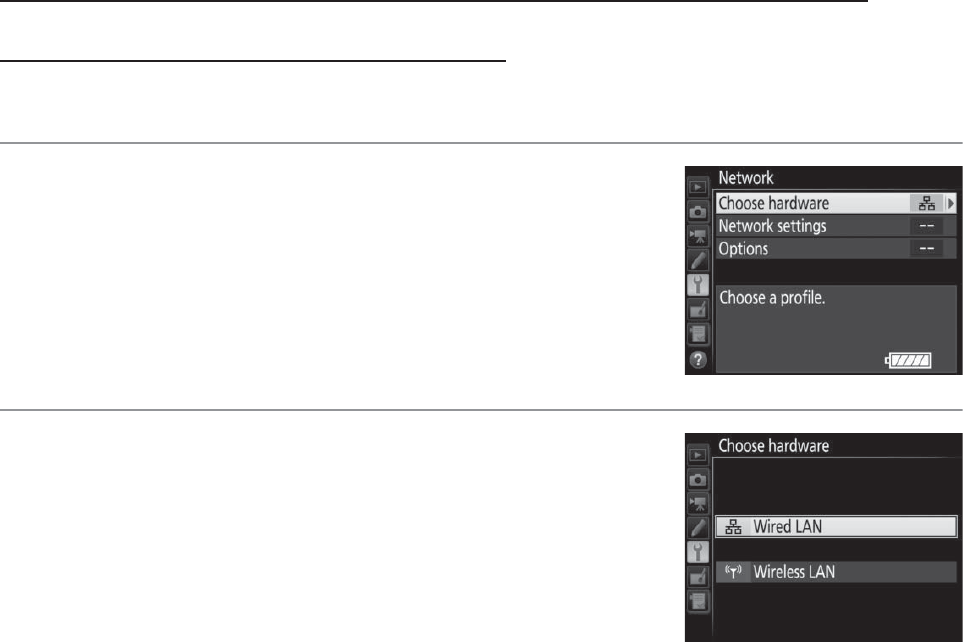
60 FTP
Ethernet Connections
Step 2: Configuring the Hardware for
Ethernet Connections
Configure the WT-7 for use with Ethernet networks.
1Select Choose hardware.
In the setup menu, select Network, then
highlight Choose hardware and press 2.
The menu offers a choice of Wired LAN
and Wireless LAN.
2Select Wired LAN.
Highlight Wired LAN and press J to
select the highlighted option and return
to the network menu.
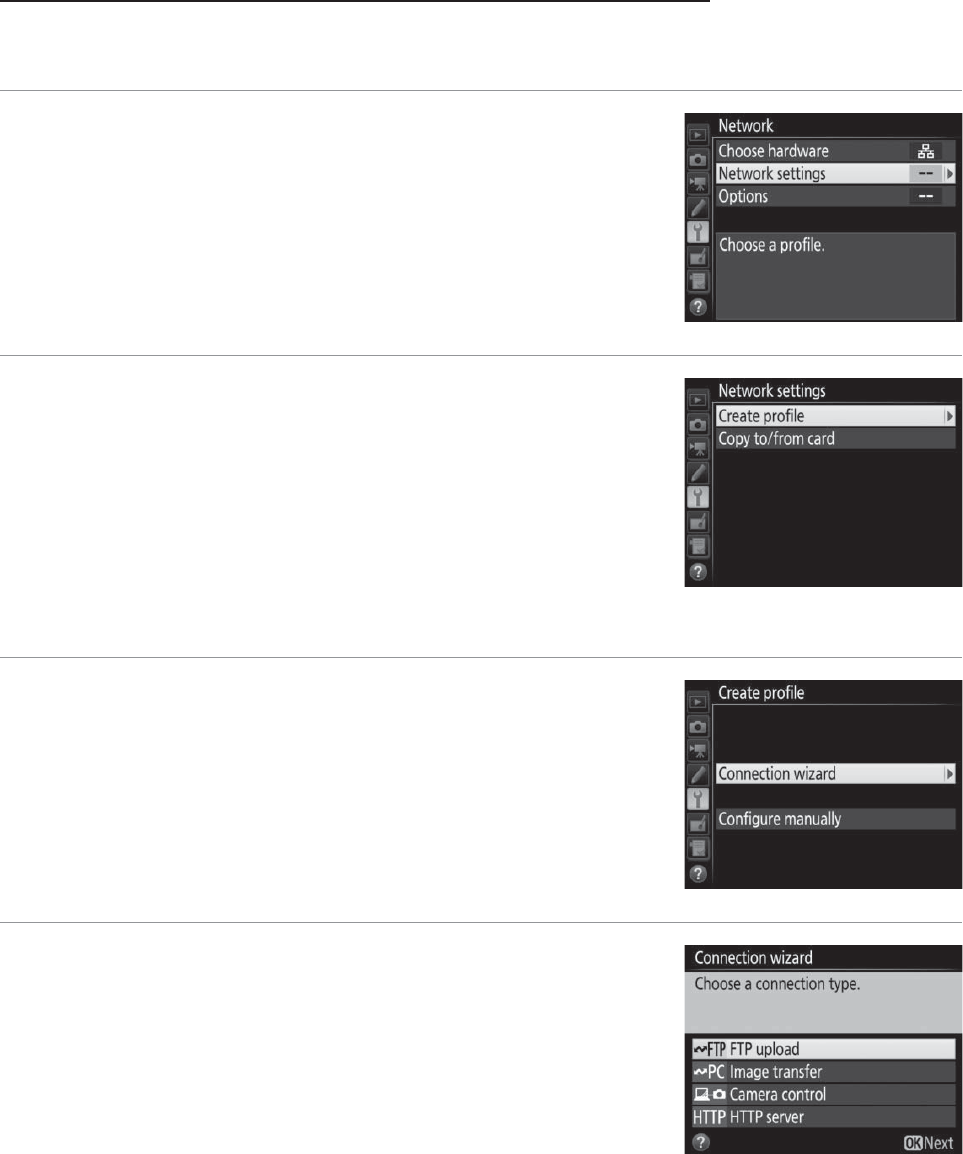
61FTP
Ethernet Connections
Step 3: The Connection Wizard
Follow the on-screen instructions to create a network profile.
1Display network profiles.
In the network menu, highlight Network
settings and press 2 to display the
profiles list and other network settings.
2Select Create profile.
Highlight Create profile and press 2.
Note that if the list already contains nine
profiles, you will need to delete an
existing profile using the O (Q) button
before proceeding (085).
3Start the connection wizard.
Highlight Connection wizard and press
2 to start the connection wizard.
4Choose a connection type.
Highlight FTP upload and press J.
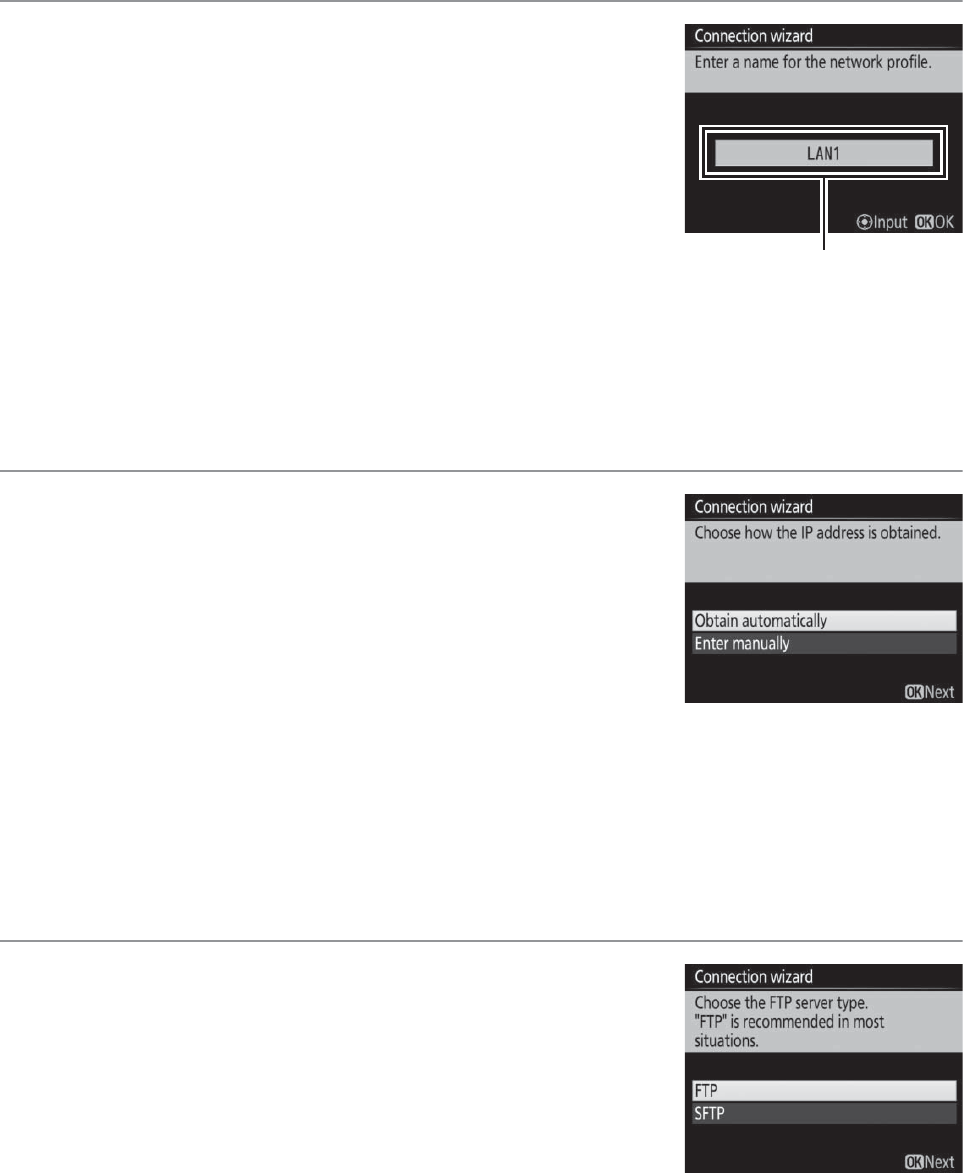
62 FTP
Ethernet Connections
5Name the new network profile.
A default profile name will be displayed;
to edit or change the name as described
in the camera manual, press the center of
the multi selector (if the camera is a
touch-screen model, you can enter
characters by tapping the letters on the
on-screen keyboard). The profile name will appear in the
Network > Network settings list in the camera setup menu.
Press J to proceed to the next step when entry is complete.
6Obtain or select an IP address.
Highlight one of the following options
and press J.
•Obtain automatically: Select this option if
the network is configured to supply the
IP address automatically.
•Enter manually: When prompted, enter an IP address and
subnet mask by pressing 4 and 2 to highlight segments
and 1 and 3 to change. Press J to proceed when entry is
complete.
7Choose the server type.
Highlight FTP or SFTP (secure ftp) and
press 2.
Profile name
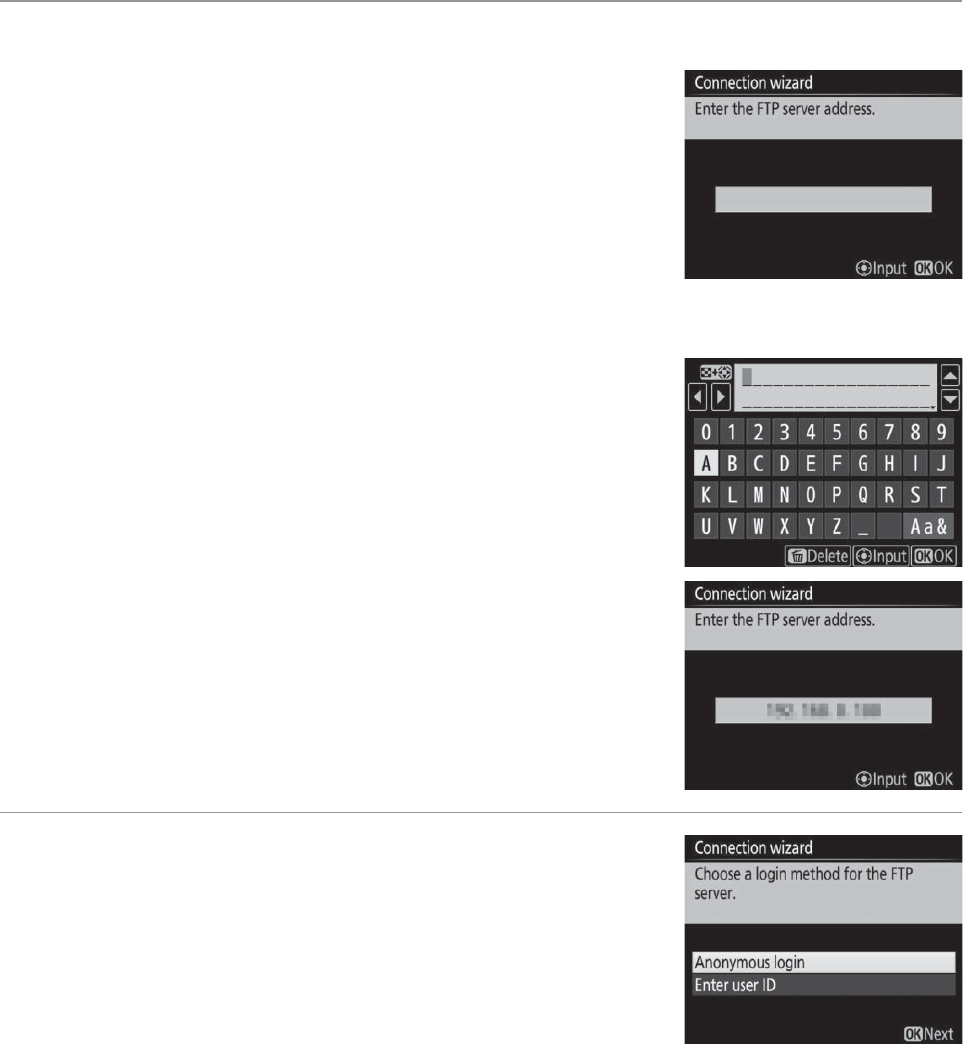
63FTP
Ethernet Connections
8Enter the IP address.
Press the center of the multi selector and
enter the server URL or IP address as
described in the camera manual (if the
camera is a touch-screen model, you can
enter characters by tapping the letters on
the on-screen keyboard).
Press J when entry is complete.
Press J again to connect to the ftp
server.
9Log in.
Highlight one of the following options
and press J.
•Anonymous login: Select this option if the
server does not require a user ID or
password.
•Enter user ID: Enter a user ID and password when prompted
and press J.
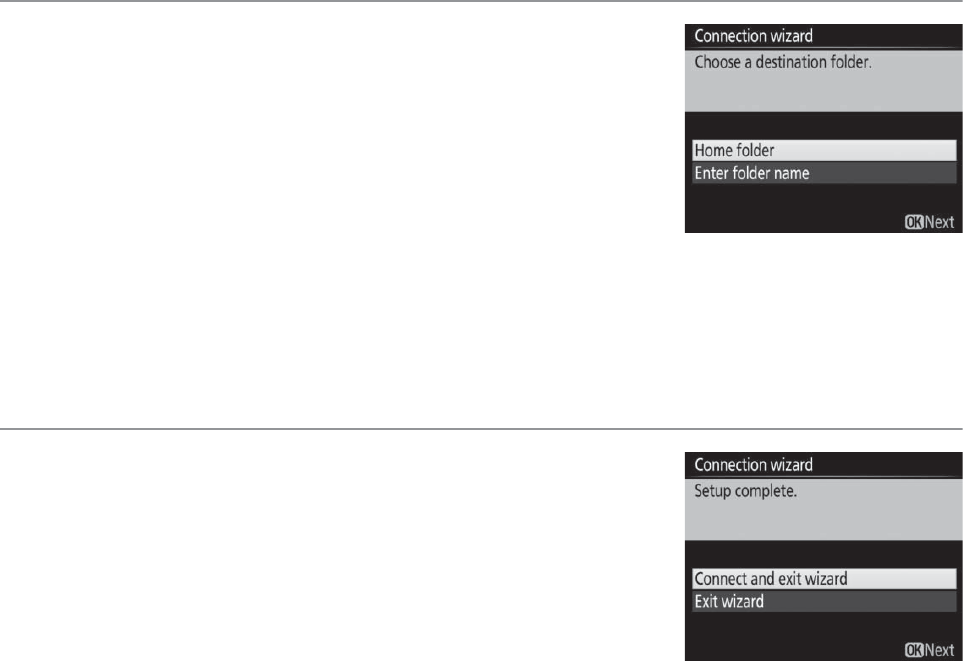
64 FTP
Ethernet Connections
10
Choose a destination folder.
Highlight one of the following options
and press J.
•Home folder: Select this option to upload
pictures to the server’s home folder.
•Enter folder name: Select this option to
upload pictures to another folder (the folder must already
exist on the server). Enter a folder name and path when
prompted and press J.
11
Exit the wizard.
Highlight one of the following options
and press J.
•Connect and exit wizard: Save the new
network profile and connect to the
server.
•Exit wizard: Save the new network profile and exit.
Proceed to “FTP Upload” (078).
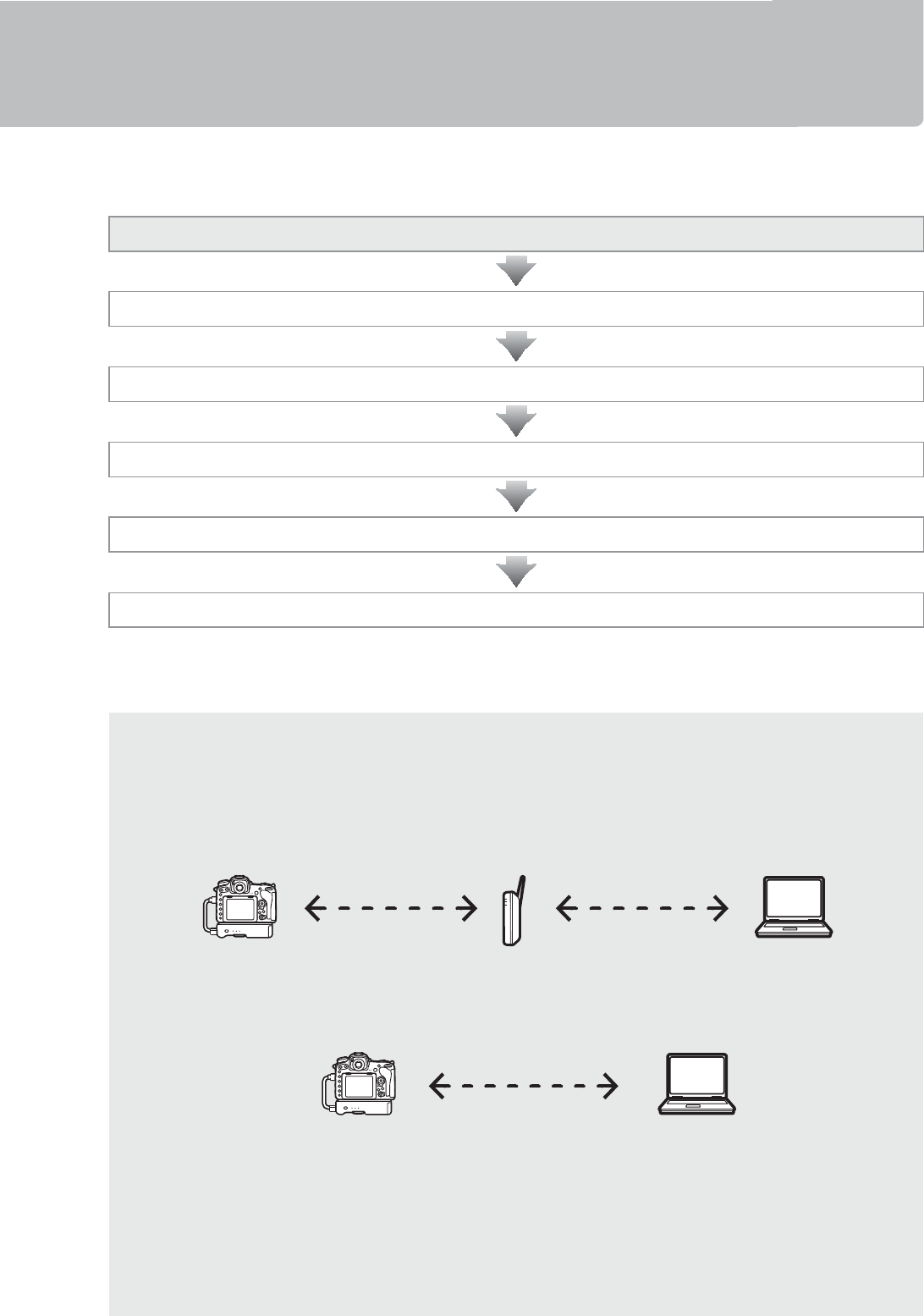
65FTP
Wireless Connections
Wireless Connections
Follow the steps below to connect to a wireless network.
FTP upload
Step 1: Ready the camera and WT-7 (066)
Step 2: Configure the hardware for wireless networks (067)
Step 3: Run the connection wizard (068)
Step 4: Adjust network settings (075)
Transfer pictures (078)
AInfrastructure and Access Point Modes
Connections to wireless networks may be in infrastructure or access
point mode.
Infrastructure mode: Connection via a wireless LAN access point.
Access point mode: The camera serves as an access point for direct
connection to a computer.
AWireless LANs
These instructions are intended for customers with an existing wireless
LAN, and in the case of infrastructure networks assume that the
computer and access point are already connected to the network.
WT-7 Wireless LAN access point Computer
WT-7 Computer
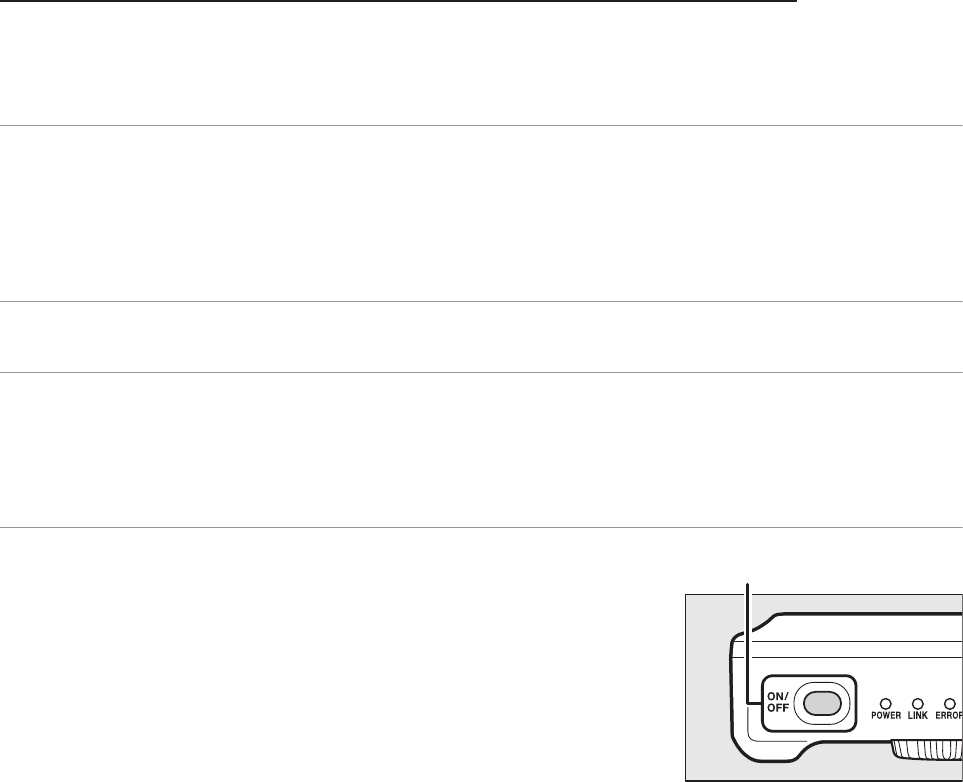
66 FTP
Wireless Connections
Step 1: Connecting the Equipment
After starting the computer and logging in, ready the camera and
WT-7 as described below.
1Insert a memory card.
Turn the camera off and insert a memory card (do not turn the
camera off while data are being transferred to the computer).
2Attach the WT-7 (05).
3Turn the camera on.
Rotate the power switch to turn the camera on.
4Press the power switch for about a
second to turn on the WT-7.
Power switch
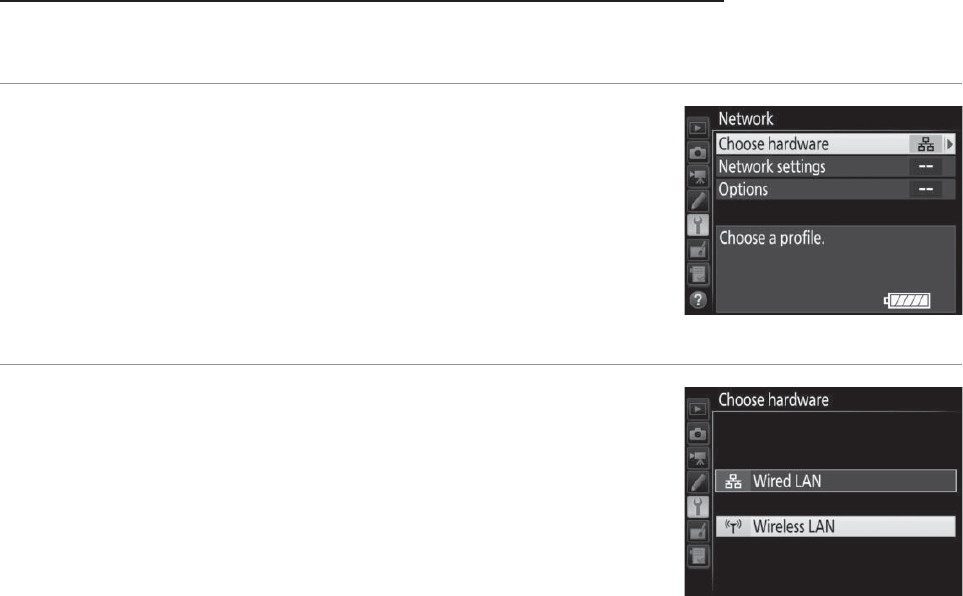
67FTP
Wireless Connections
Step 2: Enable Camera Wireless
Ready the camera for connection to a wireless network.
1Select Choose hardware.
In the setup menu, select Network, then
highlight Choose hardware and press 2.
The menu offers a choice of Wired LAN
and Wireless LAN.
2Select Wireless LAN.
Highlight Wireless LAN and press J to
select the highlighted option and return
to the network menu.
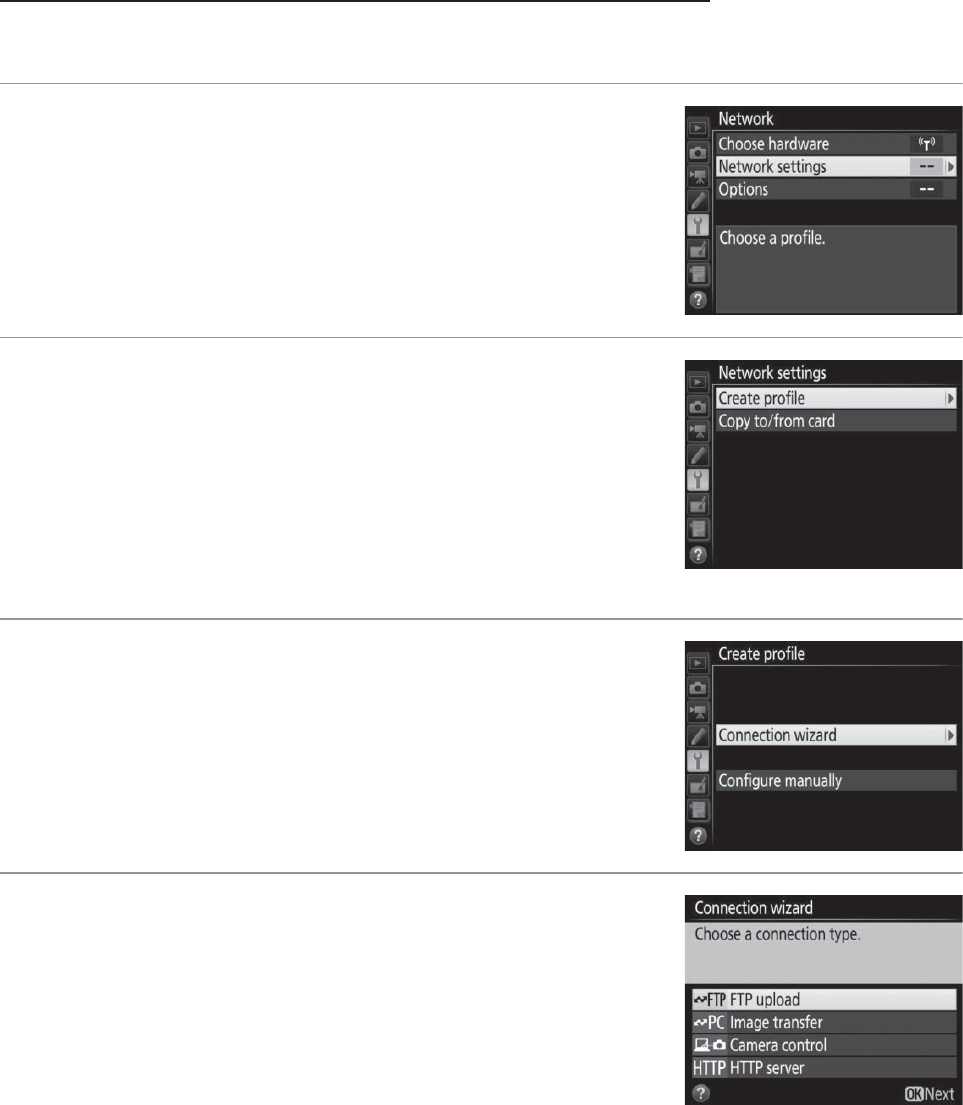
68 FTP
Wireless Connections
Step 3: The Connection Wizard
Follow the on-screen instructions to create a network profile.
1Display network profiles.
In the network menu, highlight
Network
settings
and press
2
to display the profiles
list and other network settings.
2Select Create profile.
Highlight
Create profile
and press
2
. Note
that if the list already contains nine profiles,
you will need to delete an existing profile
using the
O(Q)
button before proceeding.
3Start the connection wizard.
Highlight
Connection wizard
and press
2
to start the connection wizard.
4Choose FTP upload (08).
Highlight FTP upload and press J.
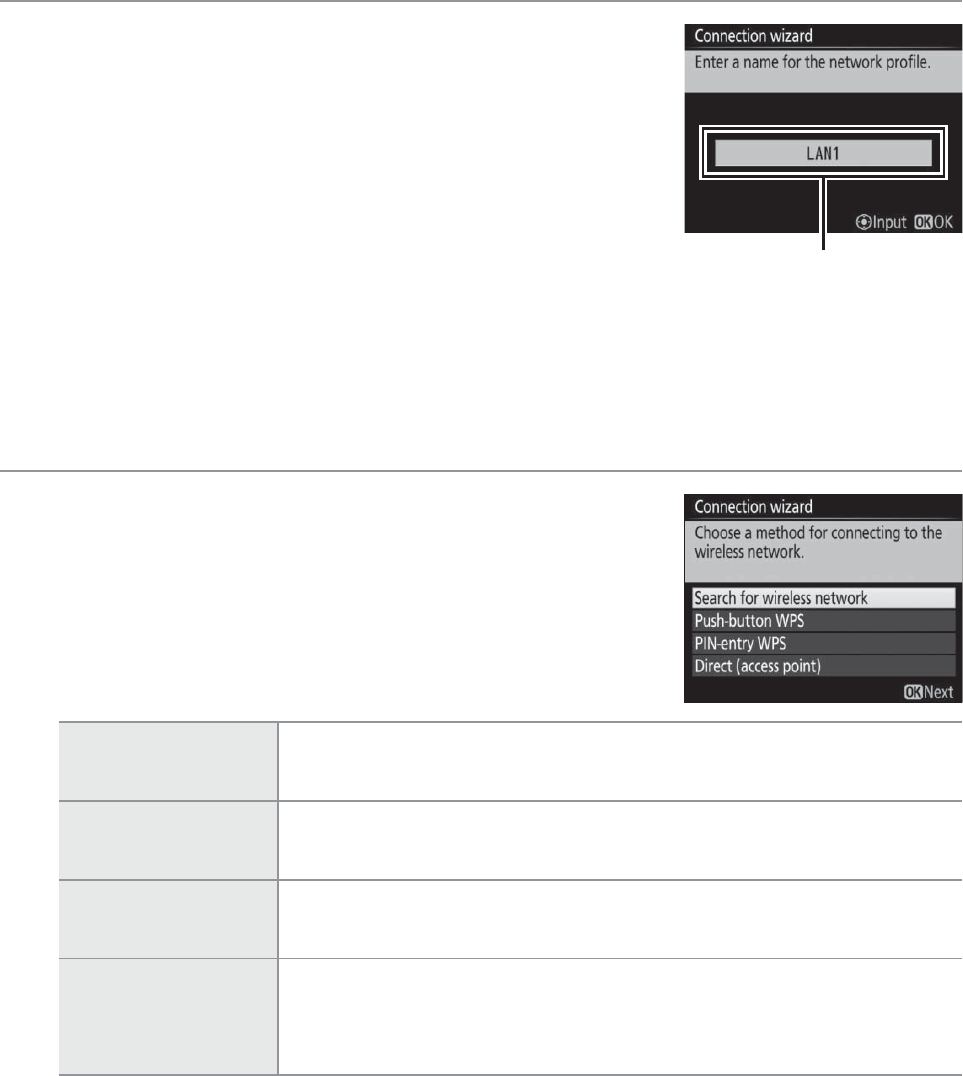
69FTP
Wireless Connections
5Name the new network profile.
A default profile name will be displayed;
to edit or change the name as described
in the camera manual, press the center of
the multi selector (if the camera is a
touch-screen model, you can enter
characters by tapping the letters on the
on-screen keyboard). The profile name will appear in the
Network > Network settings list in the camera setup menu.
Press J to proceed to the next step when entry is complete.
6Choose a connection method.
Highlight the connection method used
by the network and press J. More
information can be found on the pages
listed below.
Search for wireless
network
Choose from a list of networks detected by the
camera. Proceed to page 70.
Push-button WPS Choose for wireless LAN access points with push-
button WPS. Proceed to page 72.
PIN-entry WPS Choose for wireless LAN access points with PIN-
entry WPS. Proceed to page 73.
Direct
(access point)
Connect directly to a host computer or ftp server in
access point mode, with the camera serving as an
access point. Proceed to page 74.
Profile name
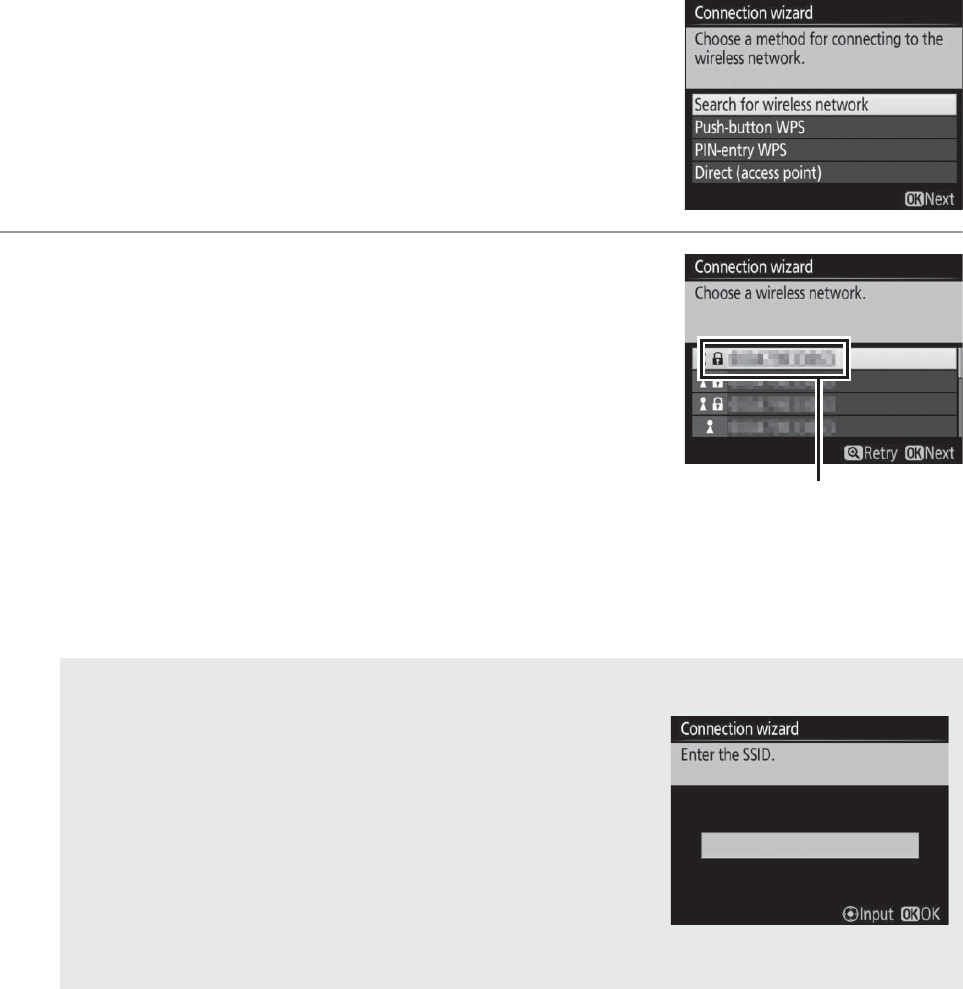
70 FTP
Wireless Connections
❚❚ Search for Wireless Network
Select Search for wireless network in Step 6
on page 69 to choose from a list of the
networks (wireless LAN access points)
detected by the camera.
1Choose a network.
Highlight a network SSID and press J (if
the desired network is not displayed,
press X to search again). Encrypted
networks are indicated by a h icon; if the
selected network is encrypted, you will
be prompted to enter the encryption key
as described in Step 2. If the network is not encrypted,
proceed to Step 3.
AHidden SSIDs
Networks with hidden SSIDs are indicated
by blank entries in the network list. If you
highlight a blank entry and press J, you will
be prompted to provide the network name;
press the center of the multi selector, enter a
name, and then press J to proceed to
Step 2.
SSID
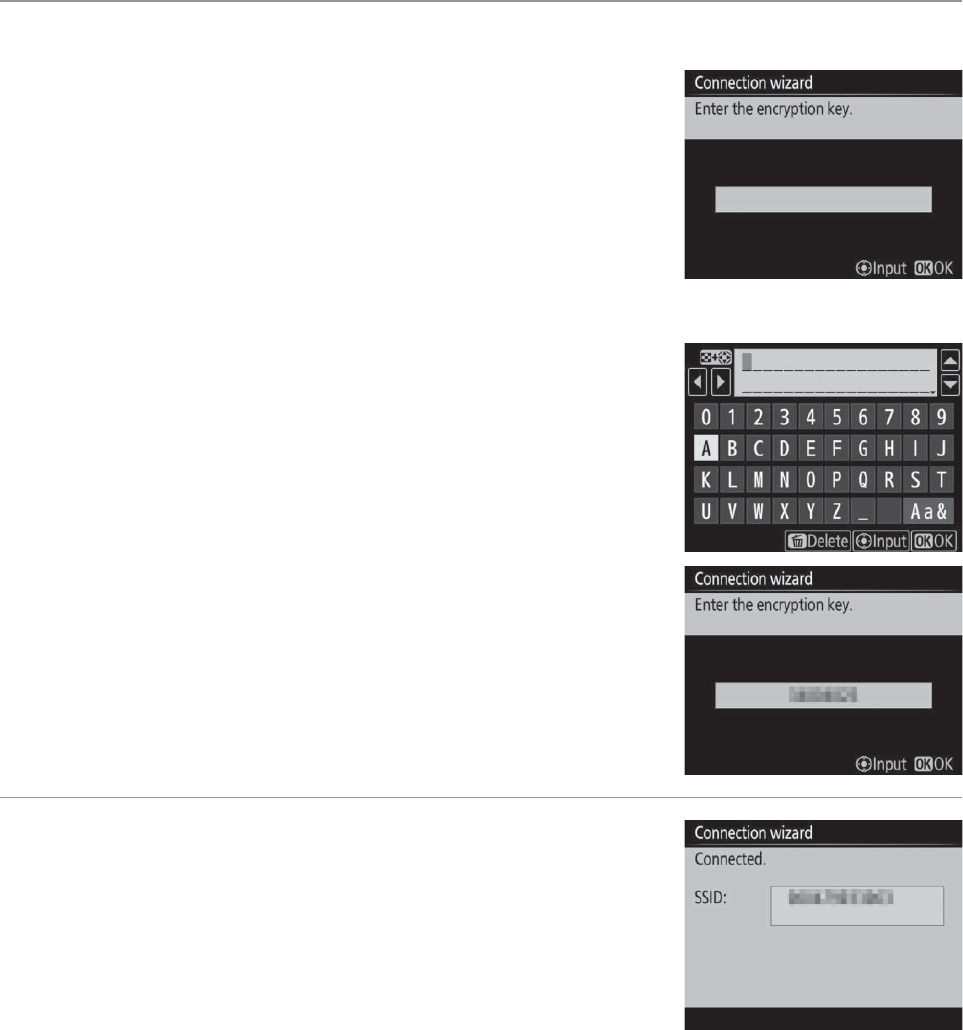
71FTP
Wireless Connections
2Enter the encryption key.
Press the center of the multi selector and
enter the encryption key as described in
the camera manual (if the camera is a
touch-screen model, you can enter
characters by tapping the letters on the
on-screen keyboard).
Press J when entry is complete.
Press J to establish a connection.
3Choose your next step.
The message at right is displayed when a
connection is established. Proceed to
page 75.
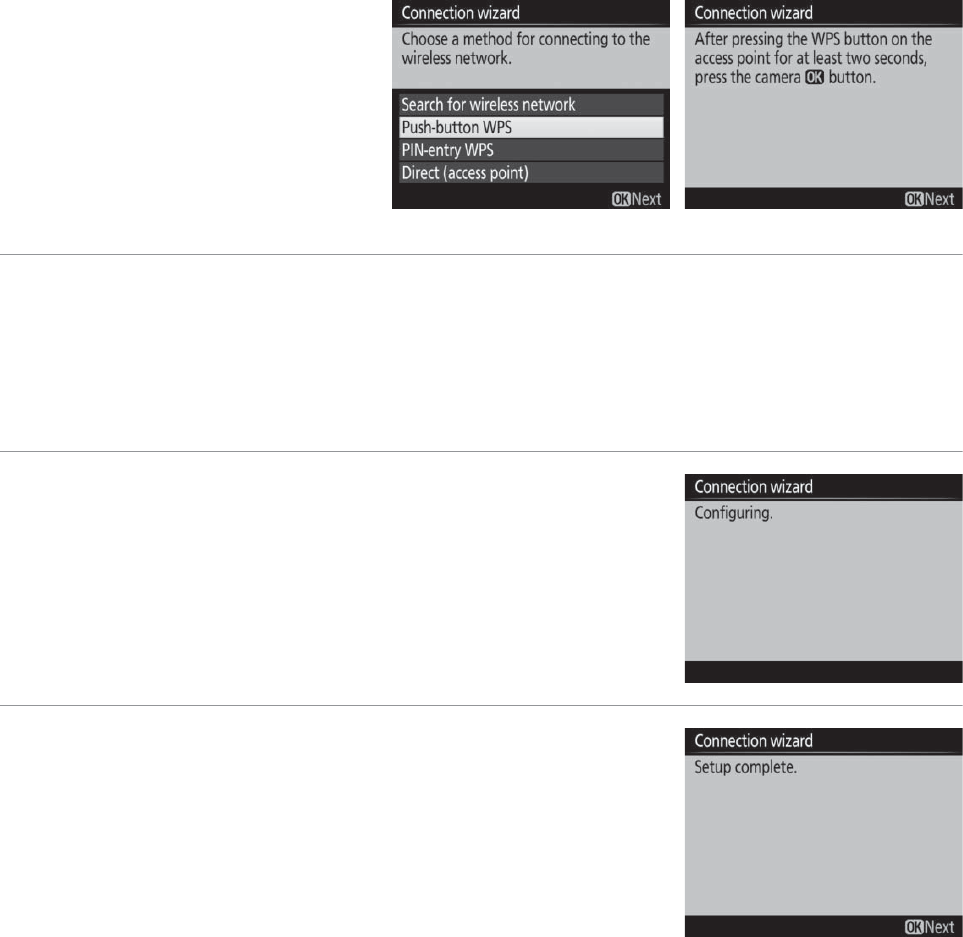
72 FTP
Wireless Connections
❚❚ Push-Button WPS
Choose Push-button
WPS in Step 6 on page 69
if the wireless LAN access
point uses push-button
WPS.
1Press the WPS button on the wireless LAN access point.
For more information, see the documentation provided with
the wireless LAN access point.
2Press J button on the camera.
The camera will connect to the access
point automatically.
3Choose your next step.
The message at right is displayed when a
connection is established. Proceed to
page 75.
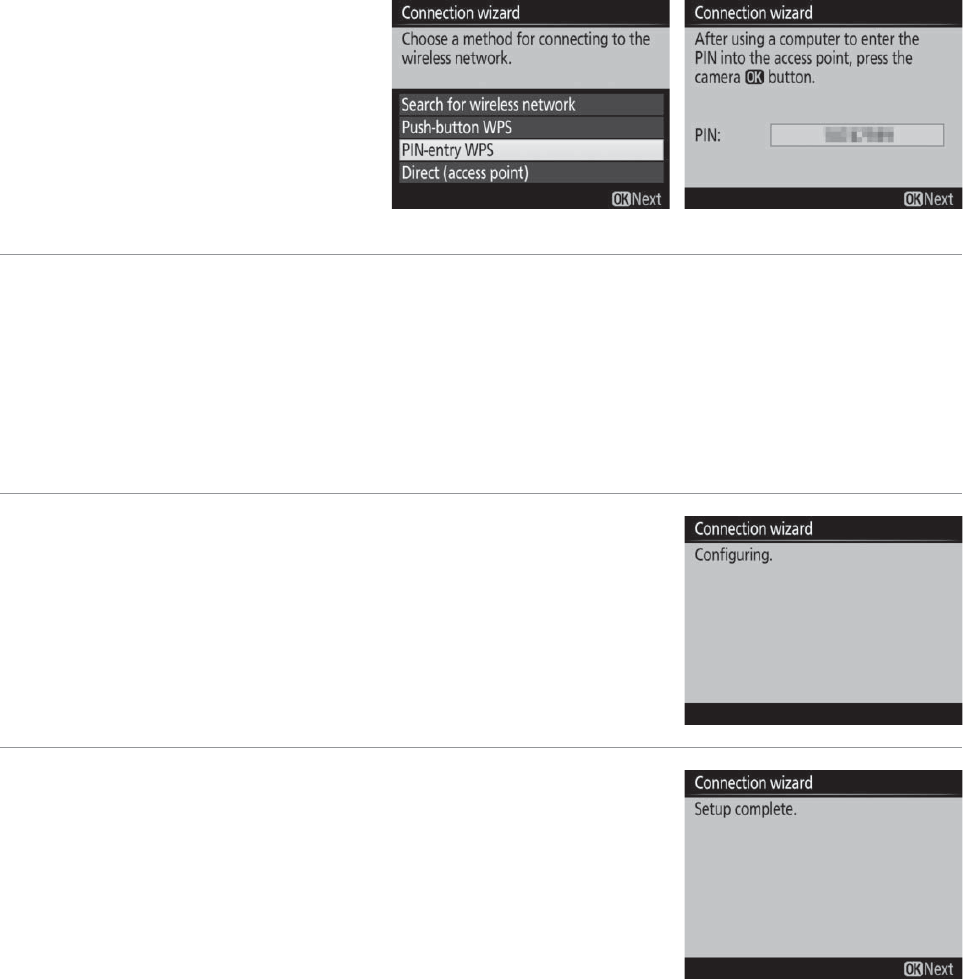
73FTP
Wireless Connections
❚❚ PIN-Entry WPS
Choose PIN-entry WPS
in Step 6 on page 69 if
the wireless LAN access
point uses PIN-entry
WPS.
1Enter the PIN for the wireless LAN access point.
From a computer, enter the PIN for the wireless LAN access
point. For more information, see the documentation provided
with the wireless LAN access point.
2Press J button on the camera.
The camera will connect to the access
point automatically.
3Choose your next step.
The message at right is displayed when a
connection is established. Proceed to
page 75.
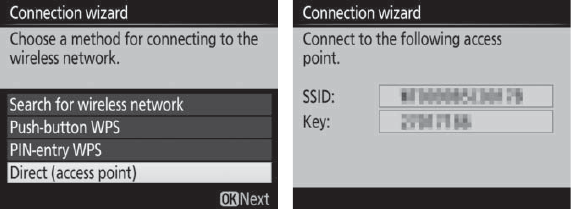
74 FTP
Wireless Connections
❚❚ Direct (Access Point)
Selecting Direct (access
point) in Step 6 on
page 69 enables access
point mode, in which the
camera serves as a
wireless access point. The
camera SSID and encryption key will be displayed in the monitor.
On the computer or smart device, enter the SSID and encryption
key displayed in the camera monitor (for more information, see
the documentation provided with the computer or smart device).
Proceed to Step 2 on page 75.
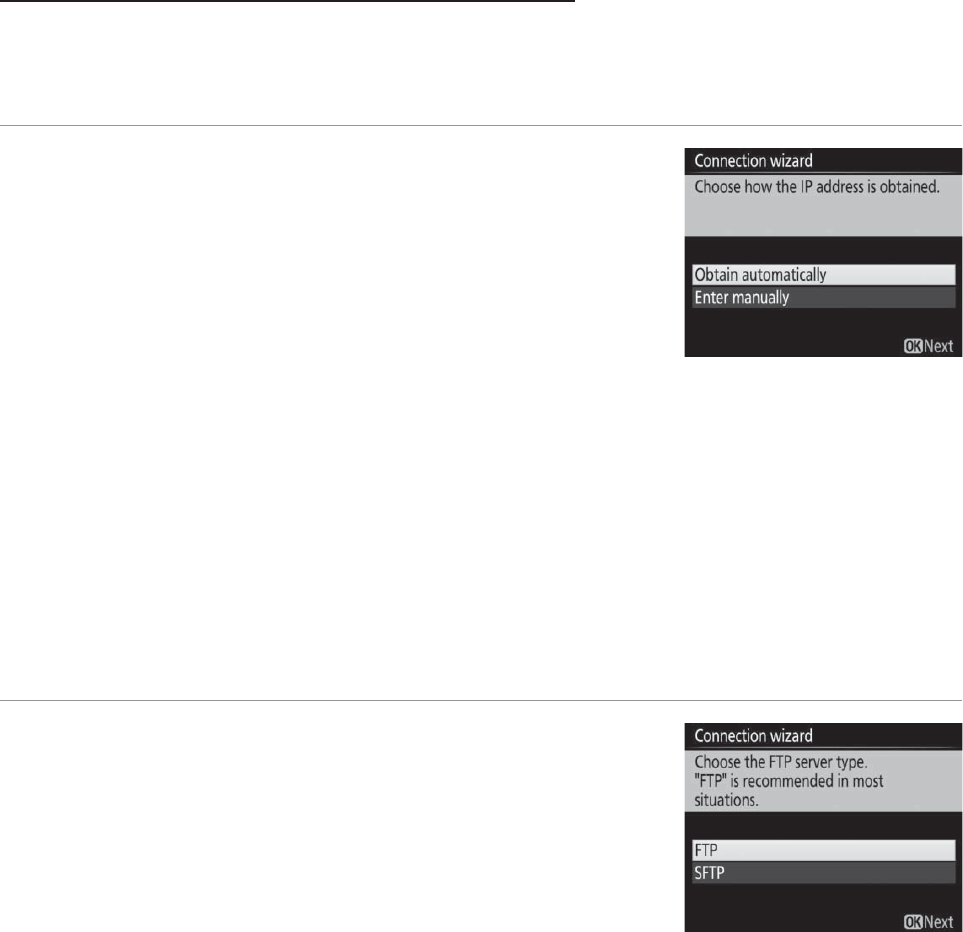
75FTP
Wireless Connections
Step 4: Network Settings
Follow the steps below to connect to the ftp server. Skip Step 1 if
you selected Direct (access point) in Step 6 on page 69.
1Obtain or select an IP address.
Highlight one of the following options
and press J.
•Obtain automatically: Select this option if
the network is configured to supply the
IP address automatically. The camera
will display the IP address provided by the network; press J
to proceed.
•Enter manually: When prompted, enter an IP address and
subnet mask by pressing 4 and 2 to highlight segments
and 1 and 3 to change. Press J when entry is complete.
The camera will display the selected IP address; press J to
proceed.
2Choose the server type.
Highlight FTP or SFTP (secure ftp) and
press J. If you selected Direct (access
point) in Step 6 on page 69, proceed to
Step 4.
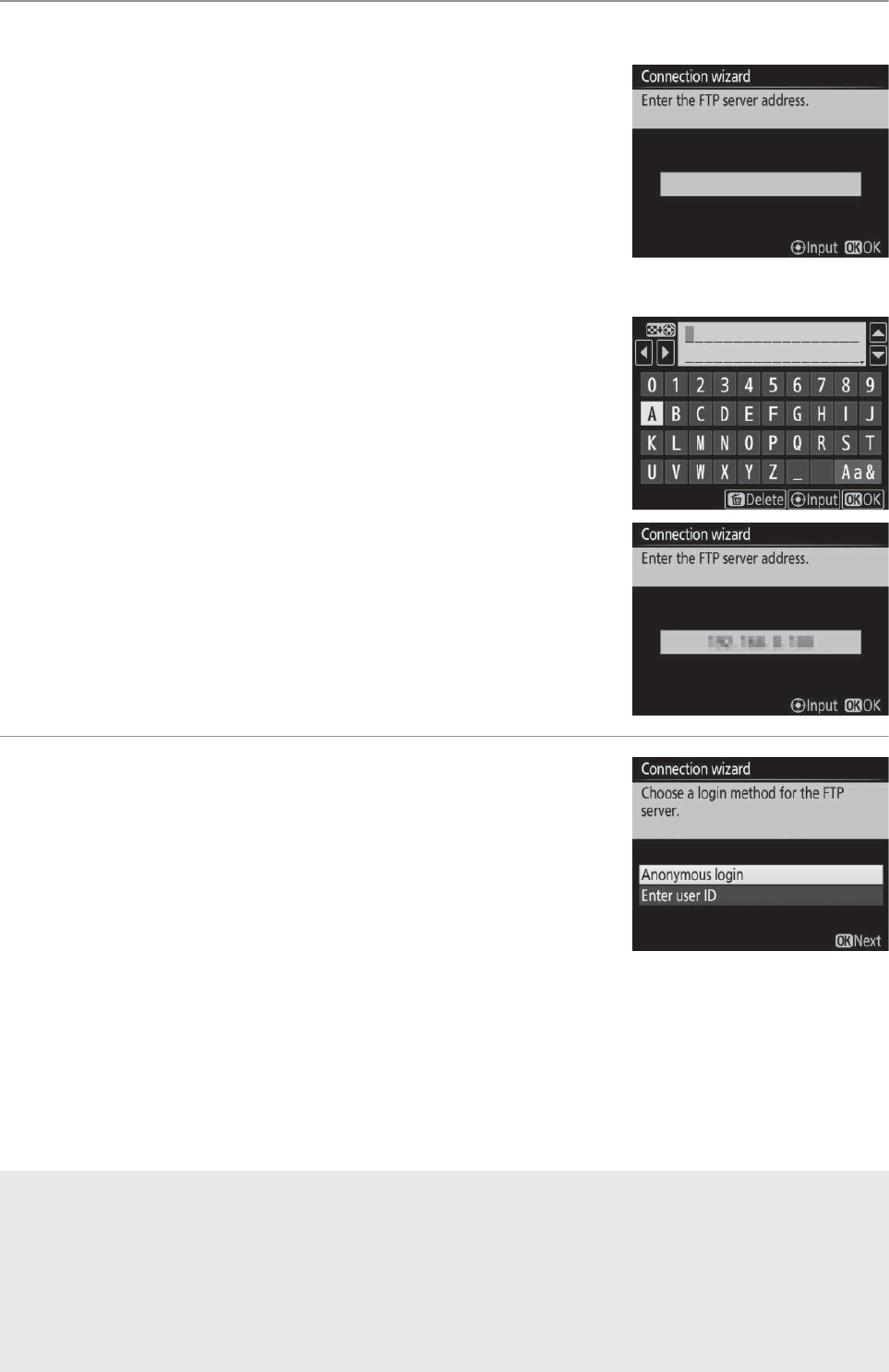
76 FTP
Wireless Connections
3Enter the IP address.
Press the center of the multi selector and
enter the server URL or IP address as
described in the camera manual (if the
camera is a touch-screen model, you can
enter characters by tapping the letters on
the on-screen keyboard).
Press J when entry is complete.
Press J again to connect to the ftp
server.
4Log in.
Highlight one of the following options
and press J.
•Anonymous login: Select this option if the
server does not require a user ID or
password.
•Enter user ID: Enter a user ID and password when prompted
and press J.
AMAC Address Filtering
If the network uses MAC address filtering, the filter must be supplied
with the MAC address of the WT-7. After attaching the WT-7 to the
camera, choose Network > Options > MAC address from the camera
setup menu and note the MAC address.
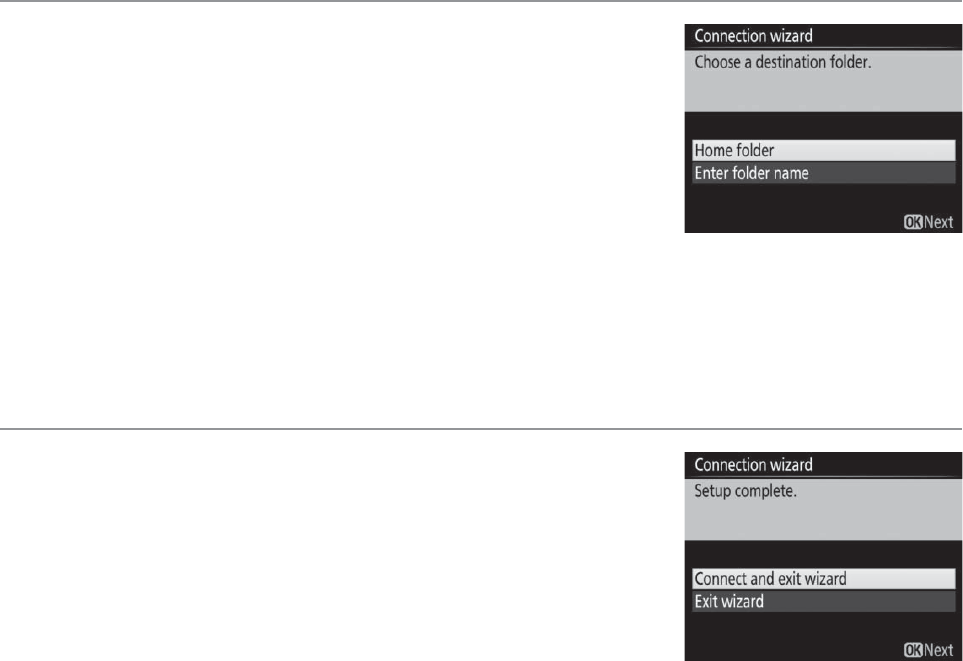
77FTP
Wireless Connections
5Choose a destination folder.
Highlight one of the following options
and press J.
•Home folder: Select this option to upload
pictures to the server’s home folder.
•Enter folder name: Select this option to
upload pictures to another of the folders existing on the
server. Enter a folder name and path when prompted and
press J.
6Exit the wizard.
Highlight one of the following options
and press J.
•Connect and exit wizard: Save the new
network profile and connect to the
server.
•Exit wizard: Save the new network profile and exit.
Proceed to “FTP Upload” (078).
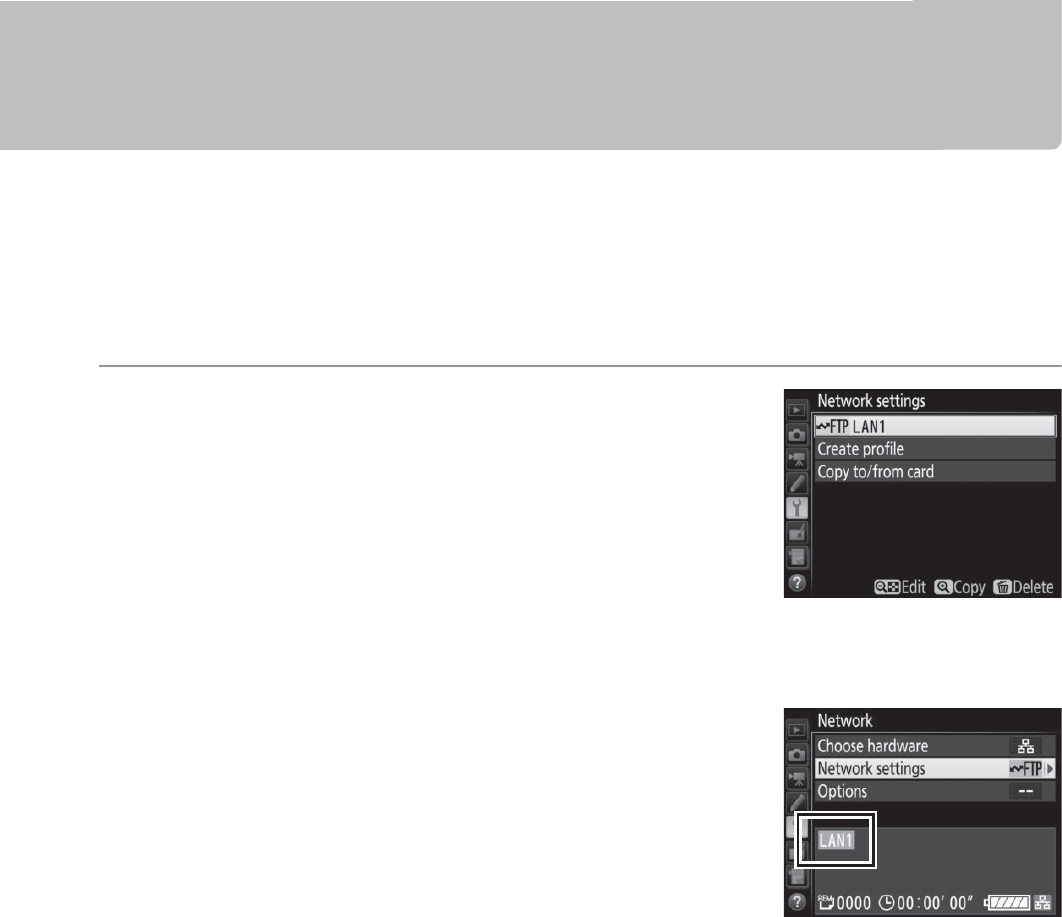
78 FTP
FTP Upload
FTP Upload
Photos and movies can be uploaded from camera memory cards
to an ftp server as described below, or photos can be uploaded as
they are taken. For information on setting up an ftp server, see
page 95.
1Display network profiles.
In the setup menu, select Network >
Network settings to display the profiles
list. FTP server profiles are indicated by a
N icon. Highlight a profile and press J
to select the highlighted profile and
return to the network menu.
The profile name will be displayed in
green when a connection is established.

79FTP
FTP Upload
2View pictures.
Press the K button to view pictures.
Display the first picture to be sent full
frame or highlight it in the thumbnail list.
3Upload pictures.
Press J and the center of the multi
selector. A white transfer icon will appear
on the picture and upload will begin
immediately. The transfer icon turns
green during upload, and turns blue
when upload is complete. Additional
pictures will be uploaded in the order
selected.
To upload a picture that has already been
uploaded once, press J and the center of
the multi selector once to remove the
blue transfer icon, and then press J and
the center of the multi selector again to
mark the image with a white transfer
icon.

80 FTP
FTP Upload
Uploading New Photographs as They Are Taken
To upload new photographs as they are taken,
select On for Network > Options > Auto send in
the setup menu (089).
Interrupting Transmission/Removing Transfer Marking
To cancel transmission of images marked with white or green transfer
icons, select the images during playback and press J and the center of
the multi selector. The transfer icon will be removed. Any of the following
actions will also interrupt transmission:
•Turning the camera off
•Selecting Yes for Network > Options > Deselect all? (091; this option
also removes transfer marking from all images)
DDuring Upload
Do not remove the memory card or disconnect the Ethernet cable
during upload.
AInterval Timer Photography
Upload will be interrupted if the standby timer expires while interval
timer photography is in progress. Choose a long standby time before
starting the interval timer.
ALoss of Signal
Wireless transmission may be interrupted if the signal is lost, but can be
resumed by turning the camera off and then on again.
ATurning the Camera Off
“Send” marking will be saved if the camera or WT-7 is turned off while
transmission is in progress. Transmission of images marked with a
“send” icon will resume when the camera or WT-7 is turned on.
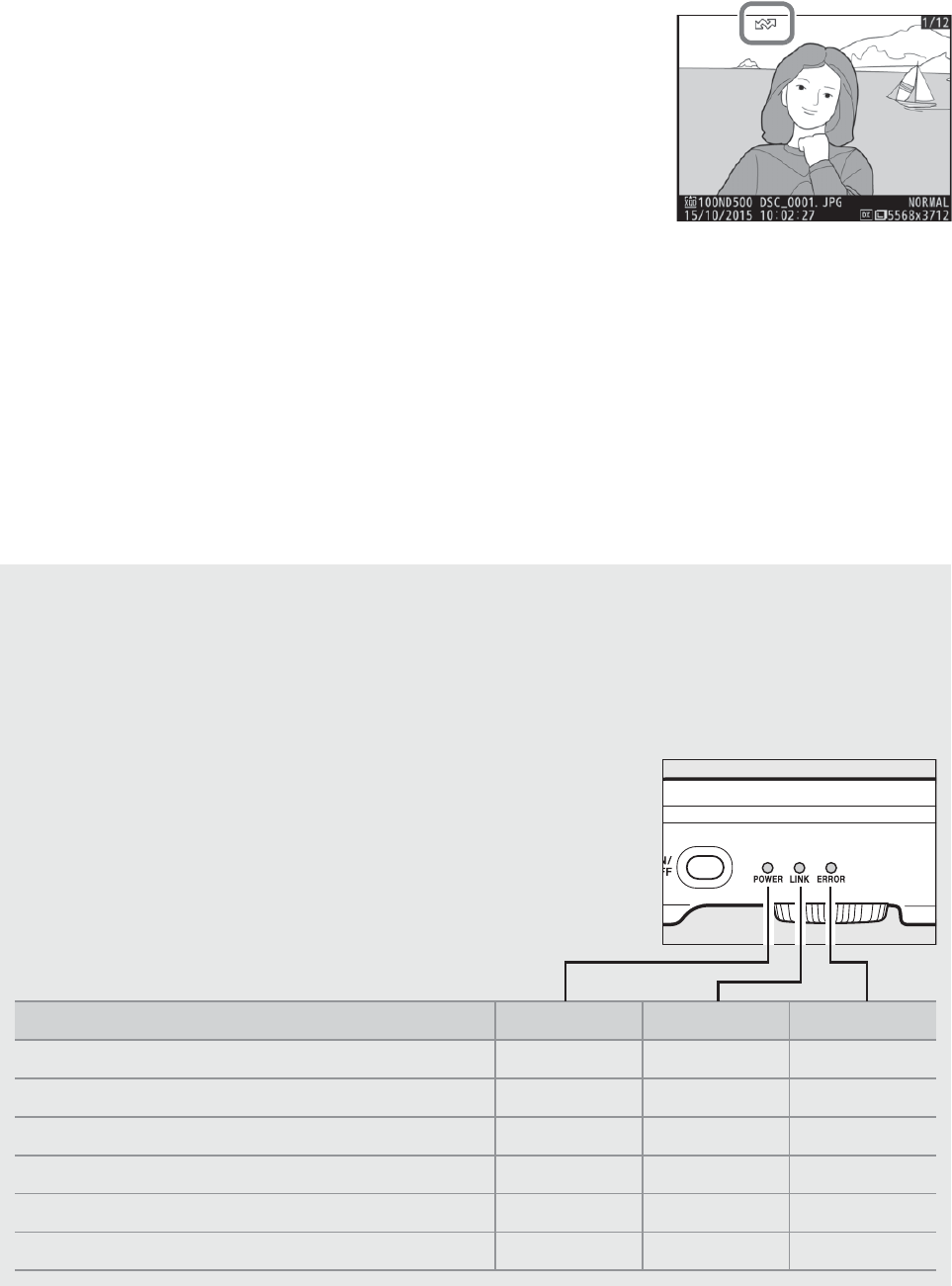
81FTP
FTP Upload
Transfer Status
During playback, the status of images selected for upload is shown
as follows:
a: “Send”
Images that have been selected for upload
are marked with a white a icon.
b: “Sending”
A green b icon is displayed during upload.
c: “Sent”
Images that have been uploaded successfully are marked with a
blue c icon.
ANetwork Status
The status of the link between the host and the WT-7 is shown by the
status LEDs and by the display in the top level of the network menu.
The Status LEDs
Status POWER LINK ERROR
WT-7 off I (off) I (off) I (off)
USB cable not connected K (on) I (off) I (off)
Connecting to host K (on) K (on) I (off)
Waiting to send or sending data K (on) H (flashes) I (off)
Connection error K (on) I (off) H (flashes)
WT-7 hardware or battery malfunction H (flashes) H (flashes) H (flashes)
The POWER LED lights when the WT-7 is on.
Signal quality is shown by the LINK LED: the
faster the LED flashes, the better the signal and
the faster data can be transmitted. The ERROR
LED flashes to show that an error has occurred.
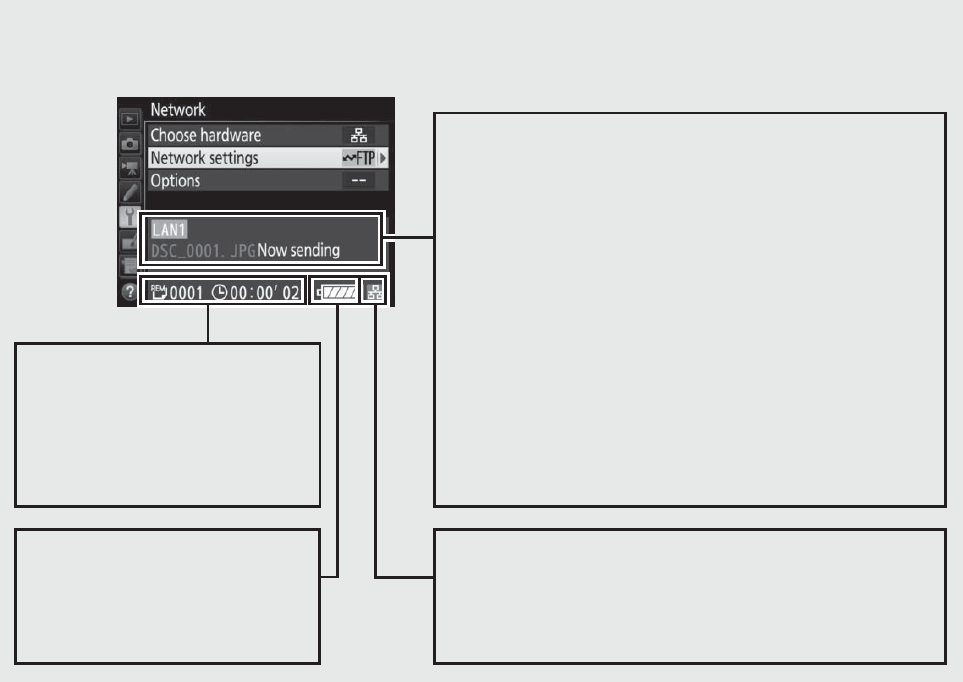
82 FTP
FTP Upload
The Status Display
Network status can also be viewed in the top level of the network menu.
Signal strength: Wireless signal
strength. Ethernet connections are
shown by d.
Status area: The status of the
connection to the host. The host
name is displayed in green when a
connection is established. While files
are being transferred, the status
display shows “Now sending”
preceded by the name of the file
being sent. Any errors that occur
during transfer are also displayed
here (0105).
e, f: The estimated
time required to
send the remaining
images.
Battery level: The
charge state of the
battery in the WT-7.
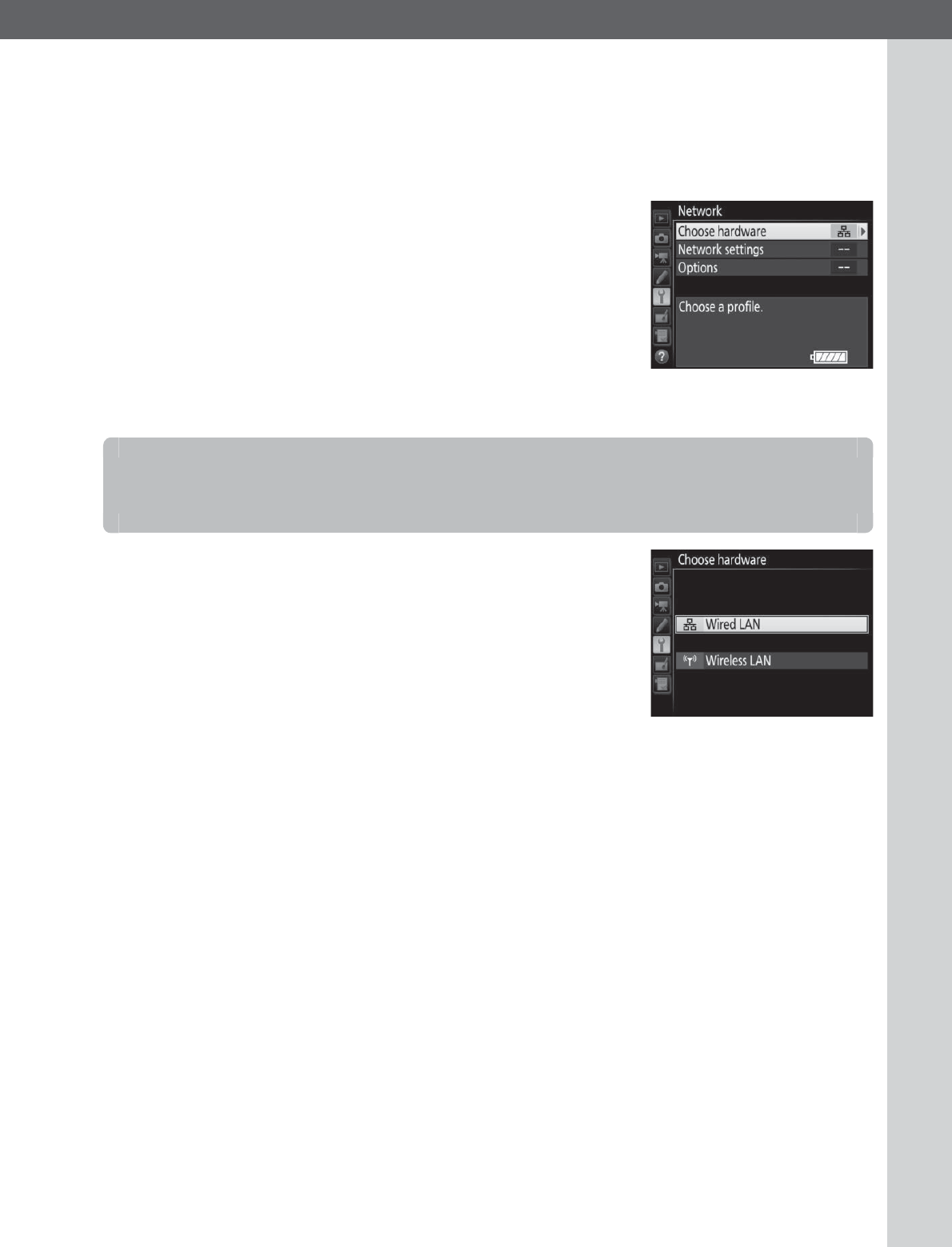
83Menu Guide
Menu Guide
This section describes the settings available
for the Network option in the camera setup
menu when the WT-7 is connected.
Choose the hardware used to connect to the
network: Ethernet (Wired LAN) or wireless
LAN (Wireless LAN).
Choose Hardware
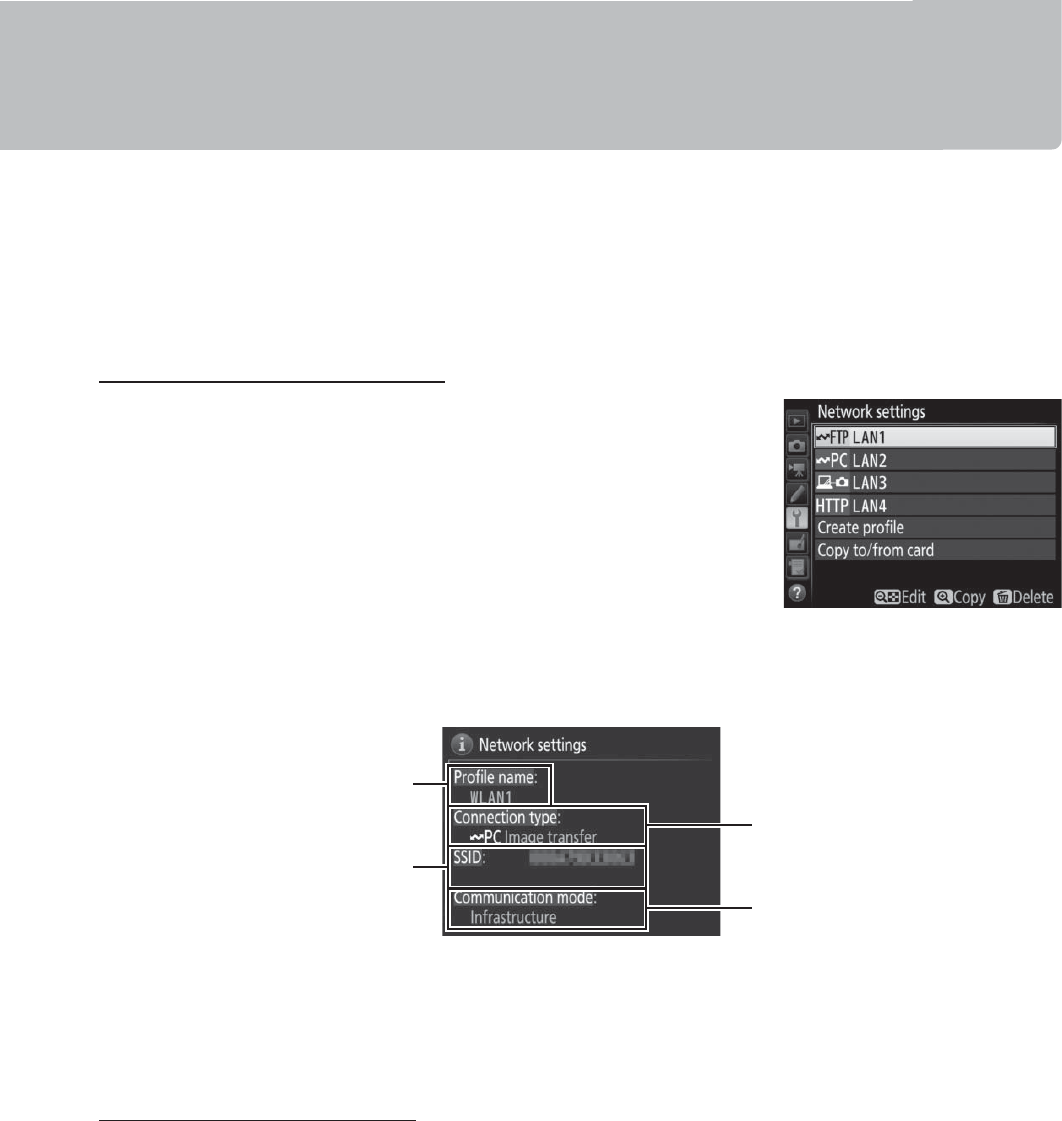
84 Menu Guide
Network Settings
Network Settings
Highlight Network settings and press 2 to display the network
profiles list, where you can create new profiles or select an existing
profile.
The Profile List
The camera can store up to nine network
profiles. Highlight a profile and press 2 to
connect to the highlighted host computer or
ftp server, or press O (Q) to delete the
highlighted profile (085). To view
information on the highlighted profile, press
L (Z/Q).
To edit the highlighted profile, press W (M) (086).
Create Profile
Choose Connection wizard to create network profiles with the
help of a wizard (013, 22, 61, 68), Configure manually to enter
ftp and http server settings manually (0103).
Connection type (08)
Profile name
(014, 23, 62, 69, 86)
SSID (wireless
connections only) Communication
mode (087)

85Menu Guide
Network Settings
Copy to/from Card
This option is available only with ftp and http server connections.
Select Copy profile from card to copy profiles from the root
directory of the memory card to the profile list. Selecting Copy
profile to card displays the camera profile list; highlight a profile
and press J to copy the profile to the card (password-protected
profiles can not be copied; 086). If there are two memory cards
inserted in the camera, the card in the primary slot will be used for
both “copy from” and “copy to” operations.
Deleting Network Profiles
Press O (Q) to delete the profile currently
highlighted in the profile list. A confirmation
dialog will be displayed; highlight Yes and
press J.
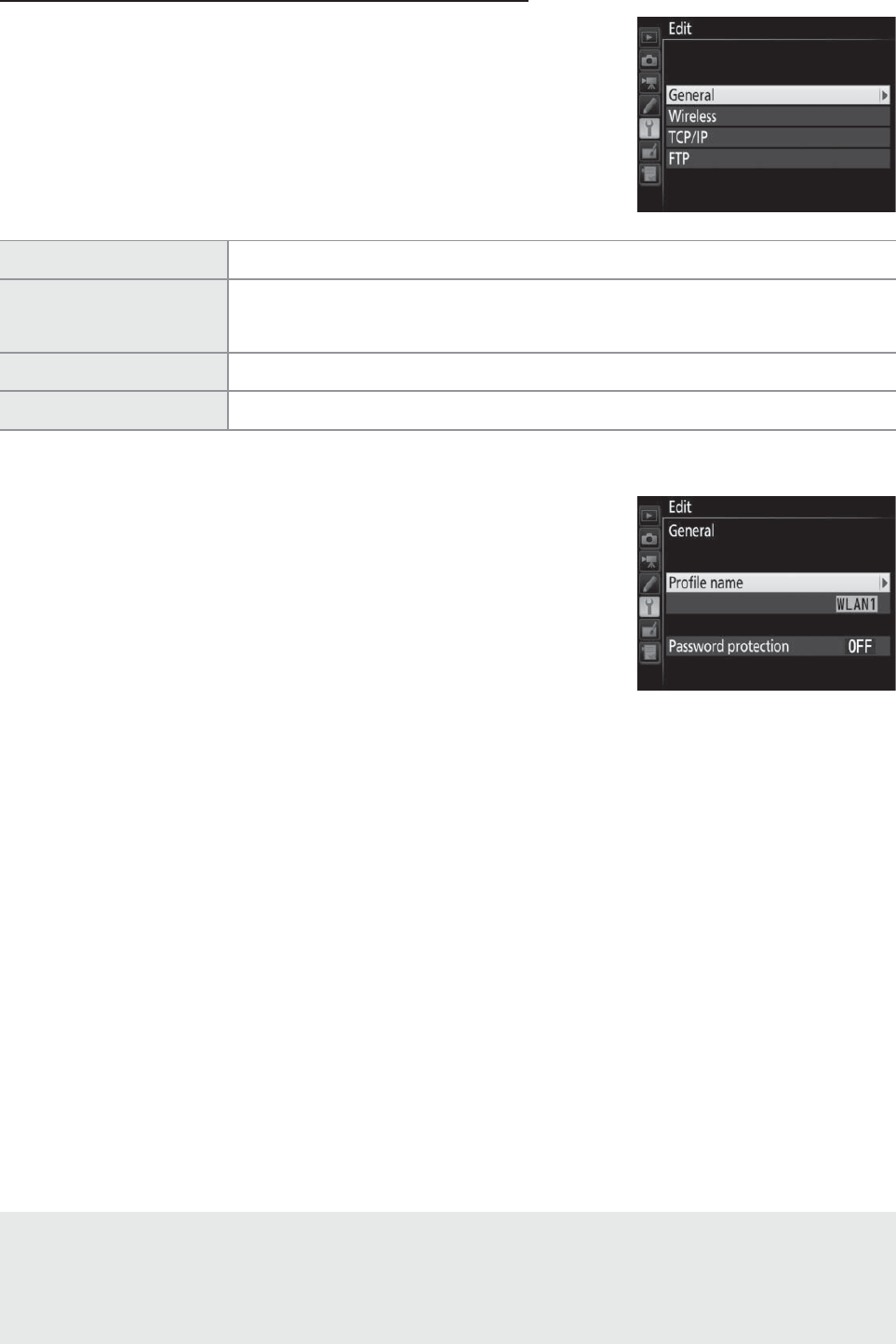
86 Menu Guide
Network Settings
Editing Network Profiles
To edit network profiles, highlight the profile
in the profile list, press W (M), and choose
from the following options:
❚❚ General
Choose Profile name to edit the profile
name, Password protection to enter a profile
password and enable or disable password
protection. Enabling password protection
prevents others from viewing network
settings.
General Edit the profile name and password.
Wireless Edit wireless settings (wireless connections only;
087).
TCP/IP Edit TCP/IP settings (088).
FTP Edit ftp settings (088).
DEditing Profiles
If the shutter-release button is pressed while menus are displayed, the
monitor will turn off and any changes to the current profile will be lost.

87Menu Guide
Network Settings
❚❚ Wireless
Edit the following wireless settings:
•SSID (required): Enter the name (SSID) of the
network on which the host computer or ftp
server is located.
•Communication mode: Select Infrastructure
for wireless communication via a wireless network access point,
Access point to use the camera as an access point to connect to
the ftp server or computer instead of connecting via a wireless
network access point.
•Channel: Select a channel (access point mode only; in
infrastructure mode, the channel will be selected automatically).
•Authentication: The authentication used on the network. Choose
from open system, shared key, WPA-PSK, and WPA2-PSK
(infrastructure) or open system and WPA2-PSK (access point
mode).
•Encryption: The encryption used on the network. The options
available depend on the authentication used:
Open: None; 64- or 128-bit WEP available when Infrastructure
is selected for Communication mode
Shared: 64- or 128-bit WEP
WPA-PSK: TKIP; AES
WPA2-PSK: AES
•Encryption key: If the network uses encryption, enter the network
key. The number of characters required depends on the type of
key used:
•Key index: If WEP64 or WEP128 is selected for Encryption in
infrastructure mode, choose a key index matching that used by
the access point or host computer. A key index is not required
when No encryption is selected.
WEP (64-bit) WEP (128-bit) TKIP, AES
Number of characters (ASCII) 5 13 8–63
Number of characters (hex) 10 26 64
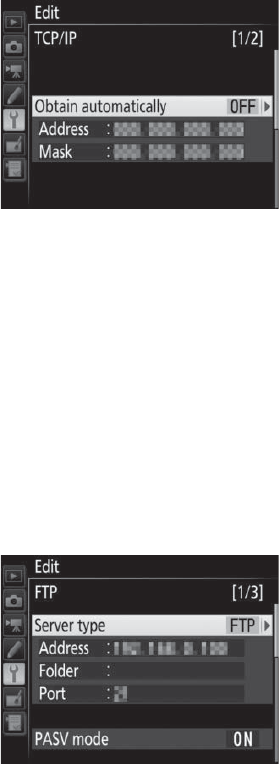
88 Menu Guide
Network Settings
❚❚ TCP/IP
If the network is configured to supply IP
addresses automatically, select Enable for
Obtain automatically. Otherwise select
Disable and enter the following information:
•Address/Mask: Enter an IP address and subnet
mask.
•Gateway: If the network requires a gateway address, select Enable
and enter the address supplied by the network administrator.
•Domain Name Server (DNS): If a Domain Name Server exists on the
network, select Enable and enter the address supplied by the
network administrator.
❚❚ FTP
Edit the following ftp settings:
•Server type: Choose ftp or sftp and enter the
URL or IP address (required), destination
folder, and port number.
•PASV mode: Select Enable to enable PASV
mode.
•Anonymous login: Select Enable for anonymous login, or select
Disable to supply a User ID and Password.
•Proxy server: If a proxy server is required for ftp, select Enable and
enter the address and port number for the proxy server.
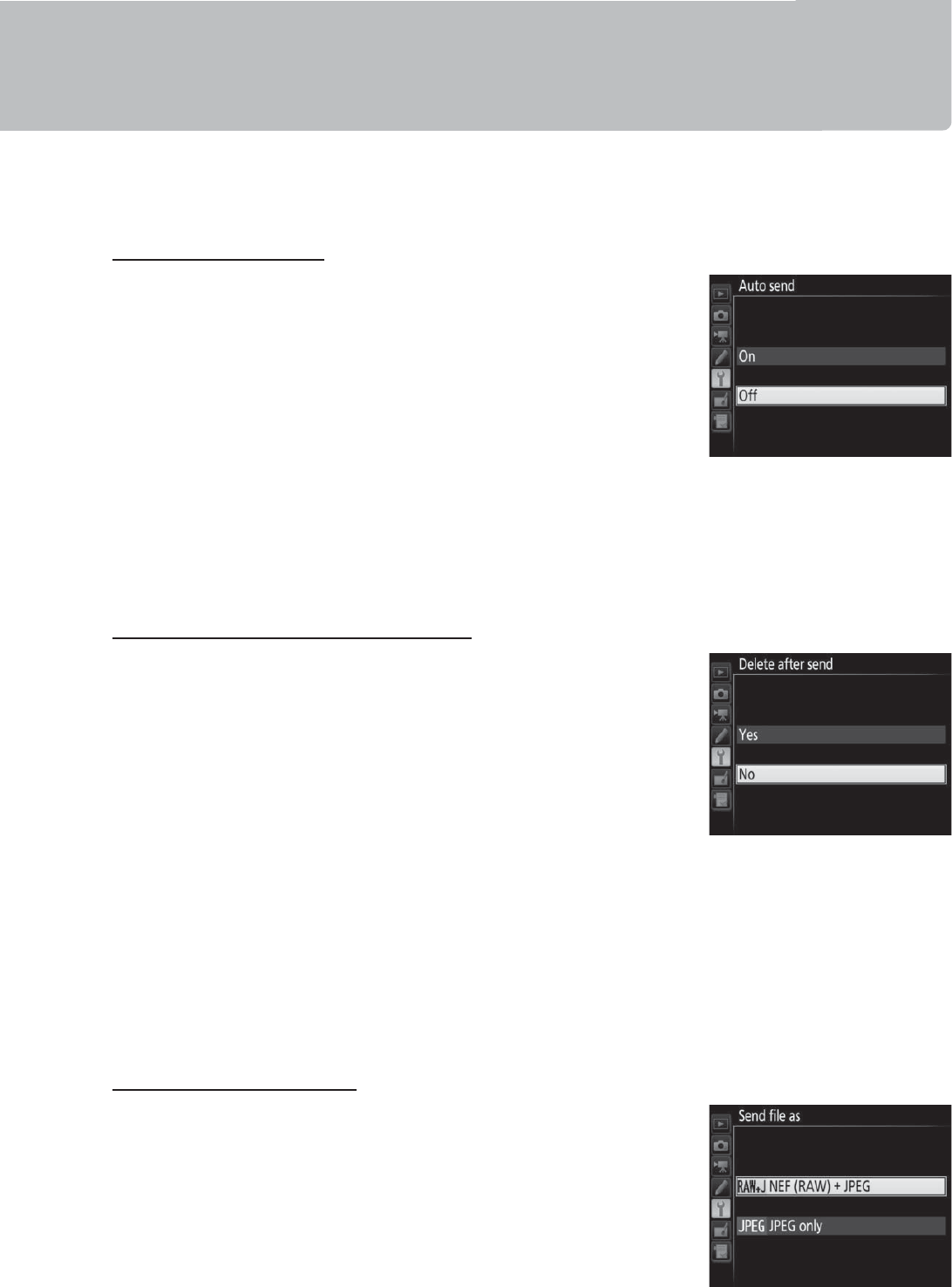
89Menu Guide
Options
Options
Edit the following settings.
Auto Send
If On is selected for image transfer or ftp
server connections, photos will automatically
be uploaded to the computer or ftp server as
they are taken (note, however, that photos
can only be taken when a memory card is
inserted in the camera). Movies can not be
uploaded using this option; transfer movies during playback as
described on pages 32 and 78.
Delete After Send
Select Ye s to delete photographs from the
camera memory card automatically once
upload is complete (image transfer and ftp
server connections only; files marked for
transfer before this option is selected are
unaffected). Regardless of the option selected
for file number sequence in the camera Custom Settings menu,
sequential number is used while this option is in effect, even if the
folder changes or the memory card is replaced. Deletion may be
suspended during some camera operations.
Send File As
When transferring NEF+JPEG images to a
computer or ftp server (image transfer and ftp
server connections only), choose whether to
upload both the NEF (RAW) and JPEG files or
only the JPEG copy.
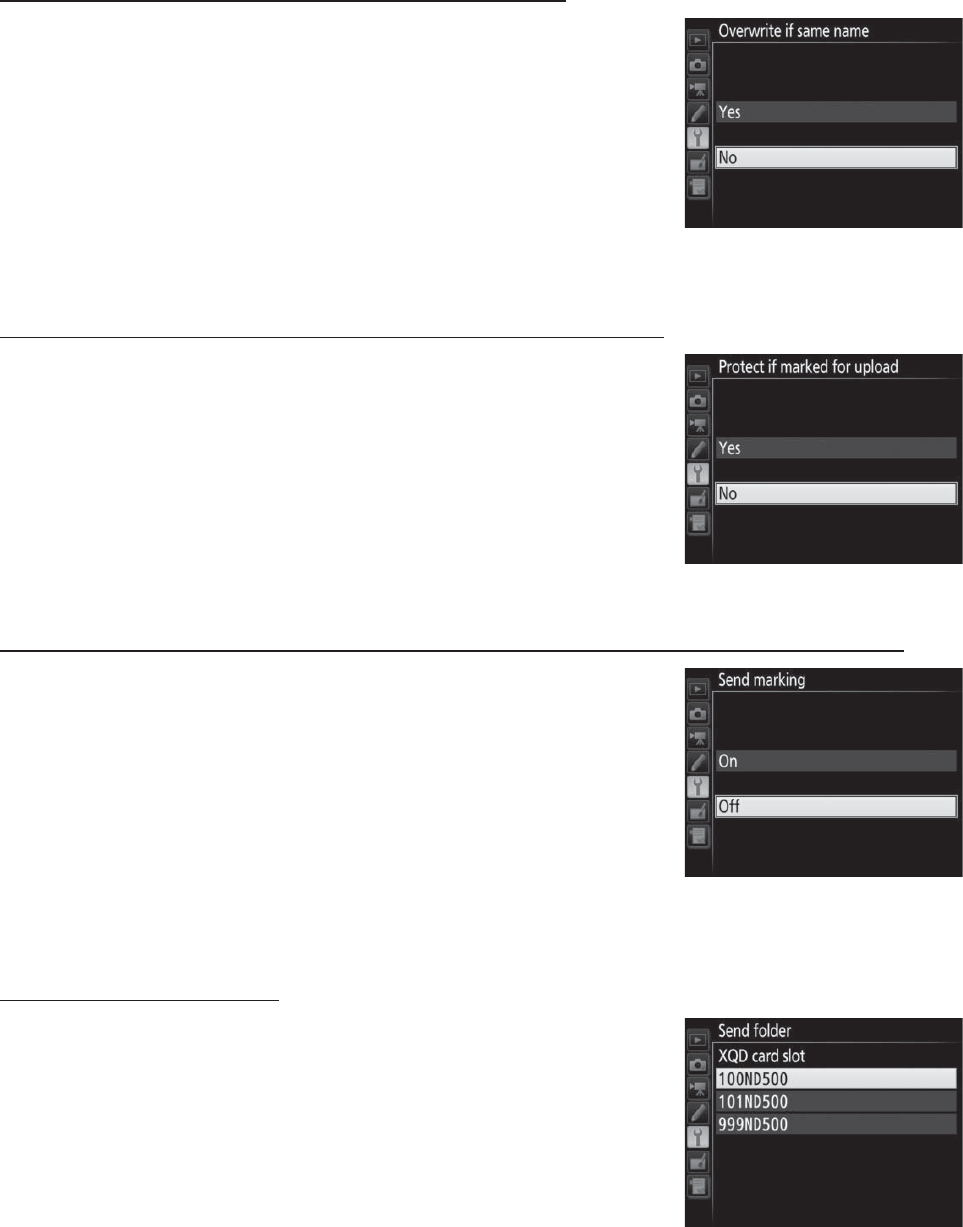
90 Menu Guide
Options
Overwrite If Same Name
Choose Yes to overwrite files with duplicate
names during upload to an ftp server, No to
add numbers to the names of newly
uploaded files as necessary to prevent
existing files being overwritten.
Protect If Marked for Upload
Select Yes to automatically protect files
marked for upload to an ftp server. Protection
is removed as the files are uploaded.
Send Marking (FTP Upload Mode Only)
Select On to add a timestamp to the pictures
on the camera memory card giving the time
of upload. The timestamp can be viewed
using ViewNX-i or Capture NX-D. For more
information, see online help for the software
in question or the Capture NX-D manual.
Send Folder
Select a folder for upload (image transfer and
ftp server connections only). All photos in the
selected folder (including those already
marked as “sent”) will be uploaded,
beginning immediately. Movies can not be
uploaded using this option; transfer movies
during playback as described on pages 32 and 78.
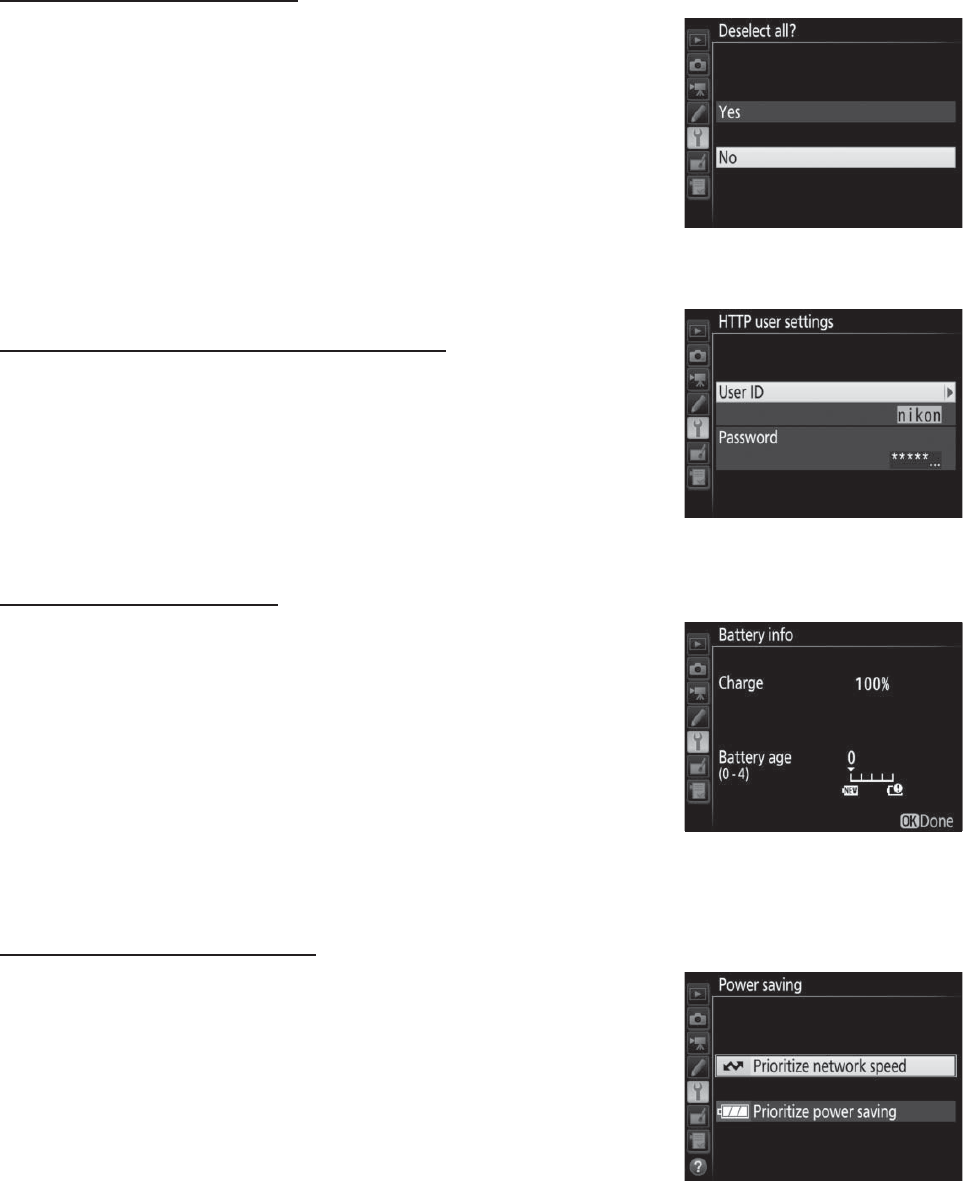
91Menu Guide
Options
Deselect All?
Select Ye s to remove transfer marking from
all images selected for upload to a computer
or ftp server (image transfer and ftp server
connections only). Upload of images with a
“sending” icon will immediately be
terminated.
HTTP User Settings
Enter a user name and password for
connection to an http server (http server
connections only).
Battery Info
Display information for the battery inserted in
the WT-7. The five-level Battery age display
shows the battery age: 0 indicates that
battery performance is unimpaired, 4 that the
battery has reached the end of its charging
life and requires replacement.
Power Saving
Choose Prioritize network speed for faster
network speeds, Prioritize power saving for
reduced power consumption. Prioritize
network speed ensures that LAN
connections remain active even when data
are not being exchanged with the server and
allows Ethernet connections using the high-speed 1000BASE-T
standard. Prioritize power saving limits Ethernet connections to
100BASE-TX and ensures that LAN connections are terminated
automatically when data transfer ends.
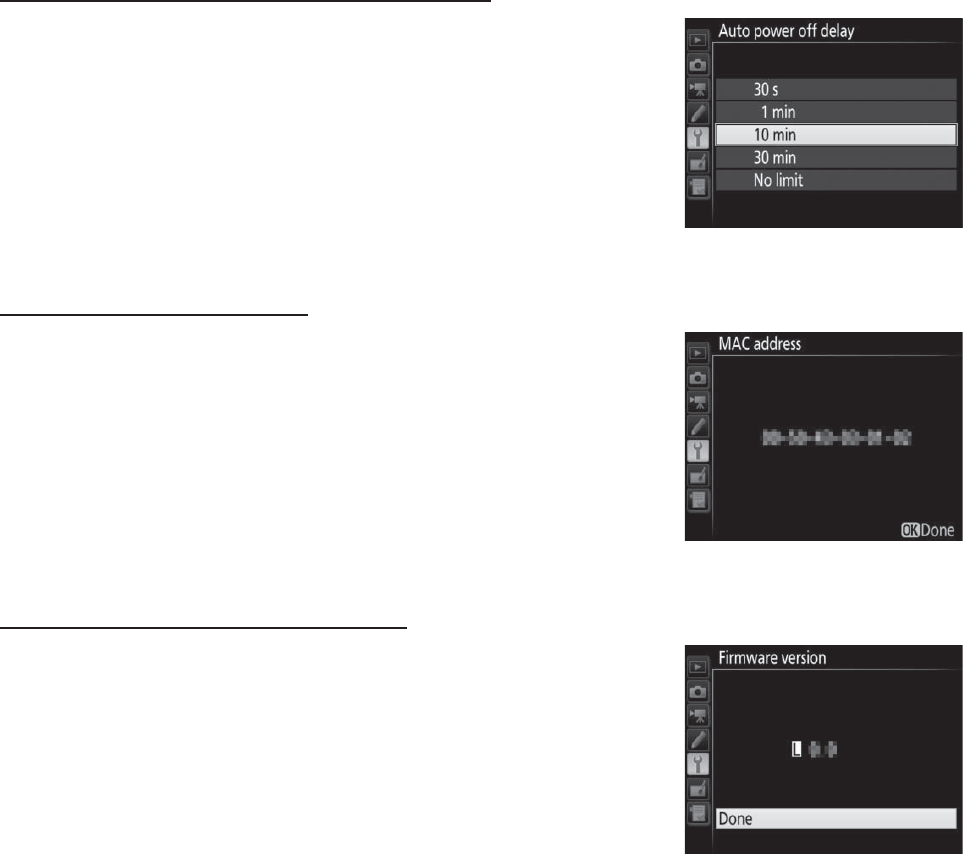
92 Menu Guide
Options
Auto Power off Delay
Choose how long the WT-7 remains on once
the camera has turned off or the USB
connection to the camera is terminated.
MAC Address
Display the MAC address of the hardware
selected for Choose hardware (083).
Firmware Version
View the current WT-7 firmware version.
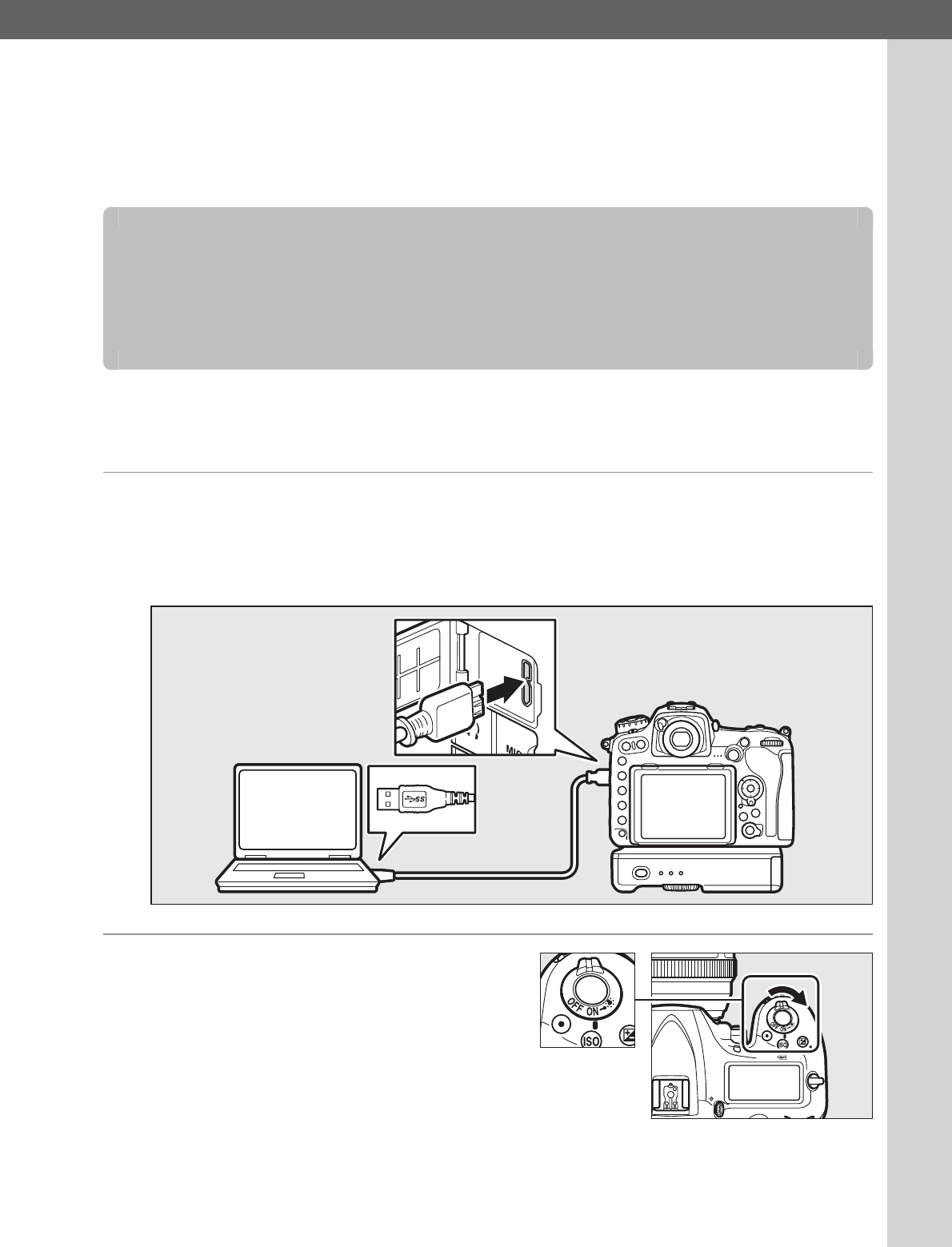
93Appendices
Appendices
The Wireless Transmitter Utility (06) can be used to create
network profiles.
1Connect the camera.
Start the computer and connect the camera using the
supplied USB cable.
2Turn the camera on.
Rotate the power switch to turn
the camera on.
Creating Profiles on a
Computer

94 Appendices
Creating Profiles on a Computer
3Start the Wireless Transmitter Utility.
Double-click the Wireless Transmitter Utility icon on the
desktop (Windows) or click the Wireless Transmitter Utility
icon in the Dock (Mac).
4Create a profile.
Follow the on-screen instructions to create a network profile.
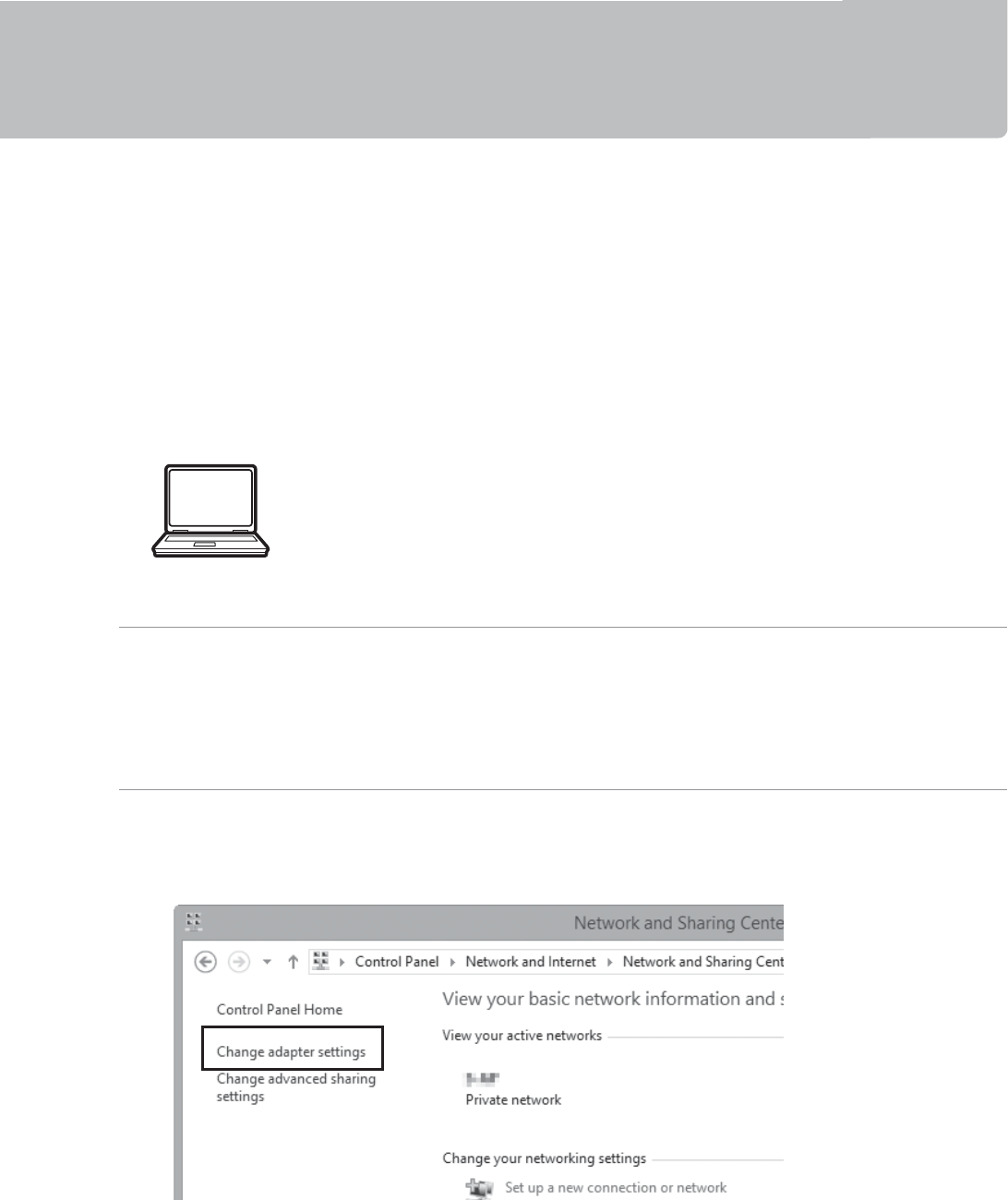
95Appendices
Creating an FTP Server
Creating an FTP Server
Images can be uploaded to ftp servers created using the standard
ftp services included with Windows 10 (Enterprise/Pro/Home),
Windows 8.1, Windows 8.1 (Enterprise/Pro), and Windows 7
(Professional/Enterprise/Ultimate). Under Windows, Internet
Information Services (IIS) are required to configure ftp servers
(installation instructions are available from Microsoft).
The following settings are used below for illustrative purposes:
1Go to Network and Sharing Center.
Click Control Panel > Network and Internet > Network and
Sharing Center.
2Display the network adapter list.
Click Change adapter settings.
IP address: 192.168.1.3
Subnet mask: 255.255.255.0
ftp server port: 21
ftp server
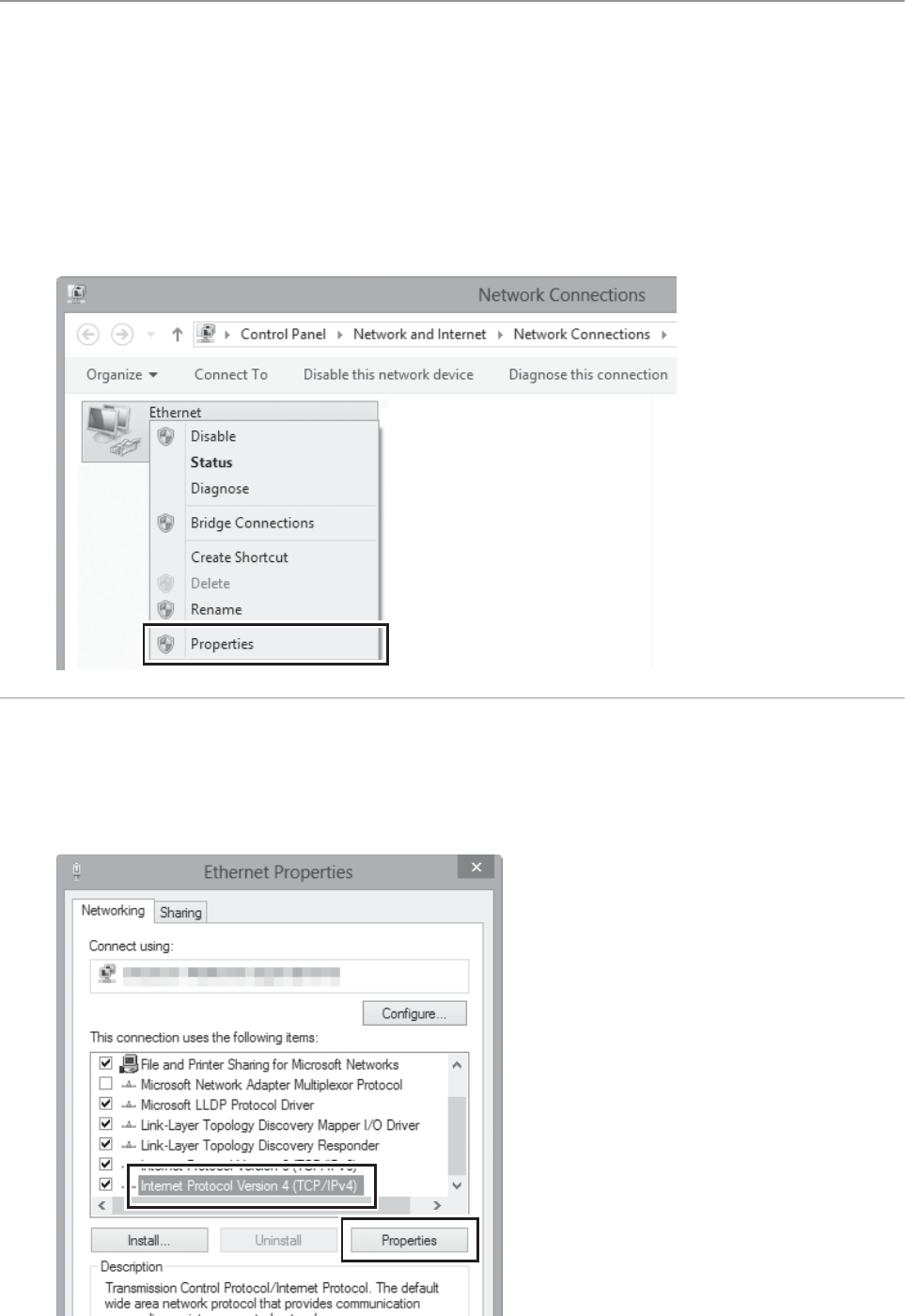
96 Appendices
Creating an FTP Server
3Open the network properties dialog.
If you are connecting via a wireless LAN adapter, right-click
Wi-Fi (Windows 8.1) or Wireless Network Connection
(Windows 7) and select Properties. If you are connecting via
Ethernet, right-click Ethernet (Windows 8.1) or Local Area
Connection (Windows 7) and select Properties.
4Display TCP/IP settings.
Select Internet Protocol Version 4 (TCP/IPv4) and click
Properties.
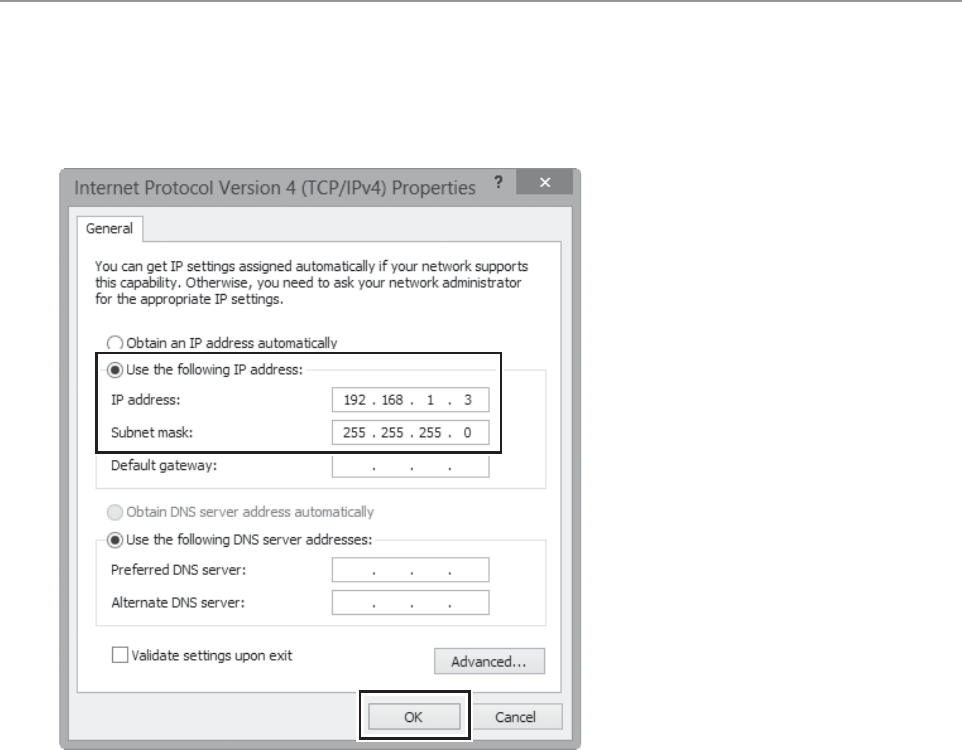
97Appendices
Creating an FTP Server
5Enter an IP address and subnet mask.
Enter an IP address and subnet mask for the ftp server and
click OK.
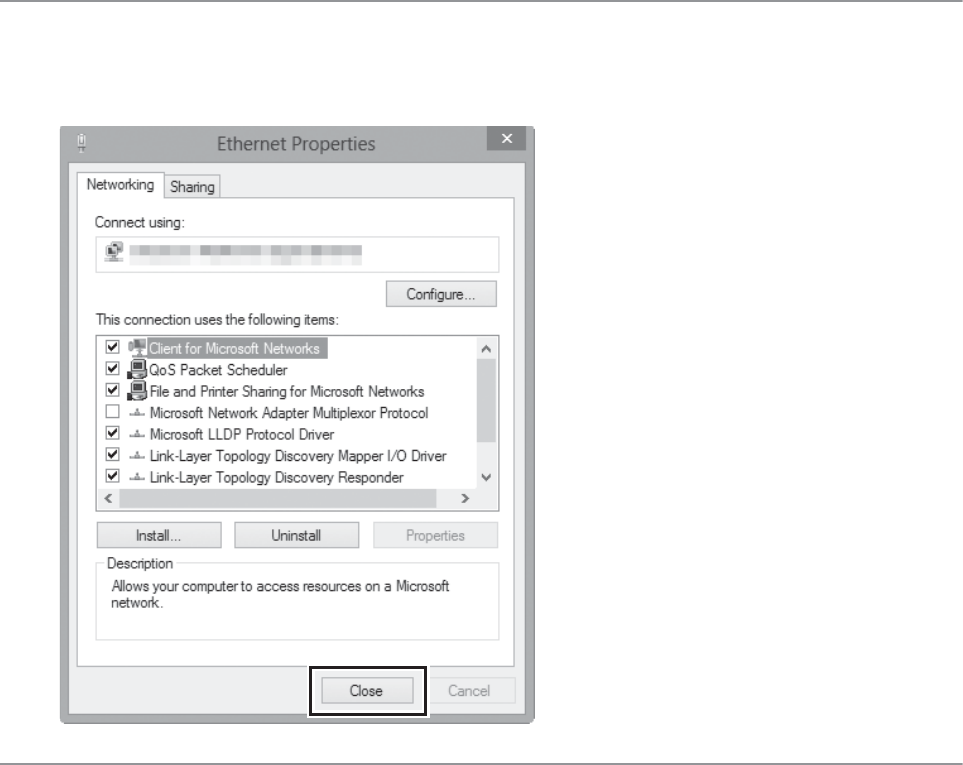
98 Appendices
Creating an FTP Server
6Close the network properties dialog.
Click Close.
7Open Administrative Tools.
Click Control Panel > System and Security > Administrative
Tools.
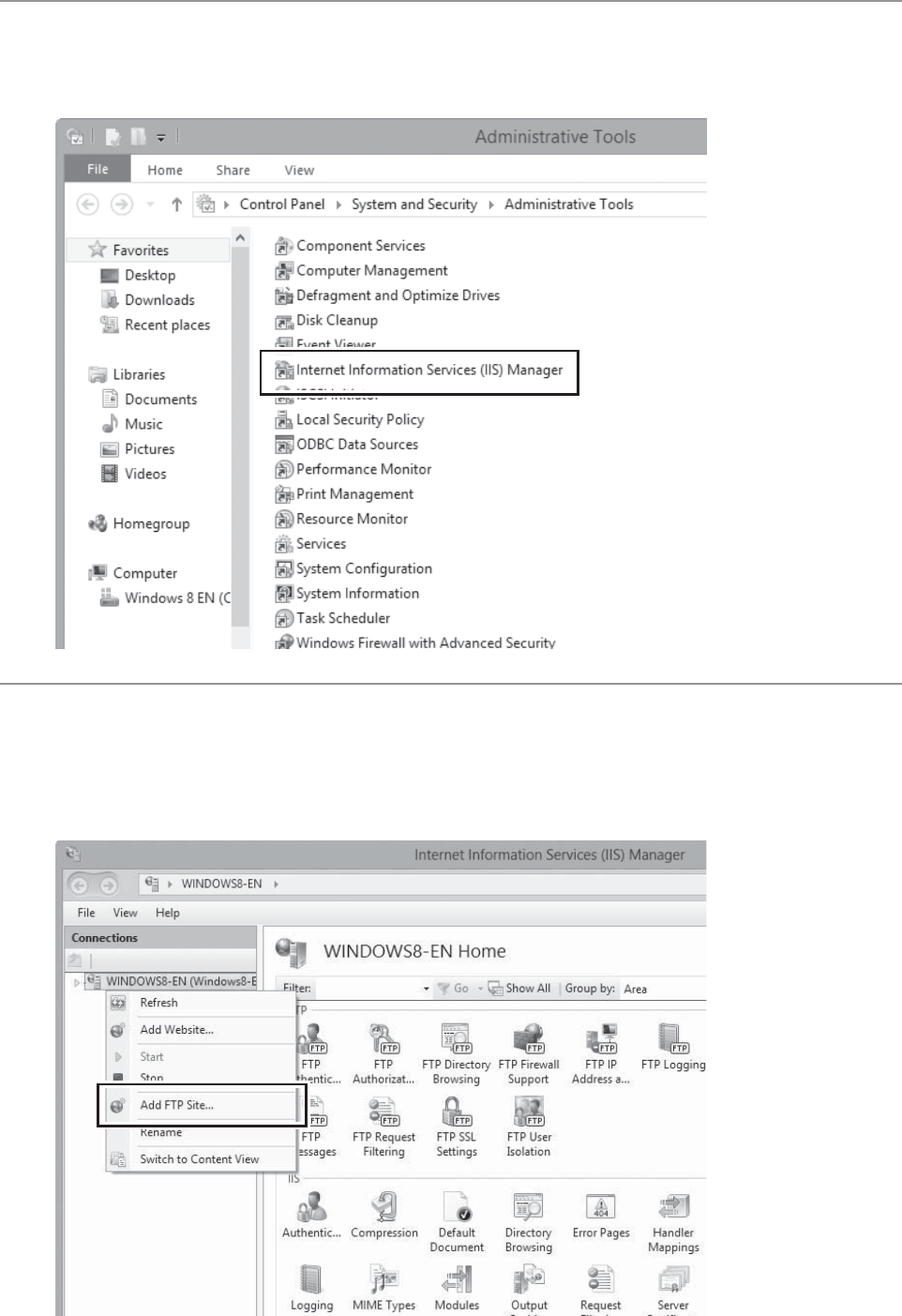
99Appendices
Creating an FTP Server
8Open the IIS manager.
Double-click Internet Information Services (IIS) Manager.
9Select Add FTP Site…
Right-click the computer user name and select Add FTP
Site…
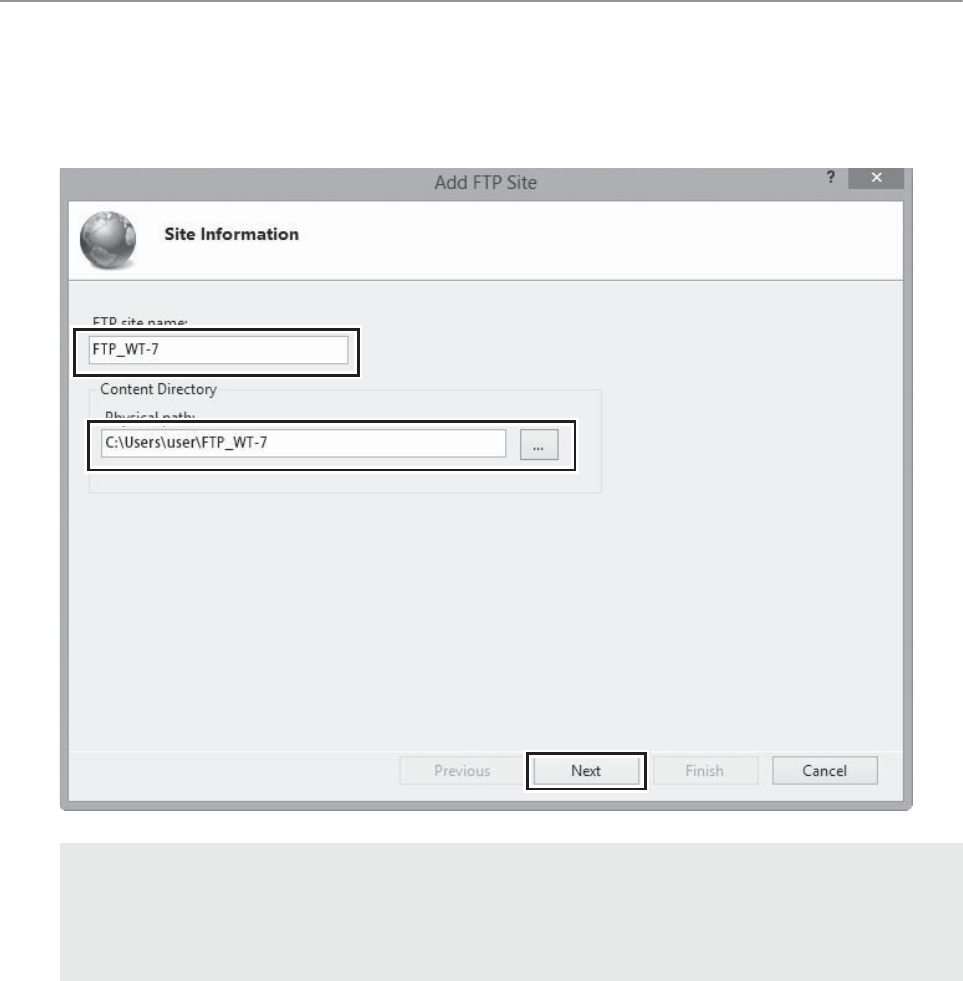
100 Appendices
Creating an FTP Server
10
Enter site information.
Name the site and choose the path to the folder that will be
used for ftp upload. Click Next to proceed.
AAnonymous Login
To allow anonymous login, select a folder in the user’s public folder as
the content directory.
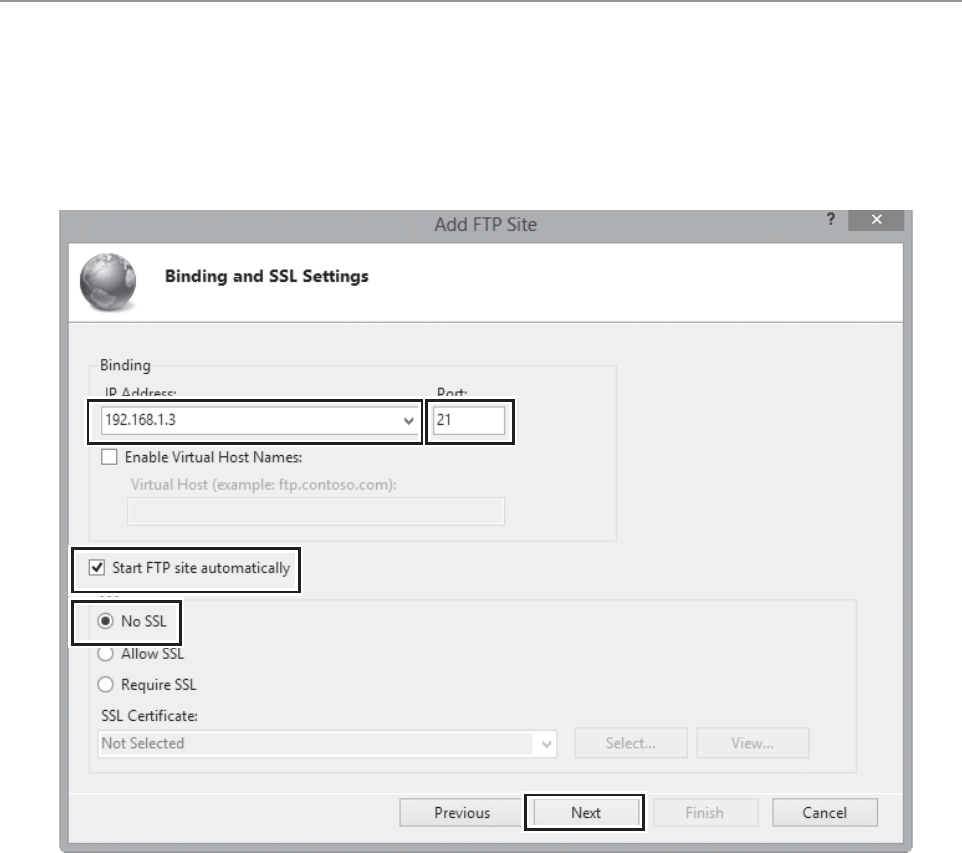
101Appendices
Creating an FTP Server
11
Choose binding and SSL options.
Select the IP address entered in Step 5, note the port number,
select Start FTP site automatically, and check No SSL. Click
Next to proceed.
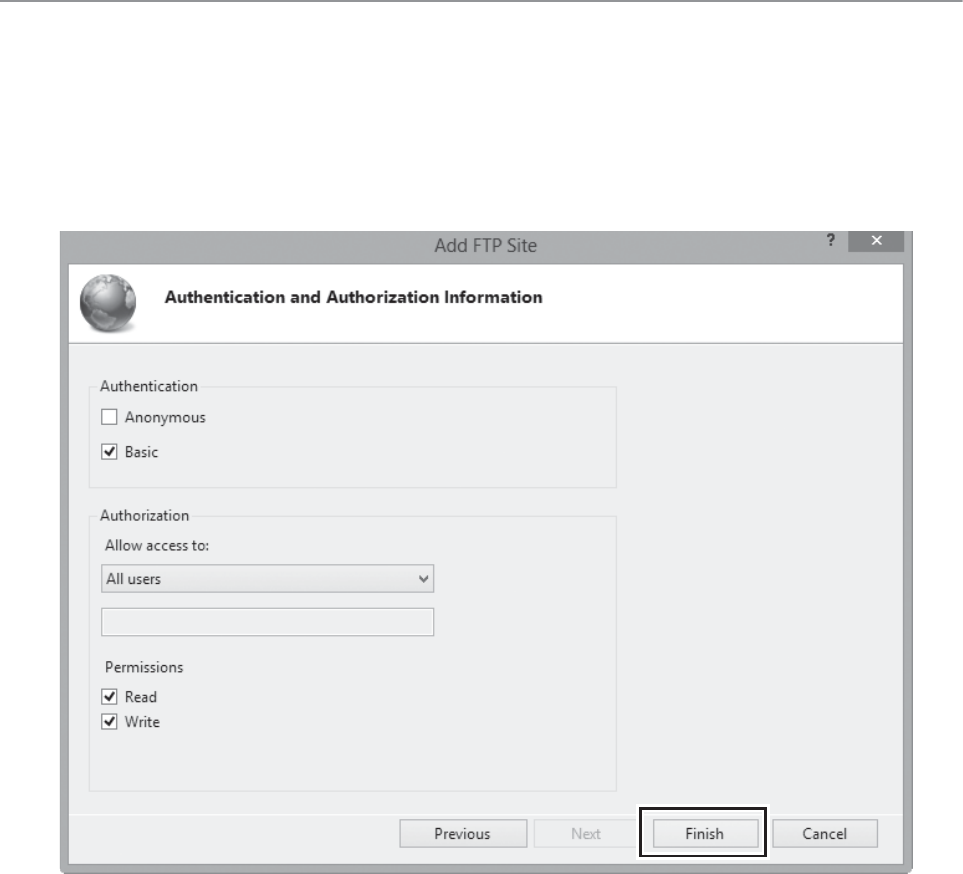
102 Appendices
Creating an FTP Server
12
Choose authentication options.
Adjust settings as described below and click Finish.
•Authentication: Basic
•Allow access to: All users
•Permissions: Read/Write
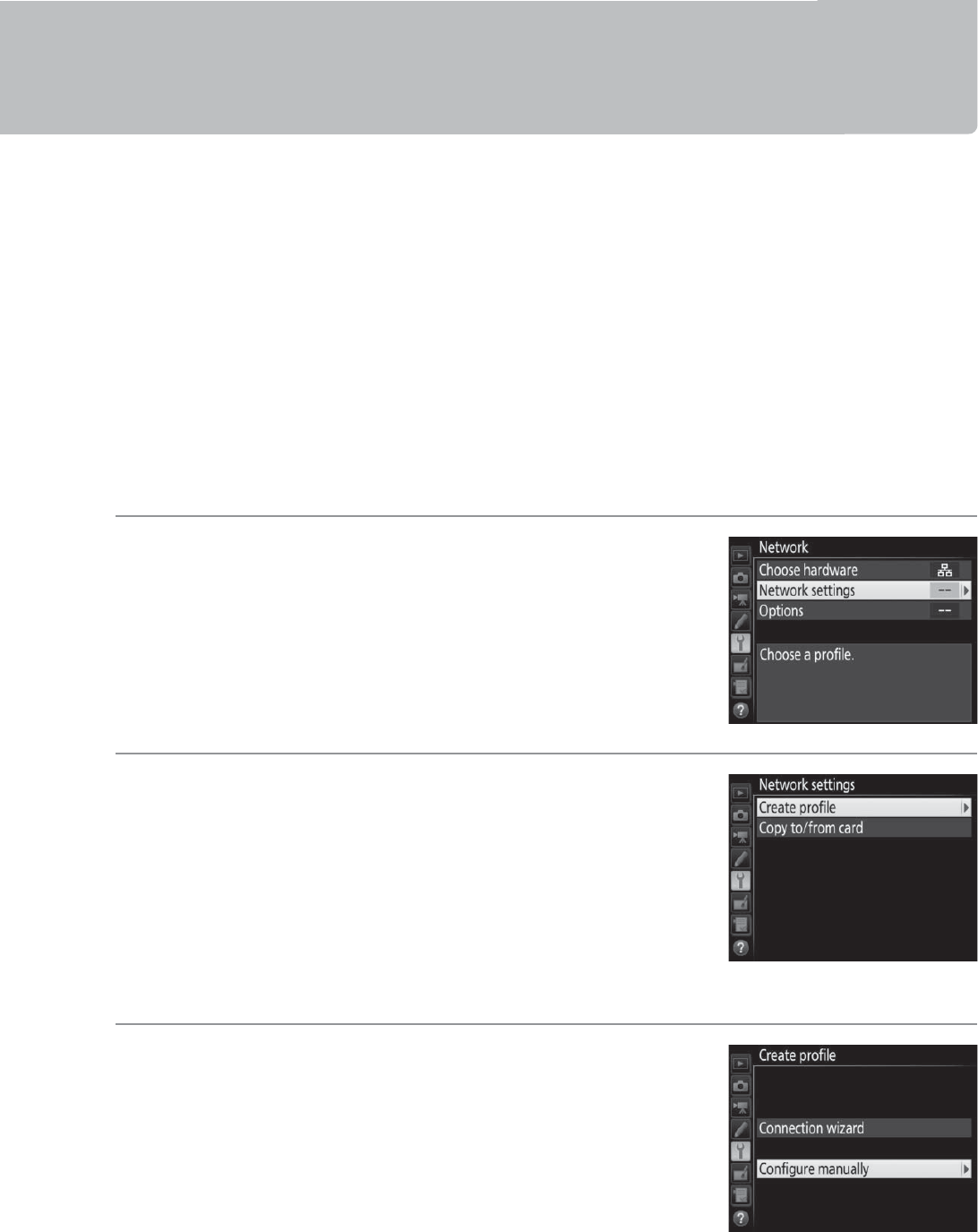
103Appendices
Manual Profile Creation
Manual Profile Creation
Follow the steps below to manually configure the camera for
connection to ftp and http servers. Note that changes to the
current profile will be lost if the camera is turned off during setup;
to prevent unexpected loss of power, use fully-charged batteries
or optional AC adapters designated for use with the camera and
WT-7. If you are connecting to an ftp server behind a firewall, you
may also need to adjust firewall settings to create exceptions for
the ftp ports used by the camera (ports 21, 22, and 32768 through
61000).
1Display network profiles.
In the network menu, highlight Network
settings and press 2 to display the
profiles list and other network settings.
2Select Create profile.
Highlight Create profile and press 2.
Note that if the list already contains nine
profiles, you will need to delete an
existing profile using the O (Q) button
before proceeding (085).
3Select Configure manually.
Highlight Configure manually and press
2.

104 Appendices
Manual Profile Creation
4Select a connection type.
Highlight FTP upload or HTTP server
and press 2.
5Adjust settings.
Adjust settings as described in “Editing
Network Profiles” (086).
DEditing Profiles
If the shutter-release button is pressed while menus are displayed, the
monitor will turn off and any changes to the current profile will be lost.
Choose a longer monitor off delay for Custom Setting in the camera
menus.

105Appendices
Troubleshooting
Troubleshooting
Problem Solution Page
“POWER” LED does not
light.
•Turn the WT-7 on.
•Confirm that the battery is
inserted and fully charged.
11, 20, 59, 66
4, 91
Network option not
available.
Confirm that the WT-7 is
connected and on. 11, 20, 59, 66
Excessive radio
interference.
Adjust the position of the wireless
access point or host computer. —
All LEDs flash at once.
WT-7 hardware or battery
malfunction. Contact a Nikon-
authorized service representative.
—
Camera displays TCP/IP
or FTP error.
•Check settings for host and/or
wireless LAN adapter and adjust
camera settings appropriately.
•Check firewall settings.
•Confirm that you can write to
the destination folder on the ftp
server.
•Highlight the network profile
created with the camera and
press the W (M) button, then
select FTP and choose a
different option for PASV
mode.
10, 18, 58,
65, 86
9
—
88

106 Appendices
Troubleshooting
Camera displays wireless
error.
•Confirm that host and wireless
LAN adapter are on.
•Ensure that there are no
obstacles between WT-7 and
wireless LAN adapter.
•Check settings for host and/or
wireless LAN adapter and adjust
camera settings appropriately.
•In direct (access point) mode,
confirm that the computer or
smart device is not connected
to another network.
—
—
18, 65, 86
—
Camera displays
“Ethernet cable is not
connected”.
Connect Ethernet cable or select
Wireless LAN for Choose
hardware.
11, 59, 83
Memory card error
displayed.
Confirm that memory card is
properly inserted. —
Transfer interrupted
before all photographs
are sent.
Transfer will resume if WT-7 is
turned off and then on again. 11, 20, 59, 66
USB cable disconnected
during transmission.
Reconnect the USB cable.
Do not
turn the camera off. —
No connection is
established when the
camera URL is entered in
a web browser (http
server connections
only).
Confirm that the browser is not
using a proxy connection. 88
Problem Solution Page

107Appendices
Specifications
Specifications
❚❚ Wireless Transmitter WT-7
Ethernet
Standards IEEE802.3ab (1000BASE-T)/IEEE 802.3u (100BASE-
TX)/IEEE 802.3 (10BASE-T)
Data rates *10/100/1000 Mbps with auto detect
Port 1000BASE-T/100BASE-TX/10BASE-T (AUTO-MDIX)
Wireless
Standards WT-7/WT-7A/WT-7B/WT-7C: 802.11a/b/g/n/ac
Communications
protocols
IEEE802.11a: OFDM
IEEE802.11g: OFDM
IEEE802.11b: DSSS
IEEE802.11n: OFDM
IEEE802.11ac: OFDM
Operating frequency
(MHz)
WT-7
: 5180
–
5320 MHz (36/40/44/48/52/56/60/64 ch)
5500–5700 MHz (100/104/108/112/116/120/124/
128/132/136/140 ch)
2412–2472 MHz (1–13 ch)
WT-7A: 5180–5320 MHz (36/40/44/48/52/56/60/
64 ch)
5745–5825 MHz (149/153/157/161/165 ch)
2412–2462 MHz (1–11 ch)
WT-7B: 5180–5320 MHz (36/40/44/48/52/56/60/
64 ch)
2412–2472 MHz (1–13 ch)
WT-7C: 5745–5825 MHz (149/153/157/161/165 ch)
2412–2472 MHz (1–13 ch)
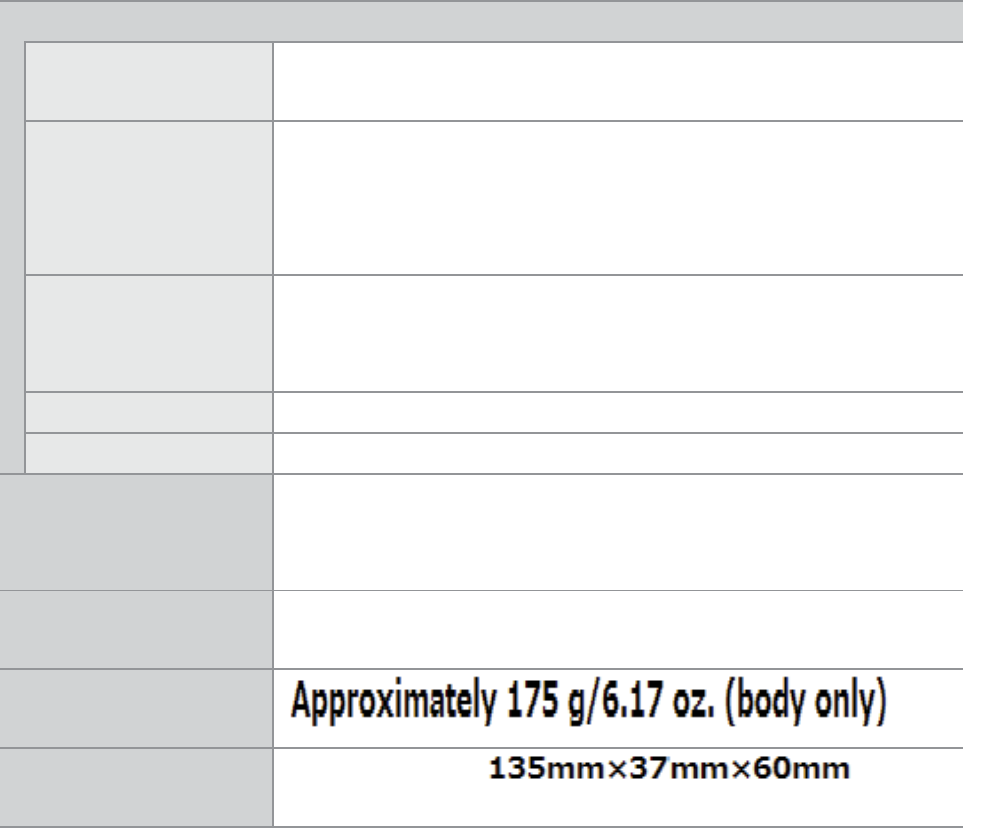
108 Appendices
Specifications
* Maximum logical data rates according to IEEE standard. Actual rates
may differ.
† With large antenna at wireless LAN access point.
Range may vary with
signal strength and presence or absence of obstacles.
•Nikon reserves the right to change the appearance and specifications of
the hardware and software described in this manual at any time and
without prior notice. Nikon will not be held liable for damages that may
result from any mistakes that this manual may contain.
Wireless
Approximate range
(line of sight) †Approximately 200 m (656.1 ft)
Data rates *
IEEE 802.11a/g: 6, 9, 12, 18, 24, 36, 48 and 54 Mbps
IEEE 802.11b: 1, 2, 5.5 and 11 Mbps
IEEE 802.11n: 300 Mbps maximum
IEEE802.11ac: 866.7 Mbps maximum
Security
Authentication: Open system, shared key, WPA-PSK,
WPA2-PSK
Encryption: 128/64 bit WEP, TKIP, AES
Wireless setup Supports WPS2.0
Access protocols Infrastructure and access point modes
Power source
Rechargeable EN-EL15 Li-ion battery ×1 (available
separately), EP-5B power connector and EH-5b AC
adapter (available separately)
Operating environment Temperature: 0 °C–40 °C (32 °F–131 °F)
Humidity: 85% or less (no condensation)
Weight Approximately ### g/### oz. (including battery)/
Approximately ### g/### oz. (body only)
Dimensions (W × H × D) Approximately ### mm × ### mm × ### mm
(###in. × ### in. × ### in.)
(###in. × ### in. × ### in.
)

109Appendices
Specifications
ABattery Life
The length of time batteries can be used and the number of shots that
can be uploaded before recharging varies with the condition of the
batteries, signal strength, and how camera and WT-7 are used.
The
following measurements were performed using a fully-charged
EN-EL15 battery (1,900 mAh) at a temperature of 23 °C (73.4 °F) while
continuously uploading images with an average file size of
## megabytes (equivalent to a large normal-quality JPEG image taken
with the D500) to an ftp server configured using Internet Information
Services (IIS) under Windows 8.1 over an infrastructure network with the
WT-7 in FTP upload mode (all figures are approximate).
Network Wireless (802.11ac) Ethernet (1000BASE-TX)
No. of shots uploaded #,### ##,###
Battery life ### min. (# hr.) ### min. (# hr.)
To ensure maximum battery performance:
•Keep the battery contacts clean. Soiled contacts can reduce battery
performance.
•Use EN-EL15 batteries immediately after charging. Batteries will lose
their charge if left unused.
•Periodically check the battery level using Network > Options >
Battery info.
•The battery level displayed by the camera may vary with changes in
temperature.
•A sharp drop in the length of time the battery can hold a charge
indicates that the battery must be replaced.

110 Appendices
Index
Index
Symbols
a: “Send” ............................................. 35, 81
b: “Sending” ....................................... 35, 81
c: “Sent”............................................... 35, 81
A
Access point ....................23, 28, 65, 69, 74
Android OS ................................................. 45
Attachment wheel................................. 2, 5
Authentication .......................................... 87
Auto power off delay ..........................6, 92
Auto send...................................... 33, 80, 89
B
Battery info................................................. 91
C
Camera control........................8, 10, 18, 37
Camera Control Pro 2.............................. 37
Channel..........................................xi, 87, 107
Choose hardware ..........12, 21, 60, 67, 83
Communication mode ........................... 87
Connection type...................................8, 84
Connection wizard...............13, 22, 61, 68
Copy to/from card.................................... 85
Copyright information ........................... 51
Create profile ..................13, 22, 61, 68, 84
D
Delete after send?.................................... 89
Deselect all? ............................................... 91
Direct (access point)............23, 28, 69, 74
DNS................................................................ 88
Domain Name Server (DNS)................. 88
E
Encryption .................................................. 87
Encryption key .......................................... 87
Errors...........................................................105
Ethernet............................................2, 9, 106
Ethernet cable .................................... 11, 59
F
File names.............................................36, 82
Firewall............................................................ 9
Firmware version.......................................92
Folders ............................................34, 64, 77
FTP server ................................... 58, 95, 103
FTP upload ............................... 8, 58, 65, 78
G
Gateway .......................................................88
H
HTTP server..............8, 10, 18, 40, 45, 103
HTTP user settings....................................91
I
Image comment........................................51
Image transfer................................ 8, 10, 32
Infrastructure.......................................19, 65
iOS ..................................................................45
IP address.........................14, 29, 62, 75, 88
iPhone...........................................................53
IPTC information .......................................52
K
Key index......................................................87
M
Mac.................................................................45
MAC address.................................29, 76, 92
Memory card ............ iv, 11, 20, 59, 66, 85
Menus ...........................................................83
Mode ............................................................... 8
N
Network........................................................83
Network settings. 13, 22, 61, 68, 84, 103
Network Status .....................35, 38, 44, 81
O
Options.........................................................89
Overwrite If same name .........................90

111Appendices
Index
P
Pairing ...........................................................16
Password protection................................86
PASV mode ..................................................88
PIN-entry WPS.......................23, 27, 69, 73
Port number........................ 9, 88, 101, 103
Power saving...............................................91
Profile name.............14, 23, 62, 69, 84, 86
Protect If marked for upload.................90
Proxy server.................................................88
Push-button WPS.................23, 26, 69, 72
R
Routers..............................................9, 15, 29
S
Search for wireless network ...23, 24, 69,
70
Send file as...................................................89
Send folder ..................................................90
Send marking .............................................90
SSID.............................24, 28, 70, 74, 84, 87
Status LEDs.......... 2, 3, 35, 38, 44, 81, 105
T
TCP/IP ............................................................88
Text edit window................................50, 57
The Shooting Window......................46, 53
The Viewer Window ..........................48, 55
U
USB cable ...................................................3, 5
W
Windows 10..........................................45, 95
Windows 7............................................45, 95
Windows 8.1.........................................45, 95
Wireless LAN ...............................................87
Wireless LAN access point.19, 24, 65, 70
Wireless Transmitter Utility. 6, 16, 31, 93

Printed in Japan
SB5L01(11)
6MWA5511-01
No reproduction in any form of this manual, in whole or in part (except for
brief quotation in critical articles or reviews), may be made without written
authorization from NIKON CORPORATION.